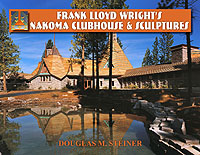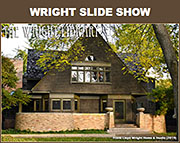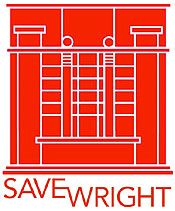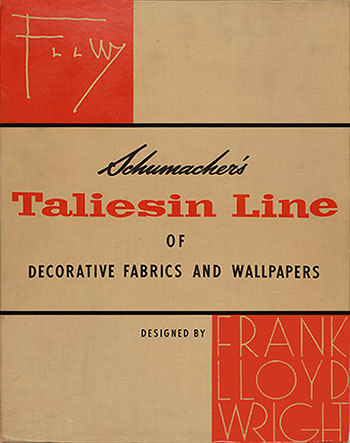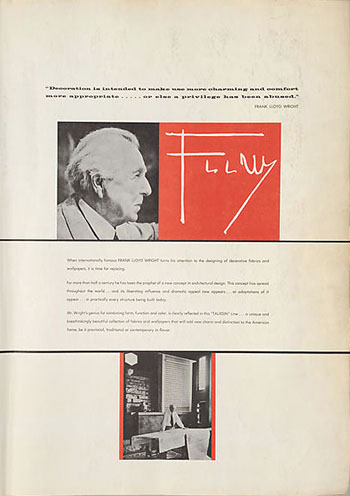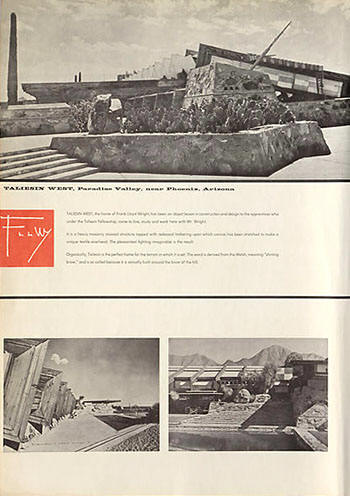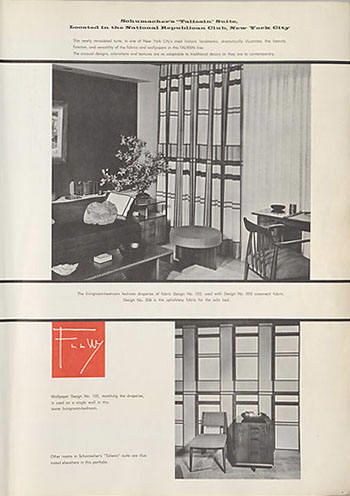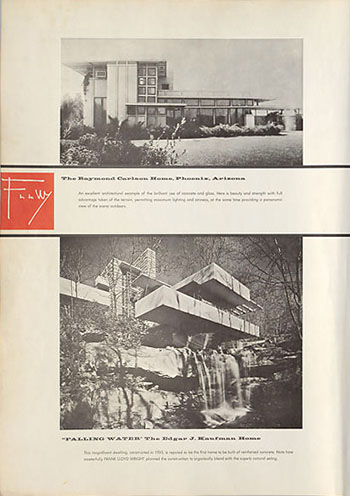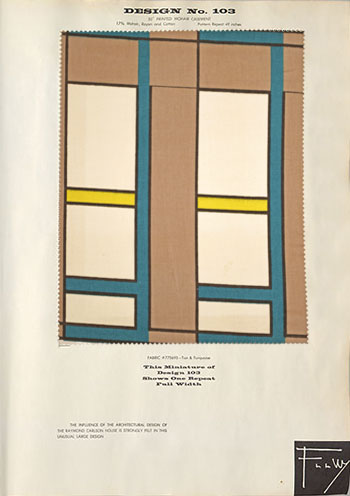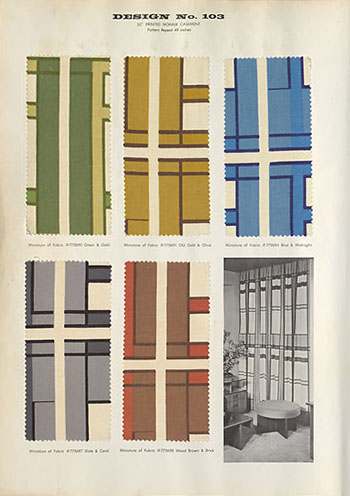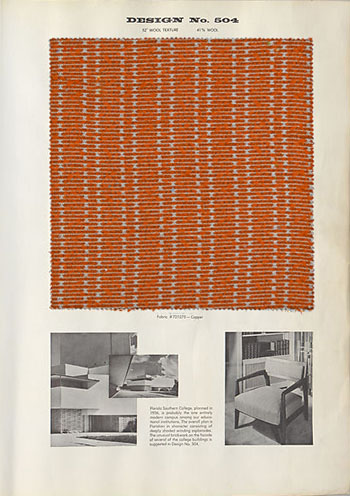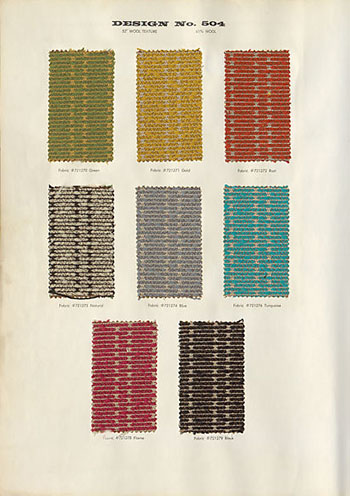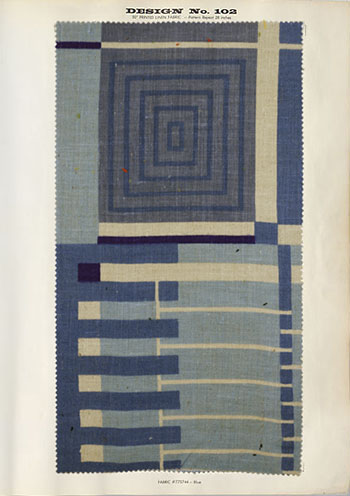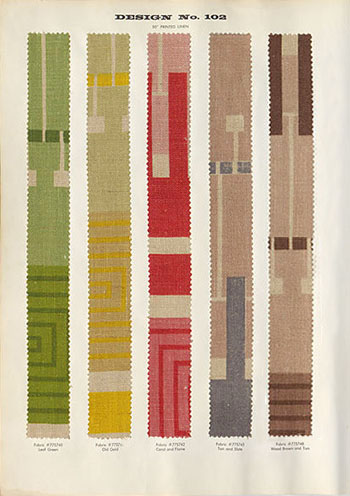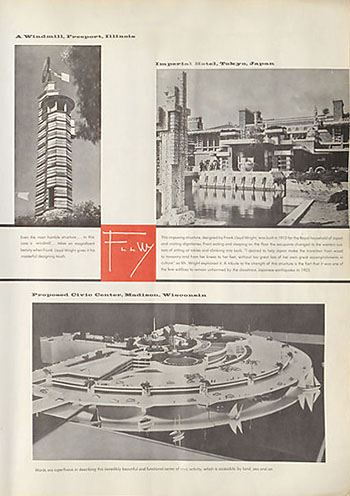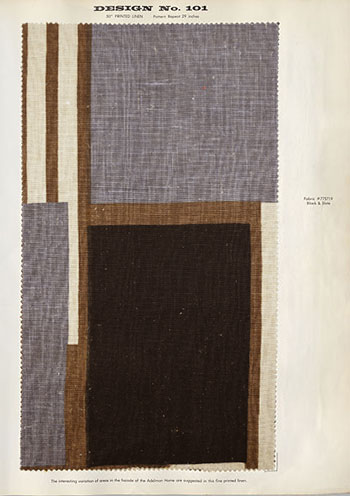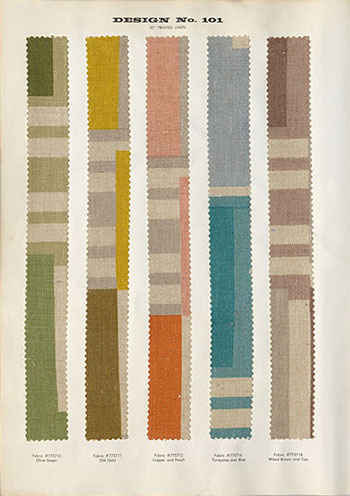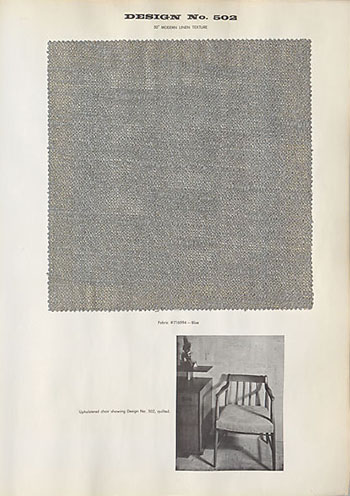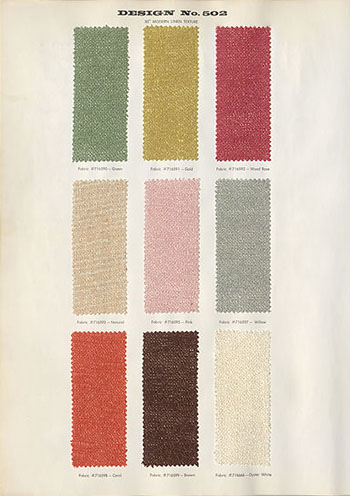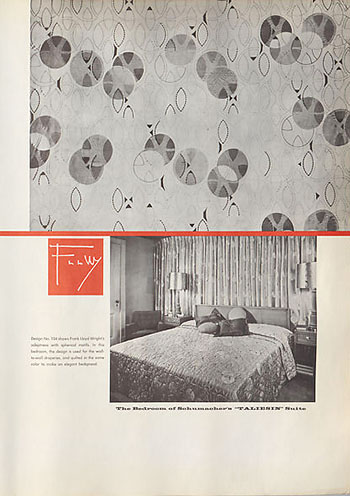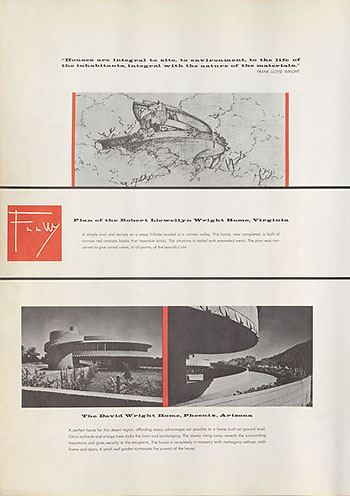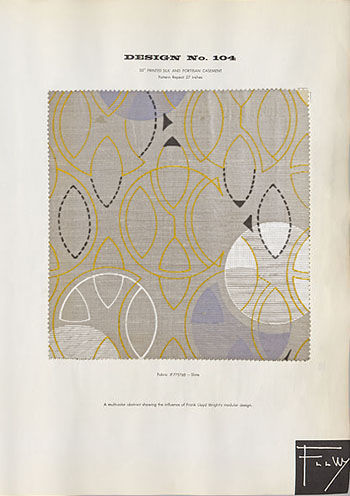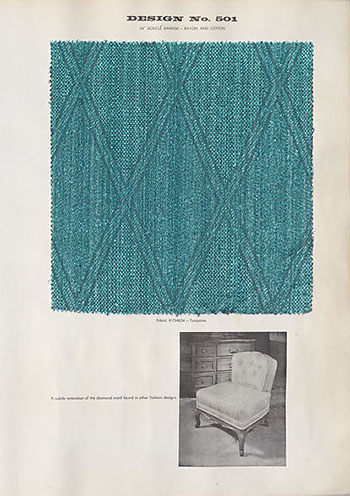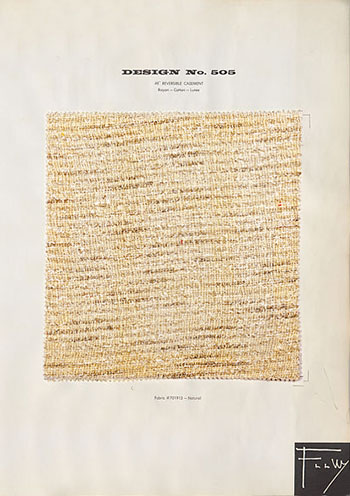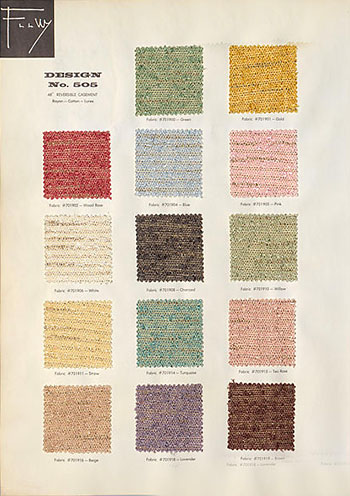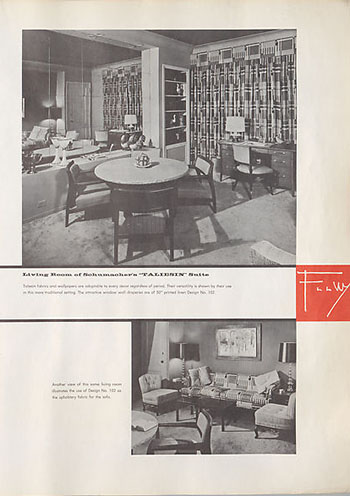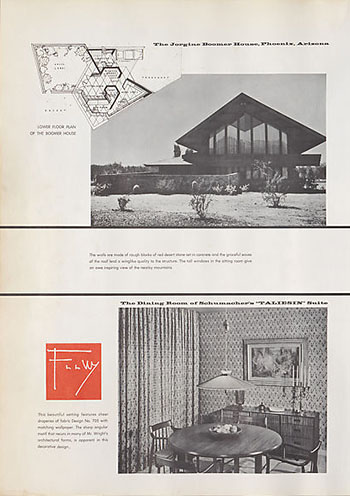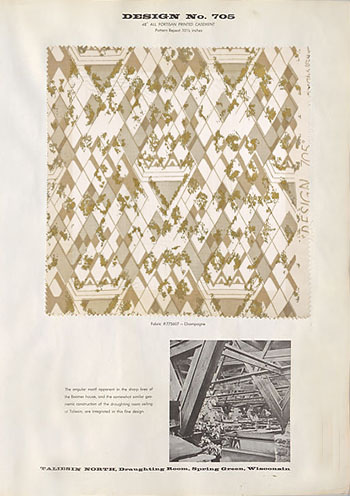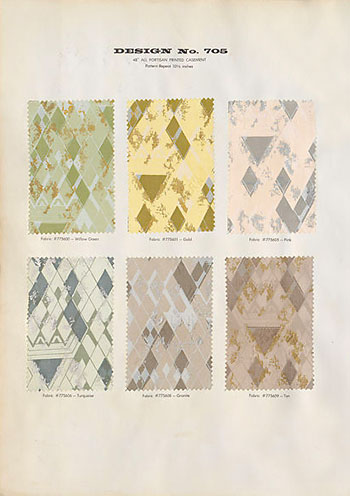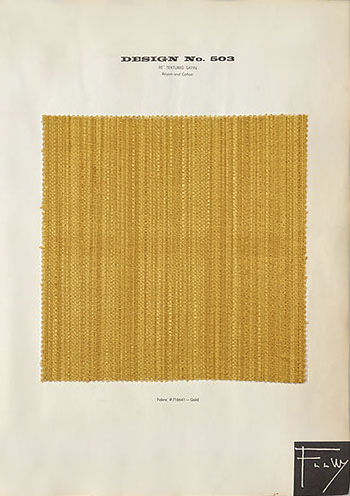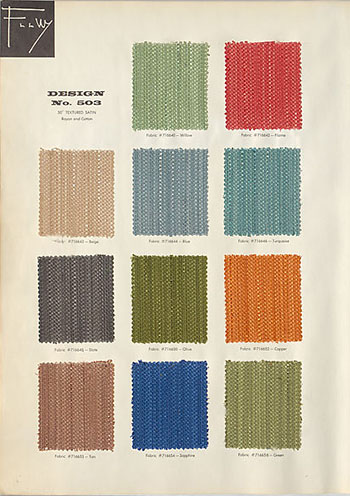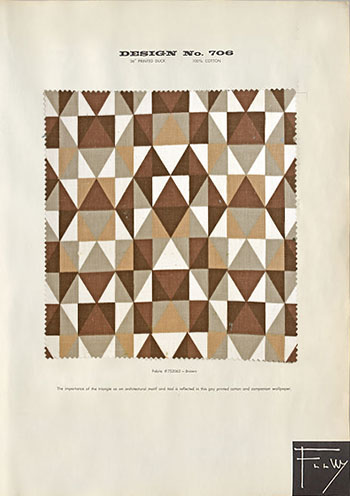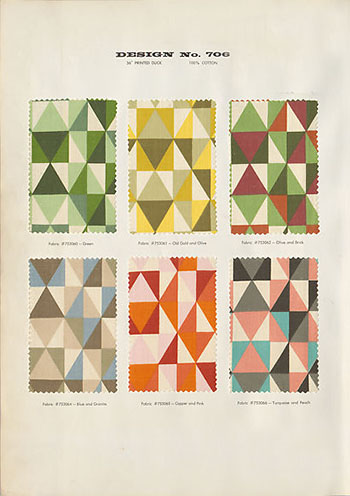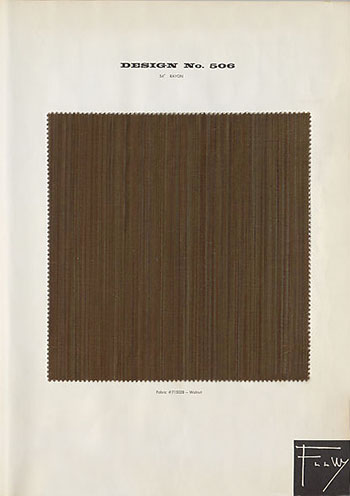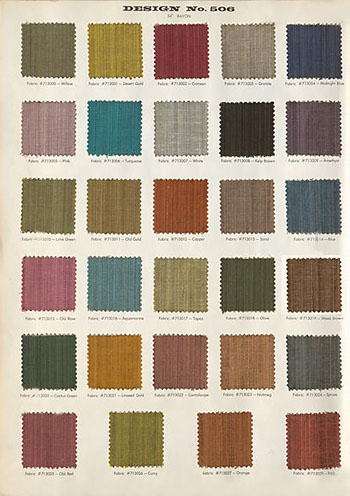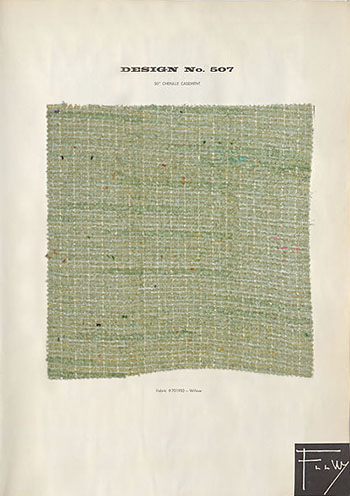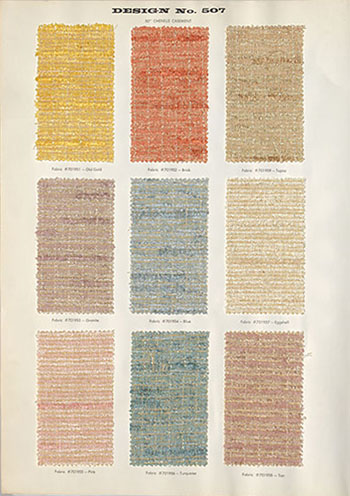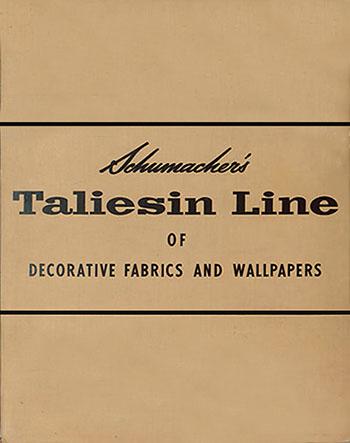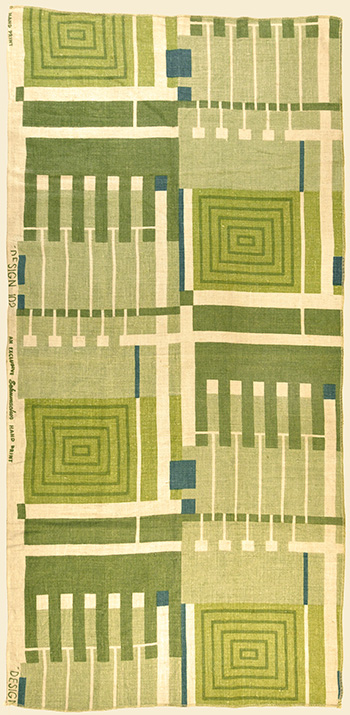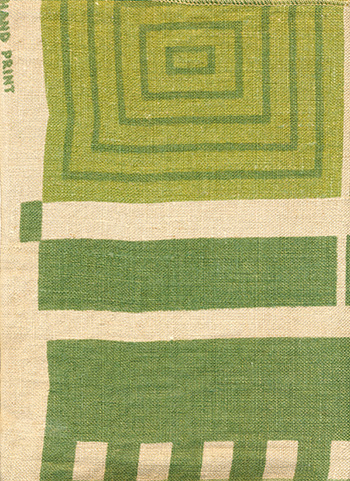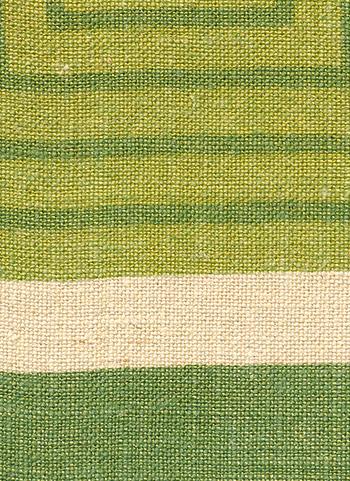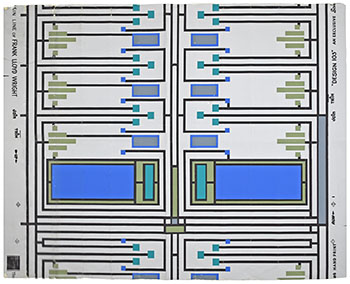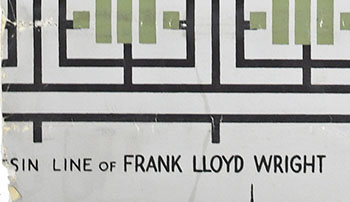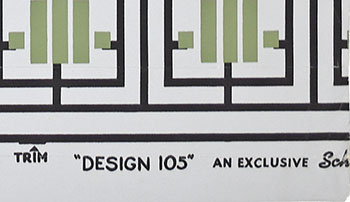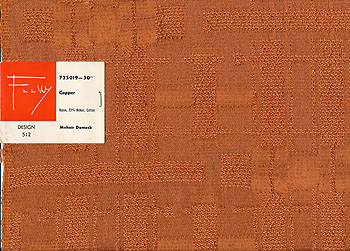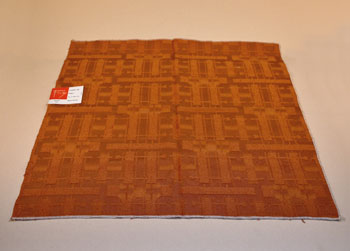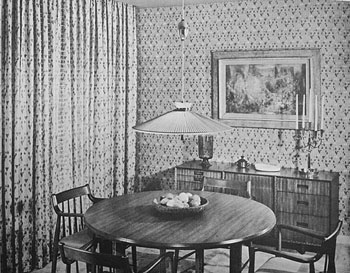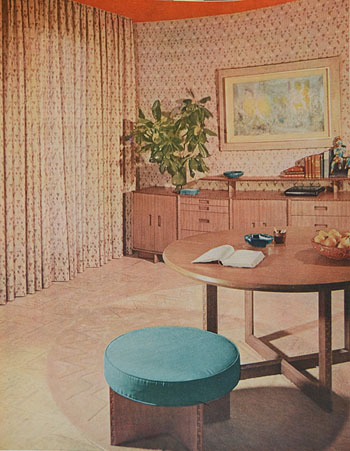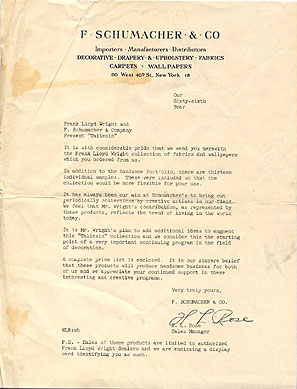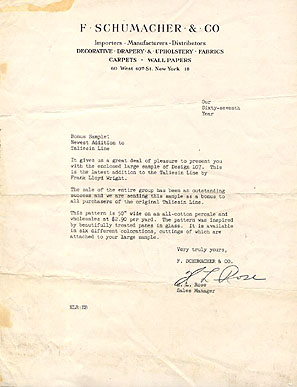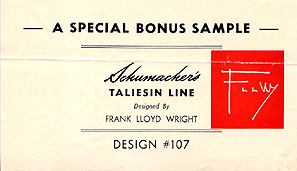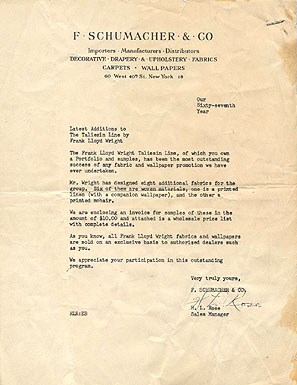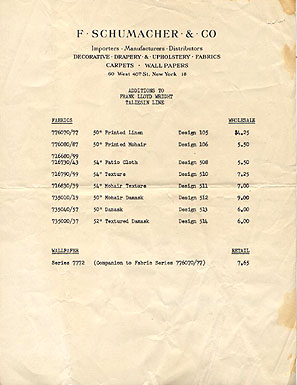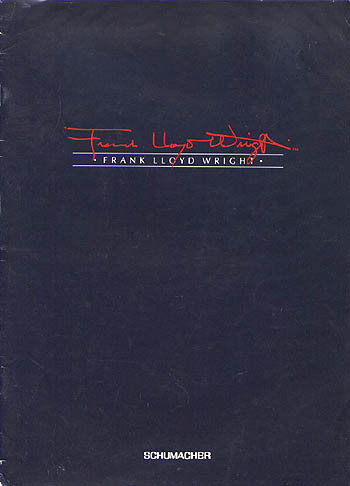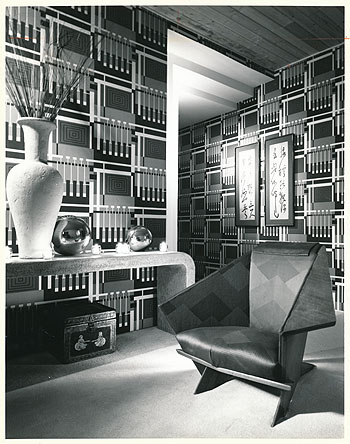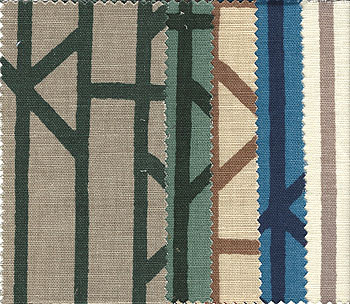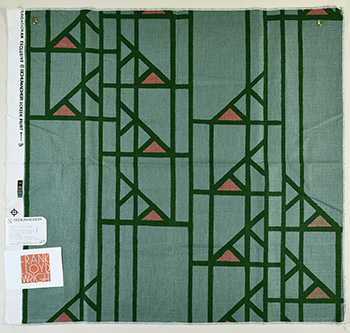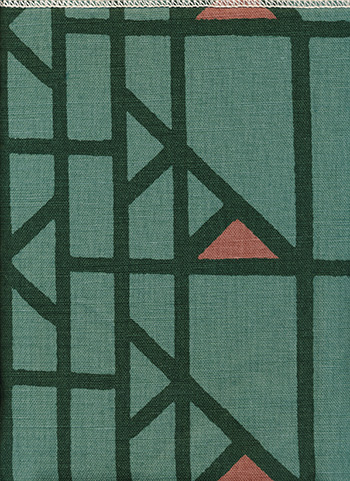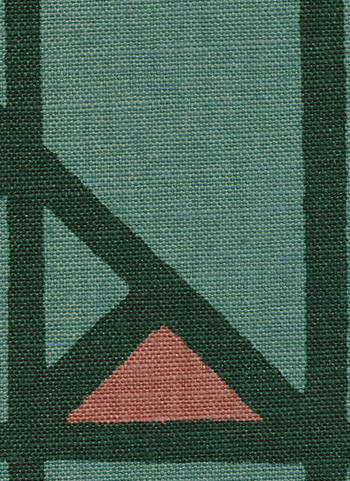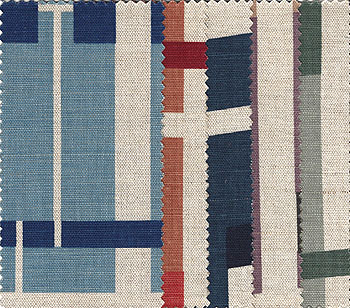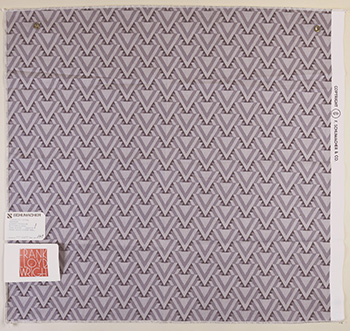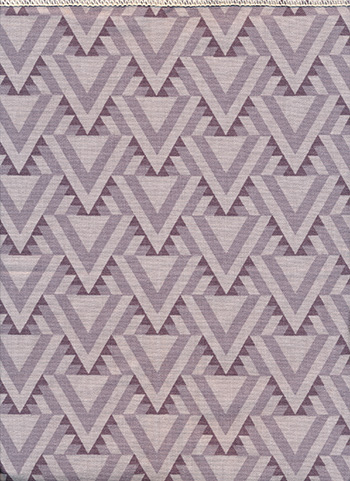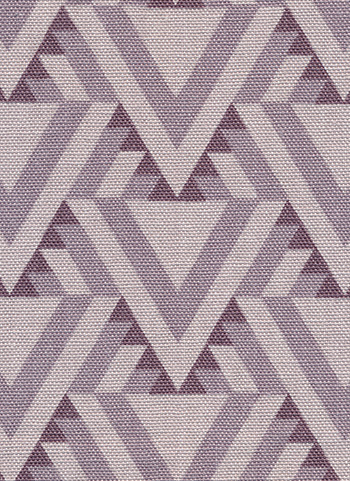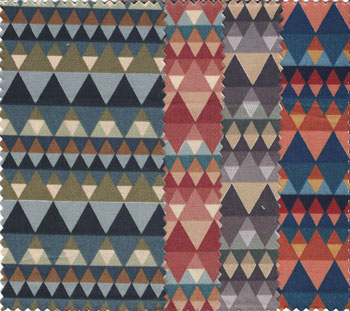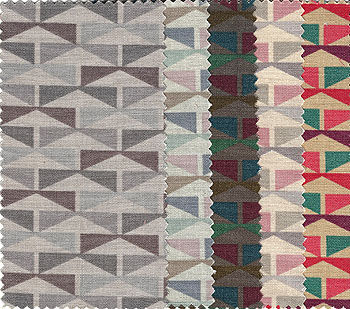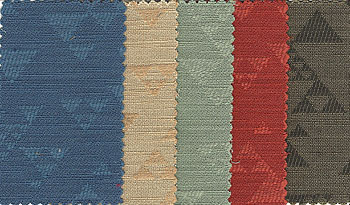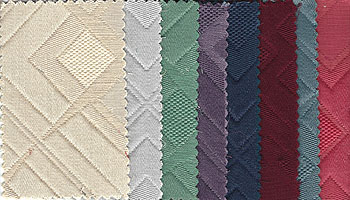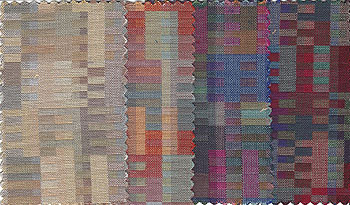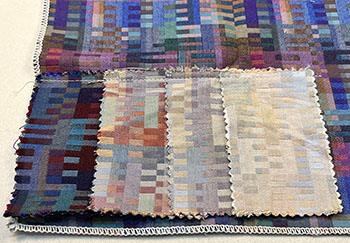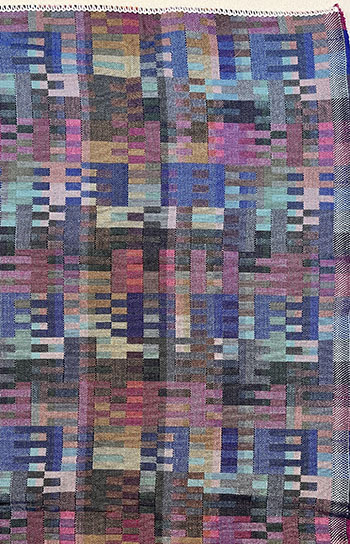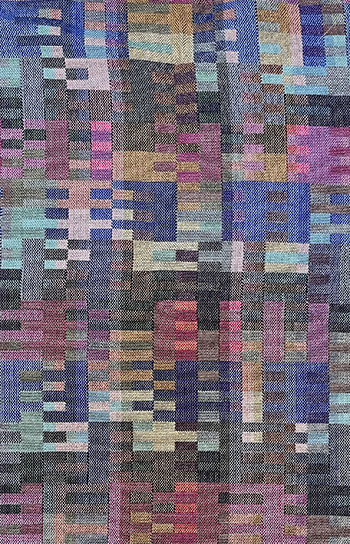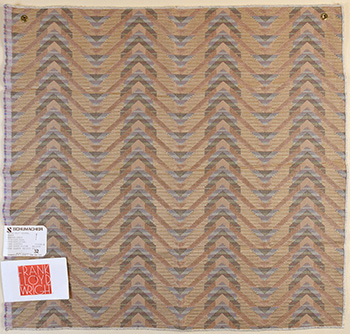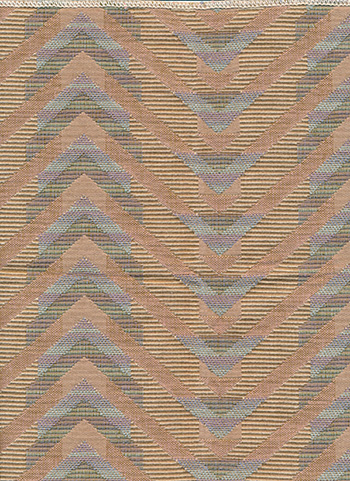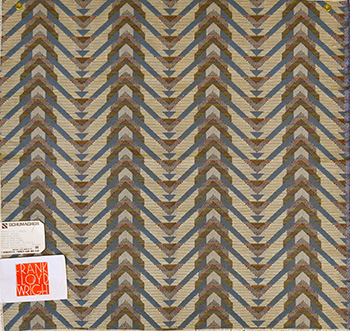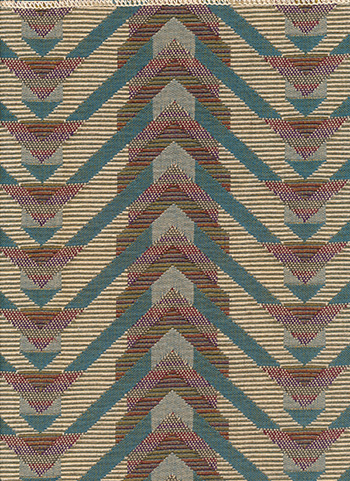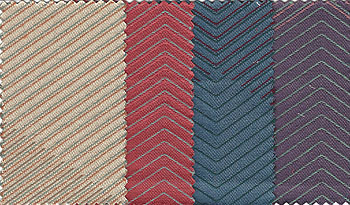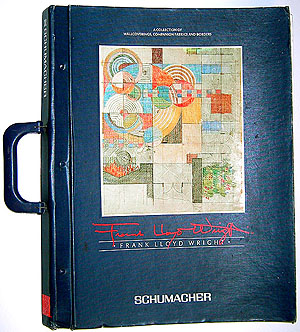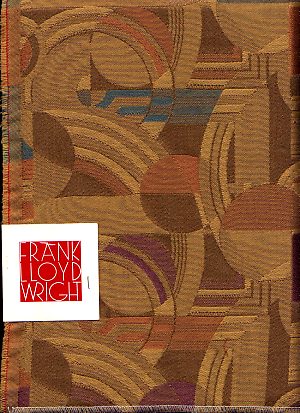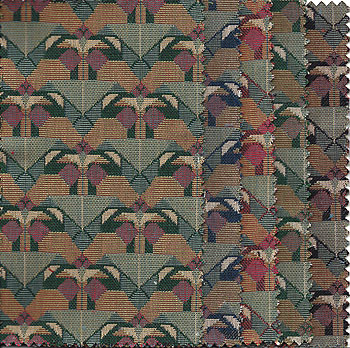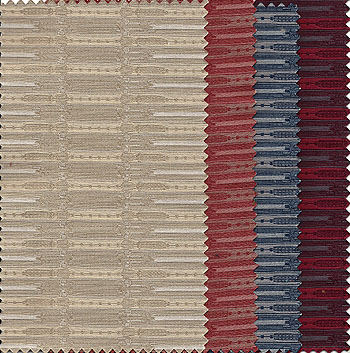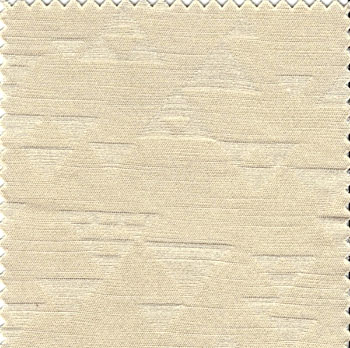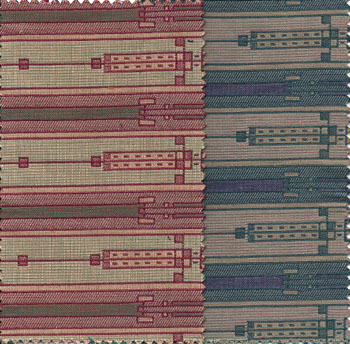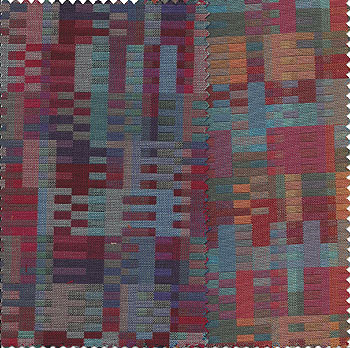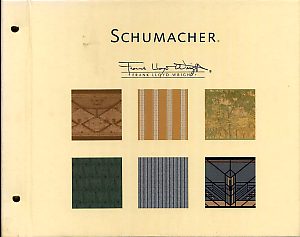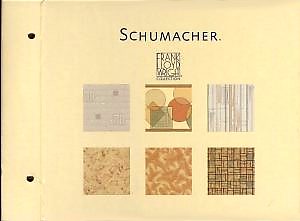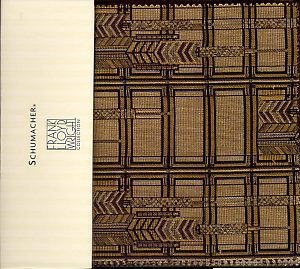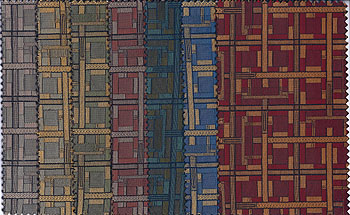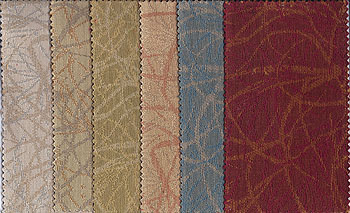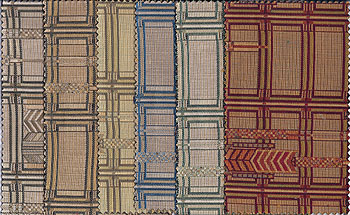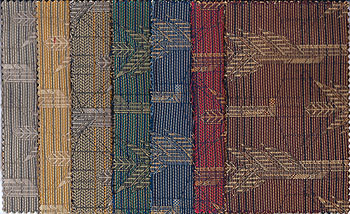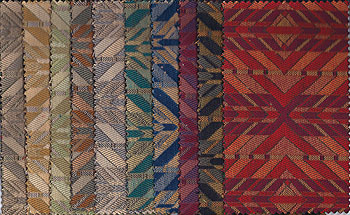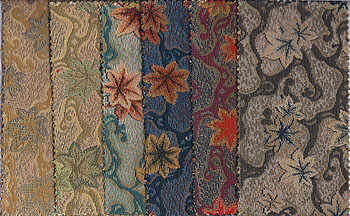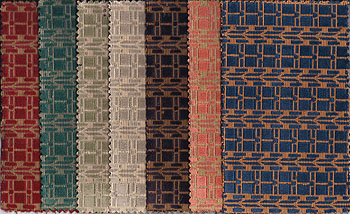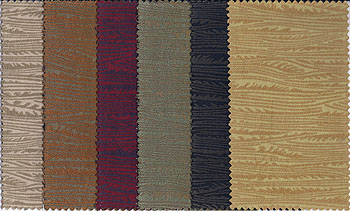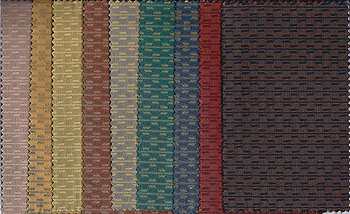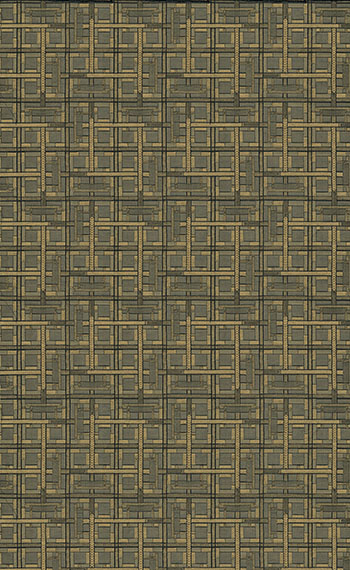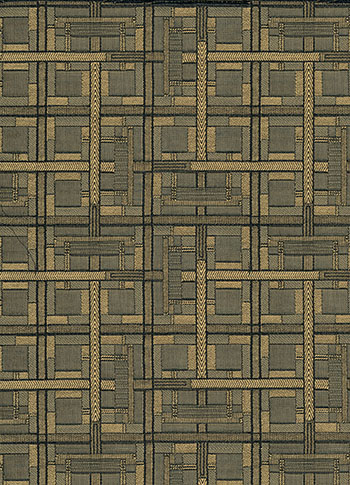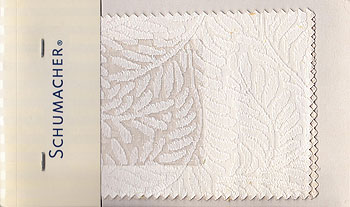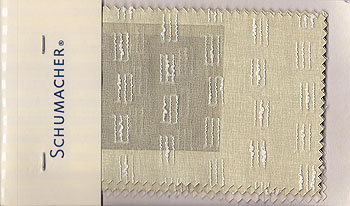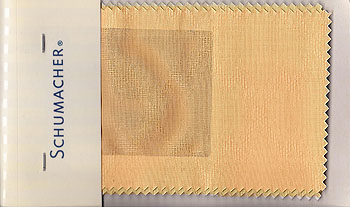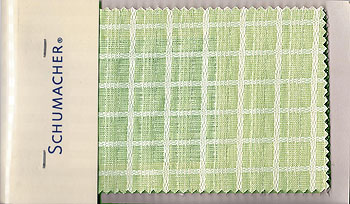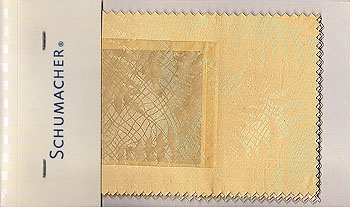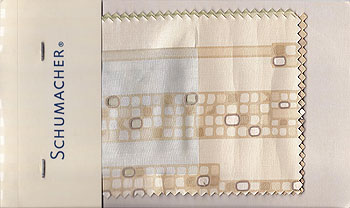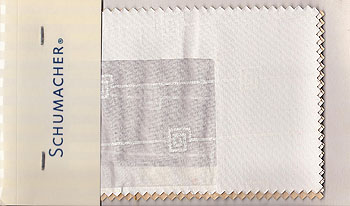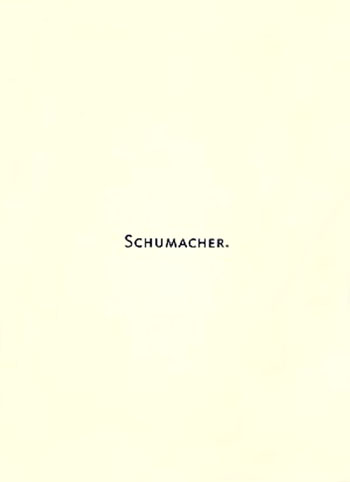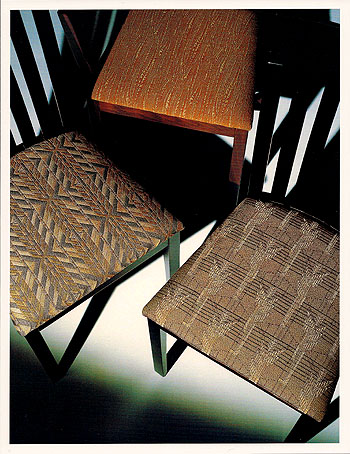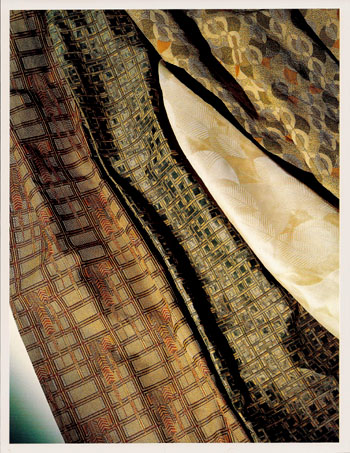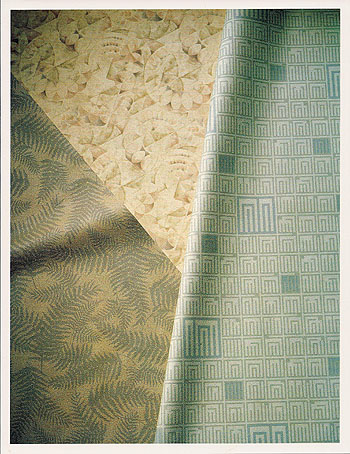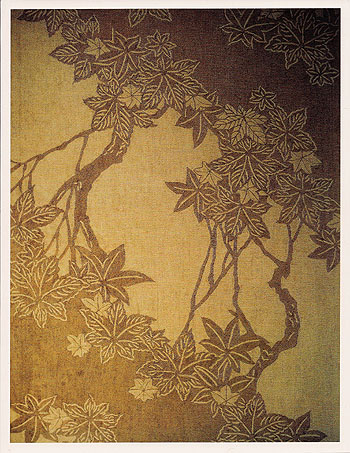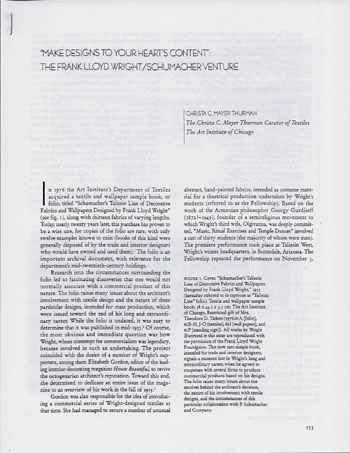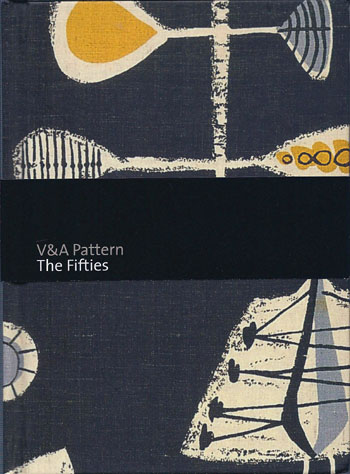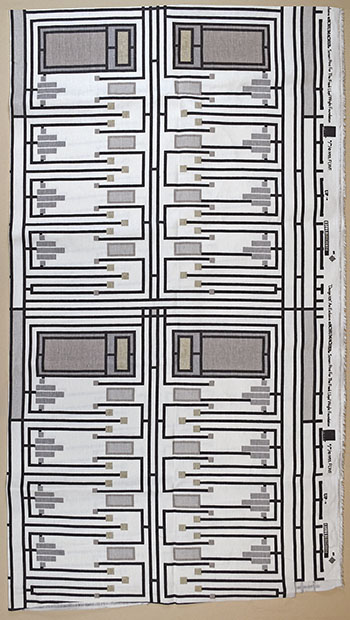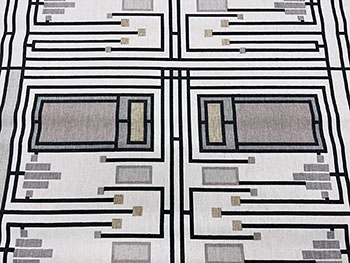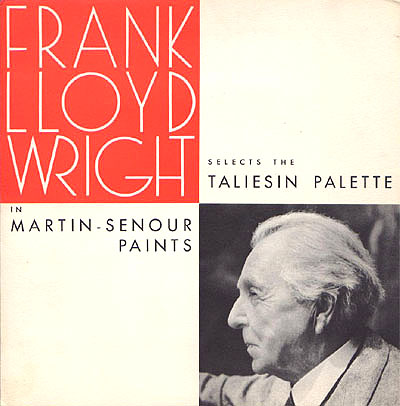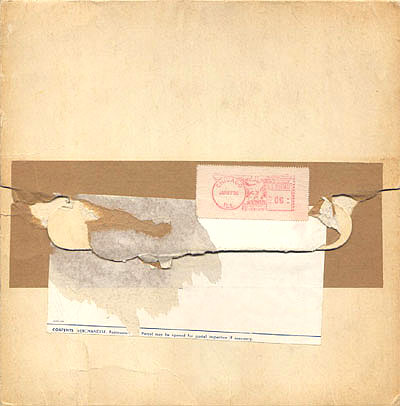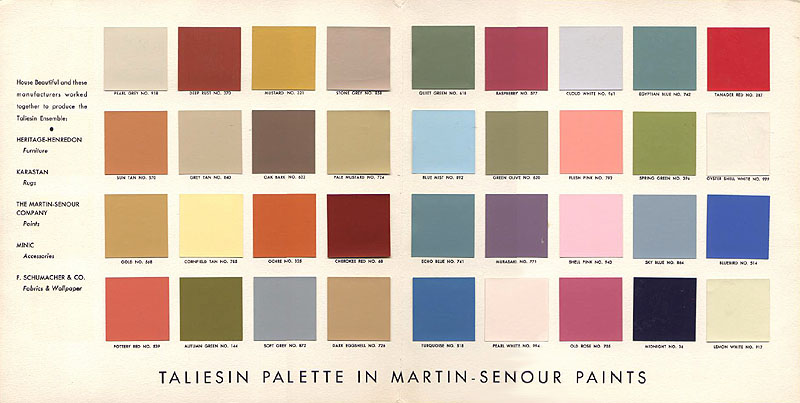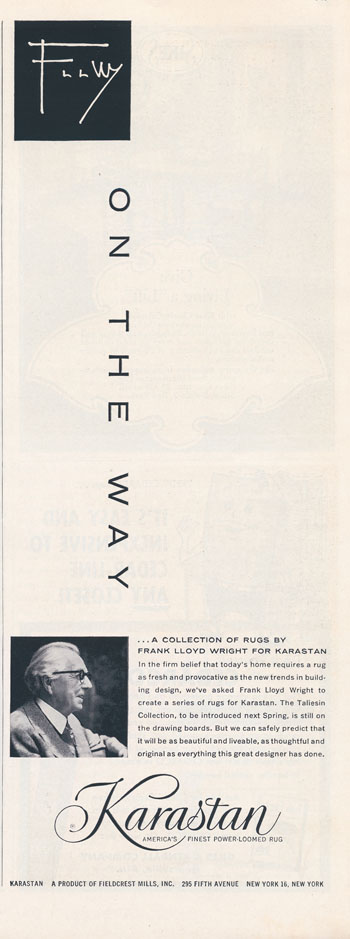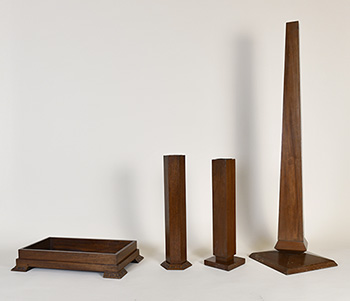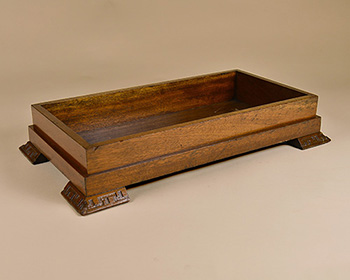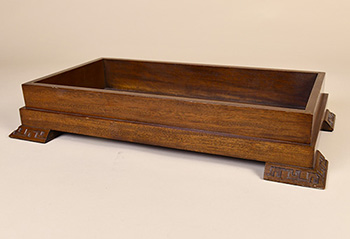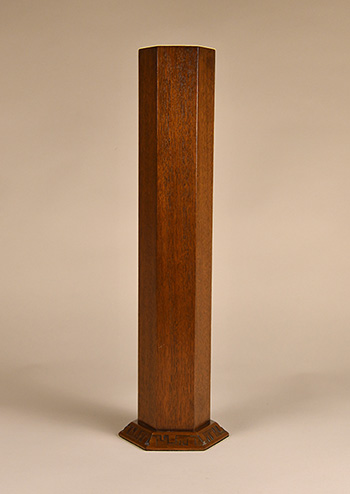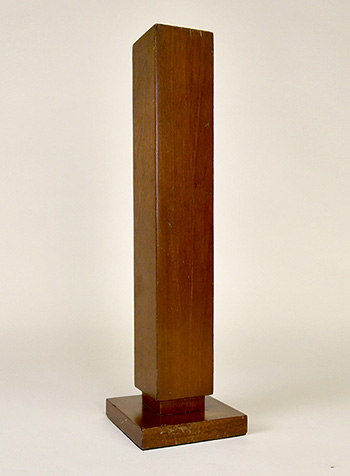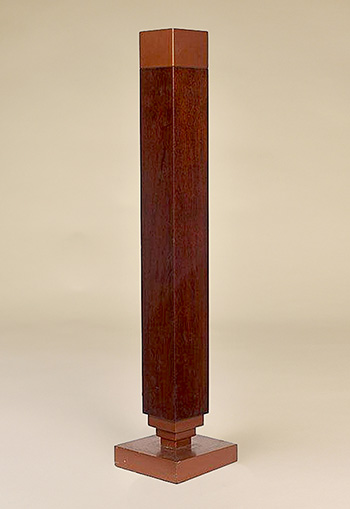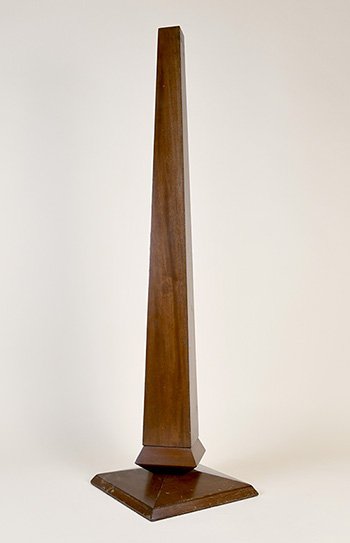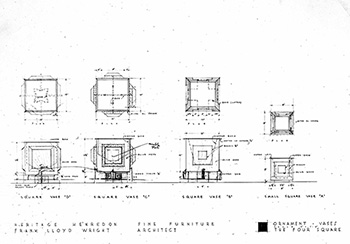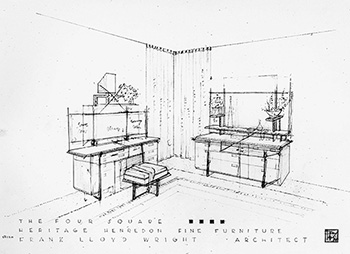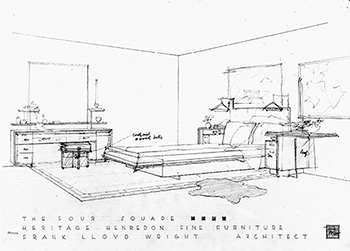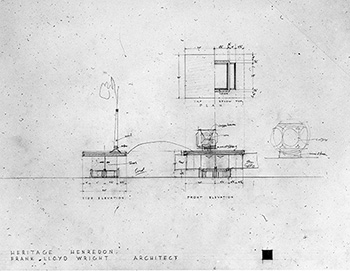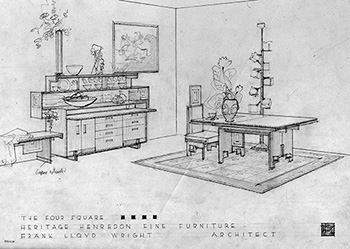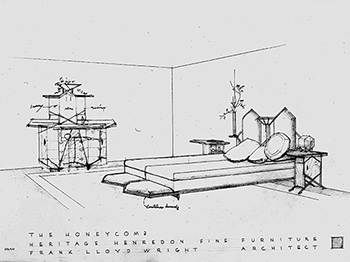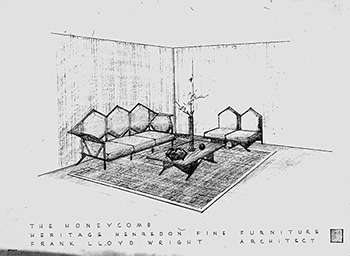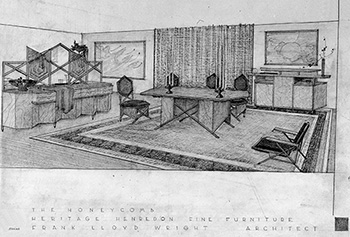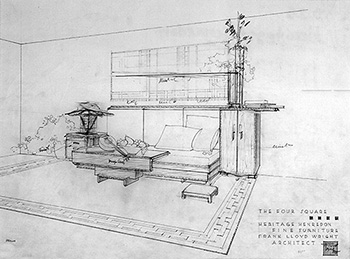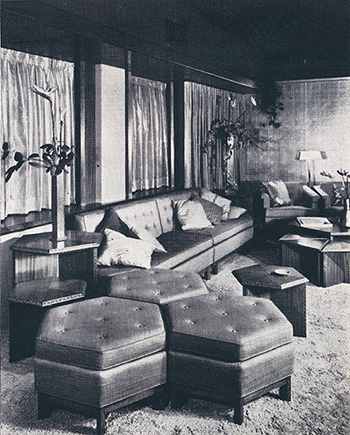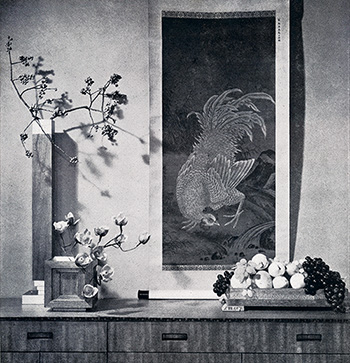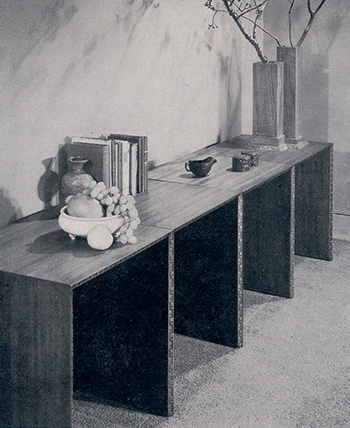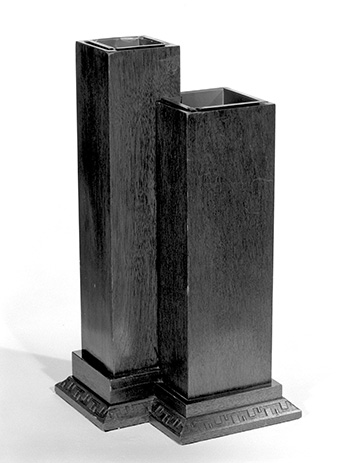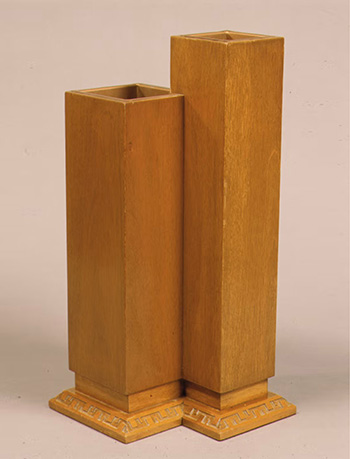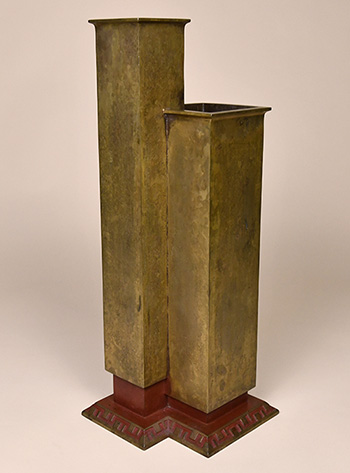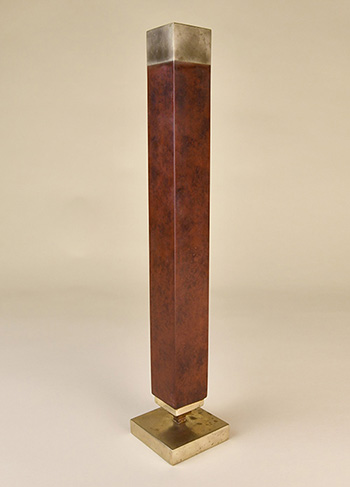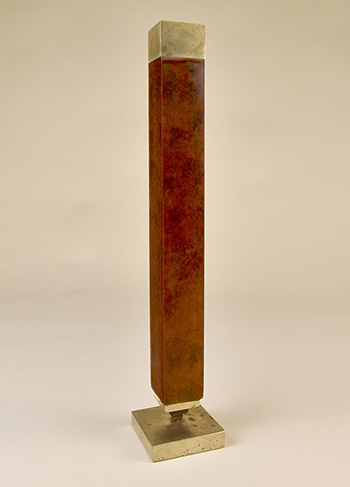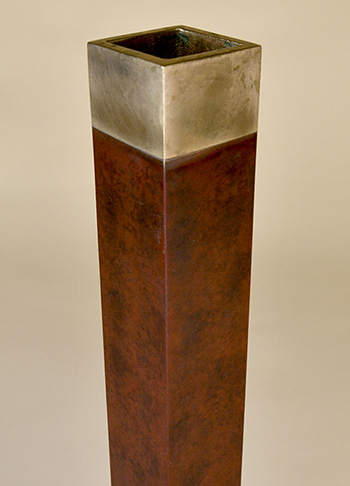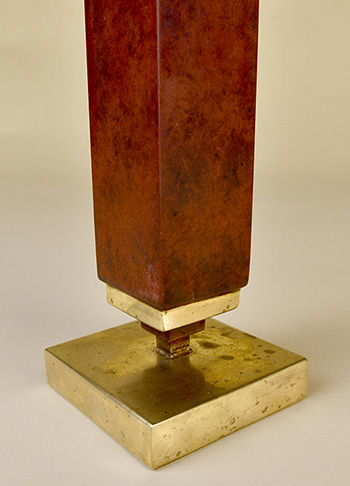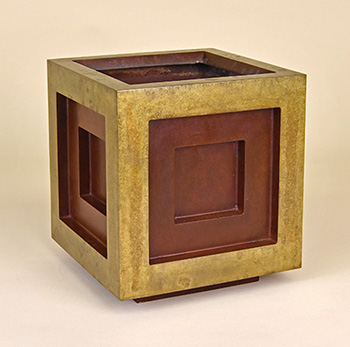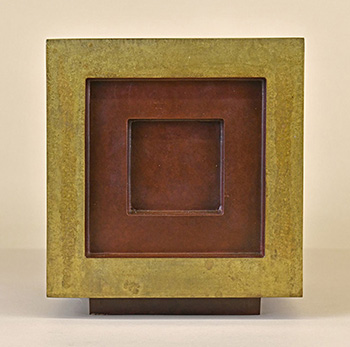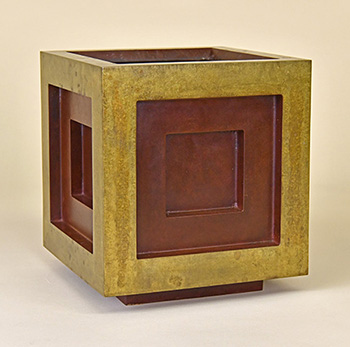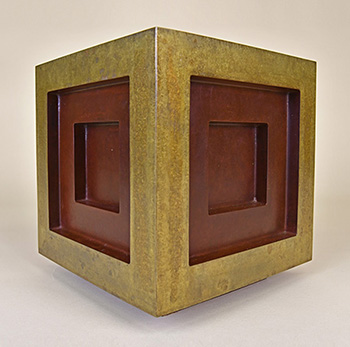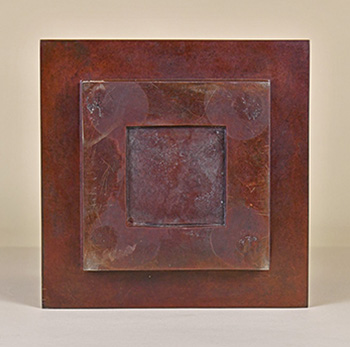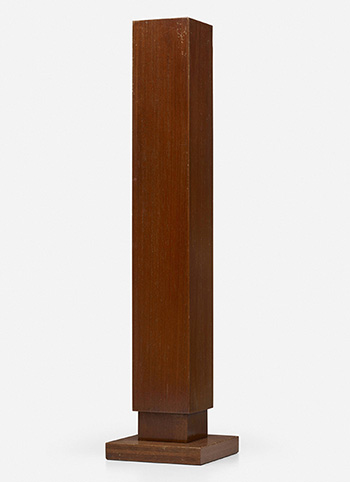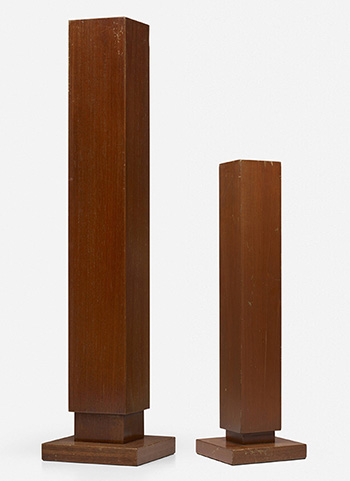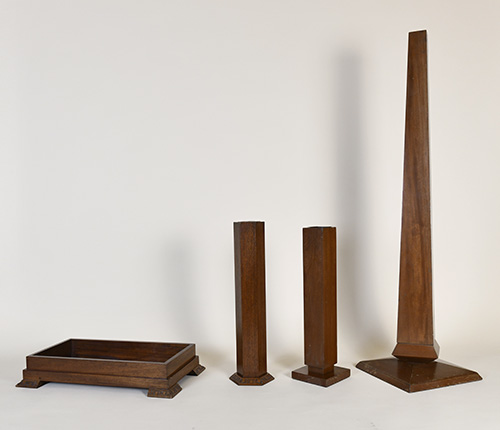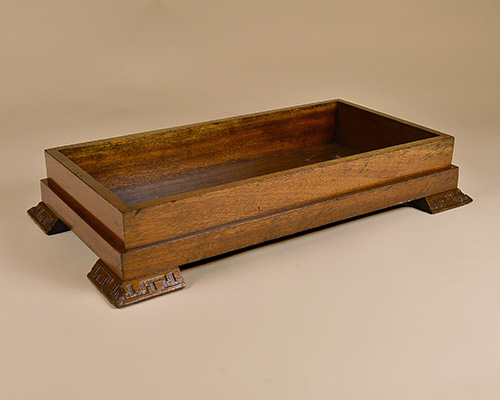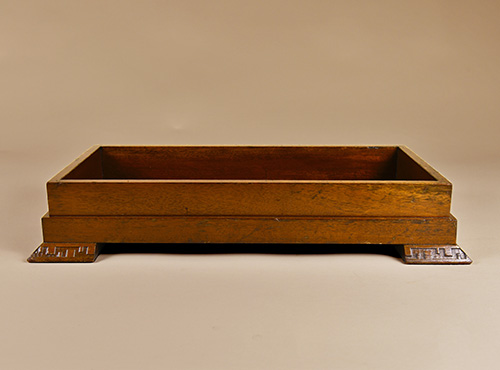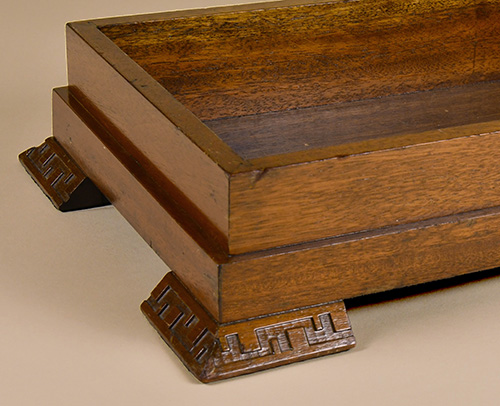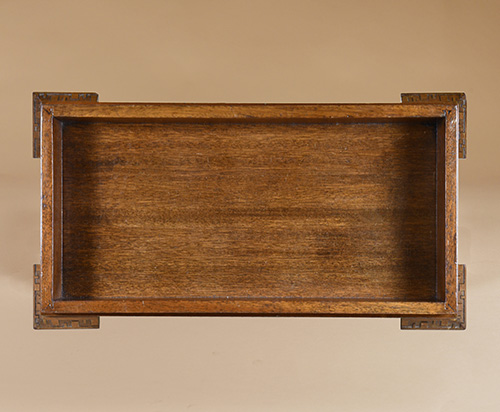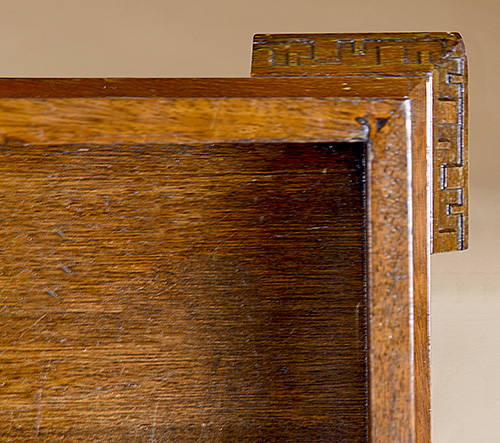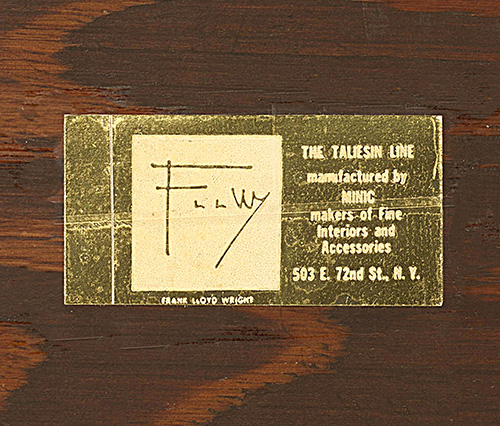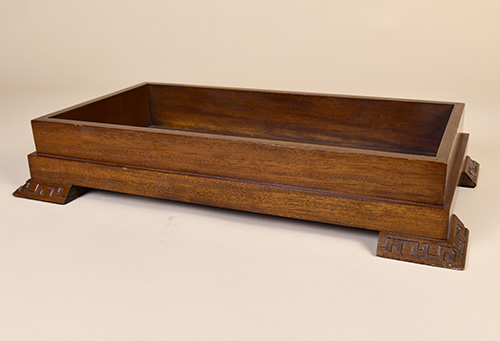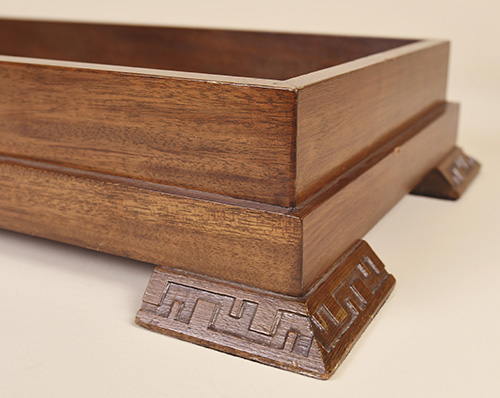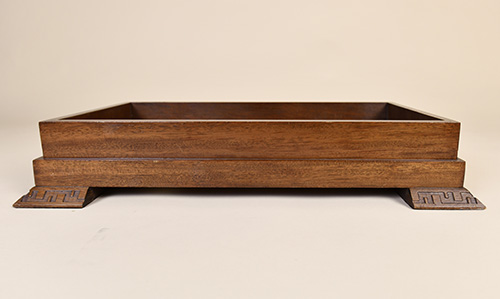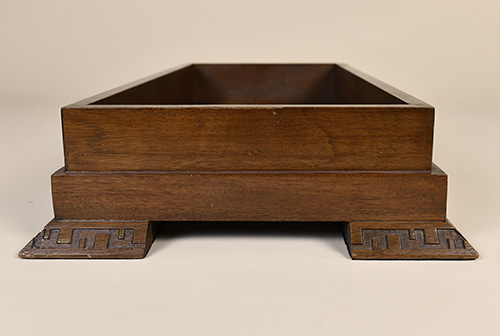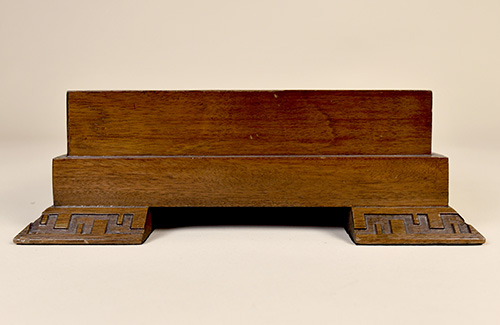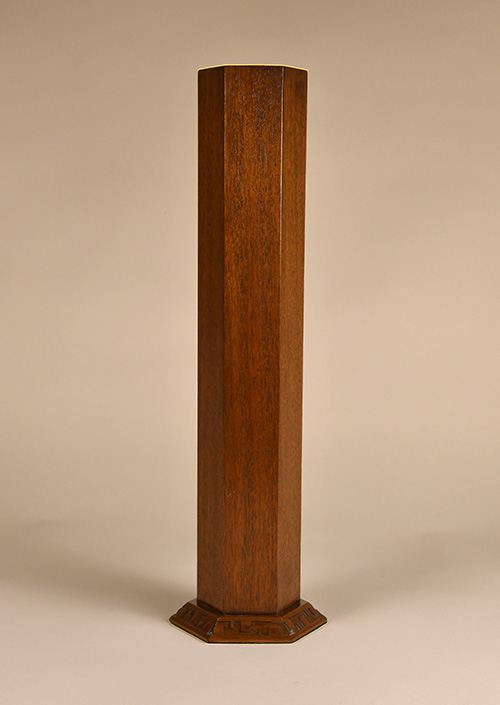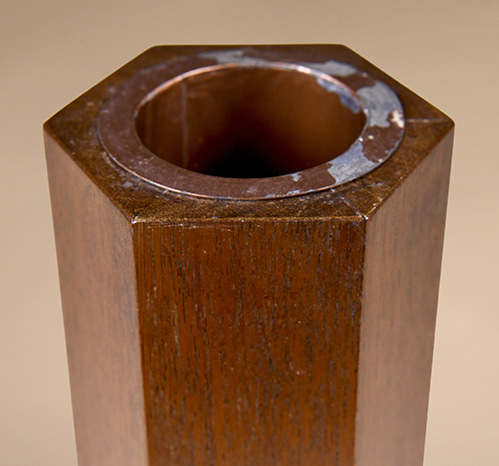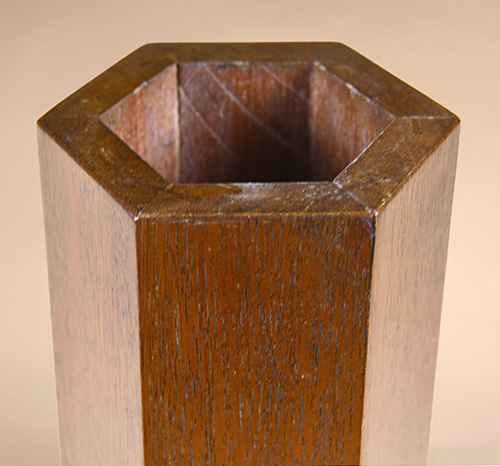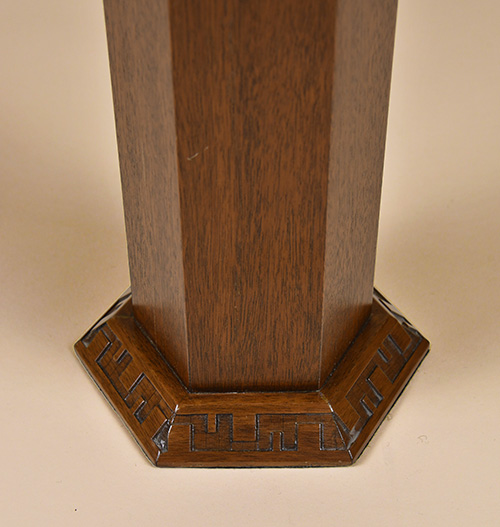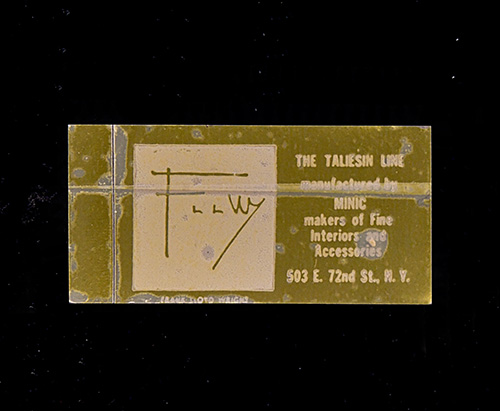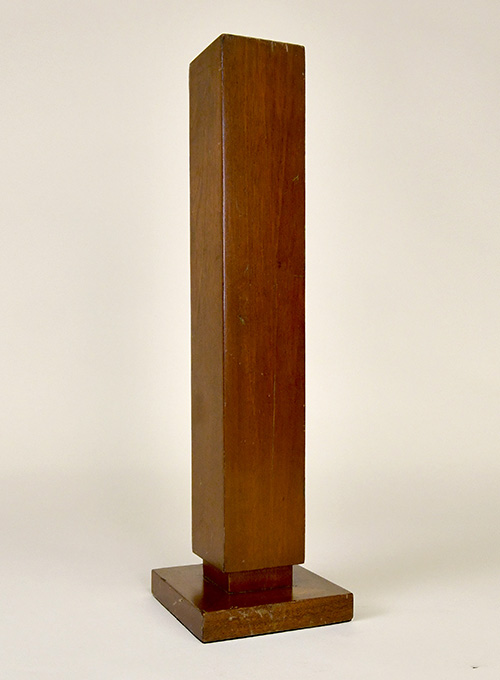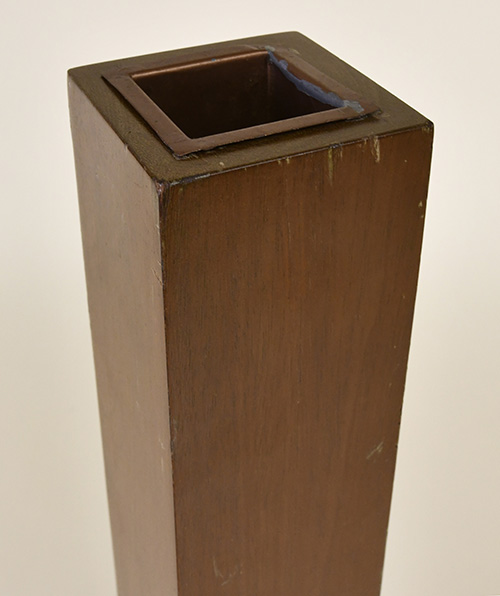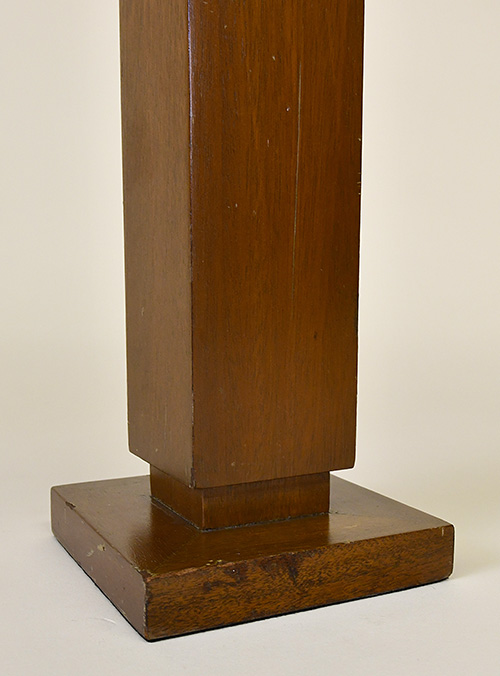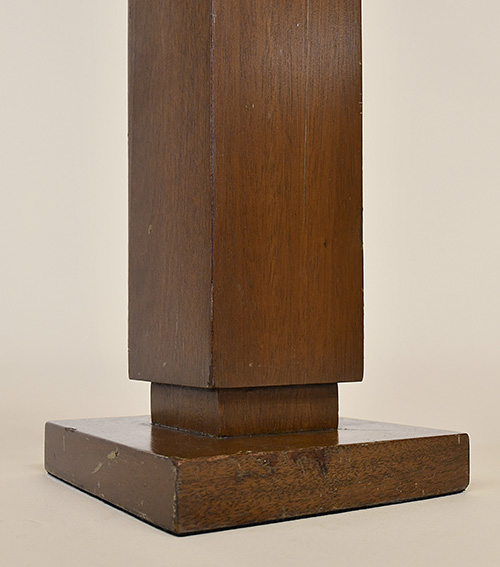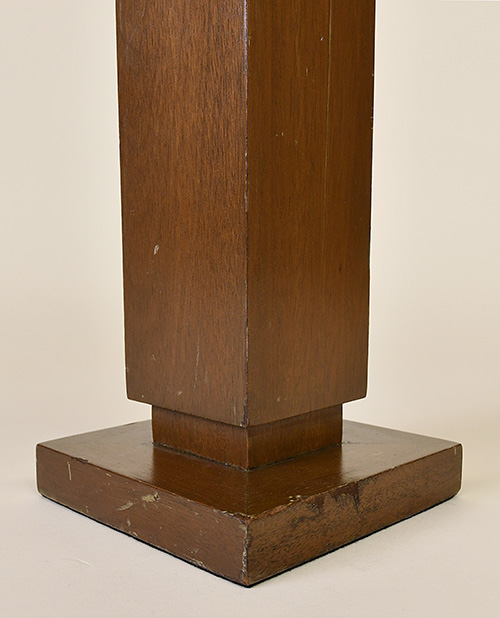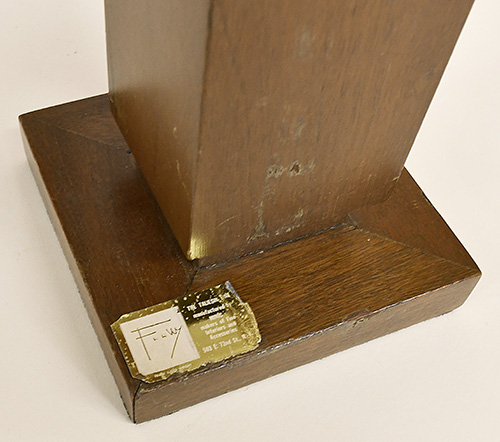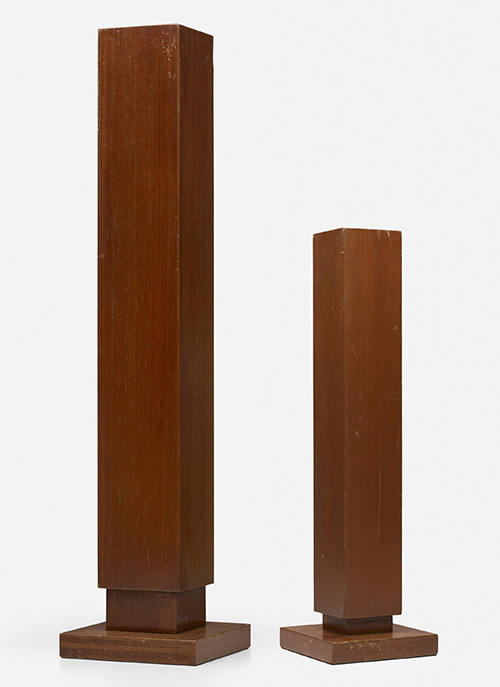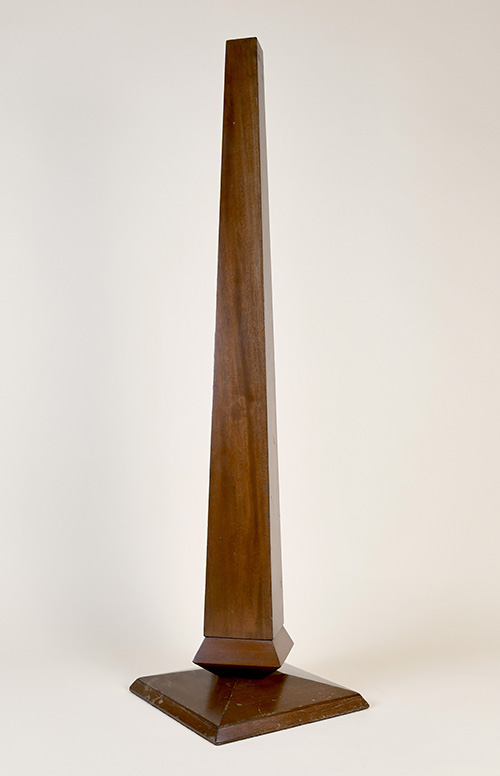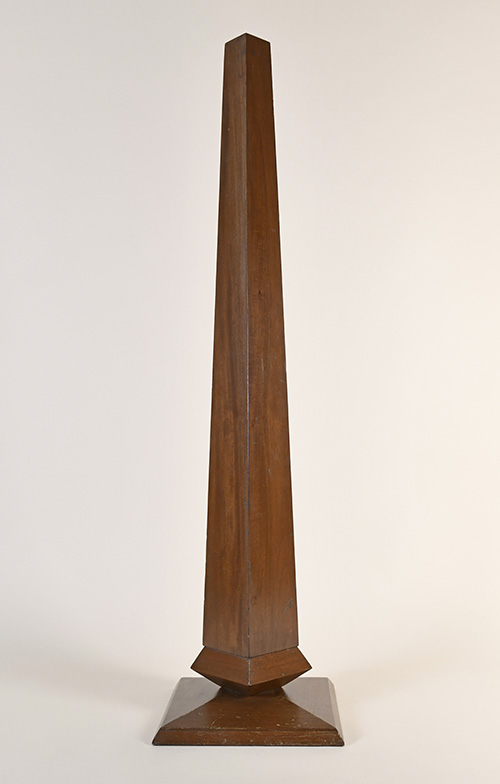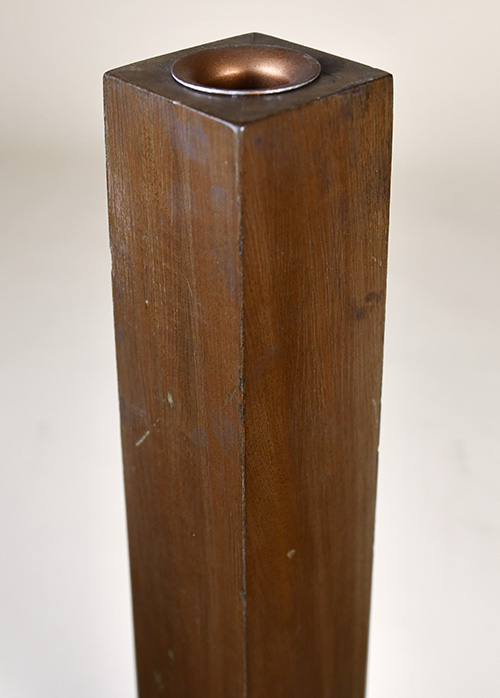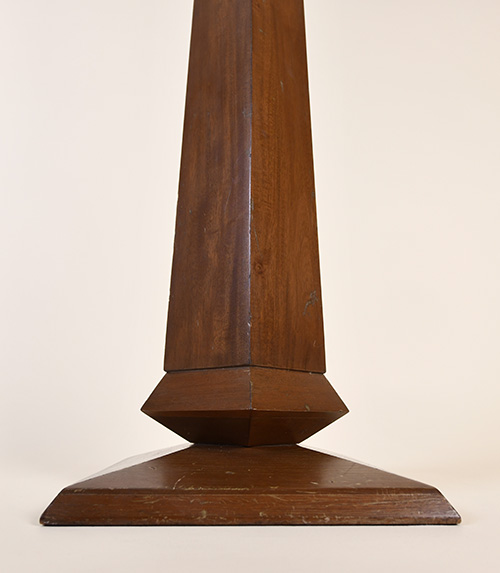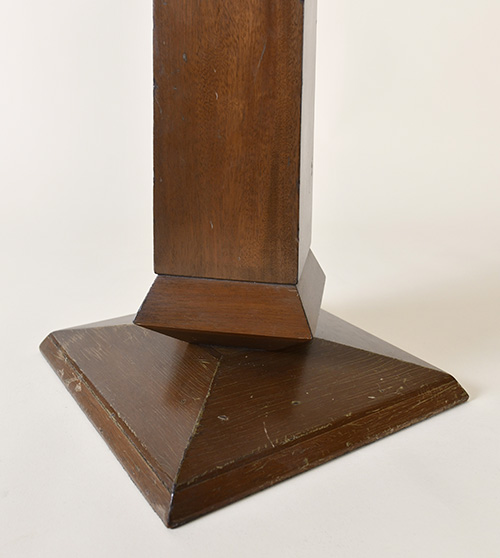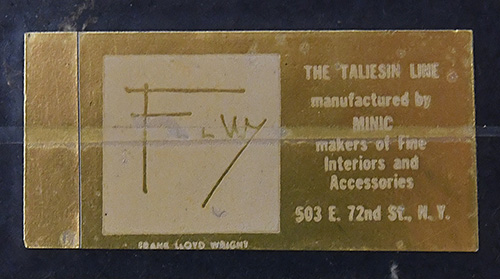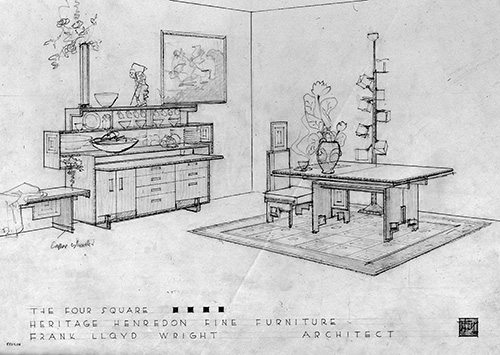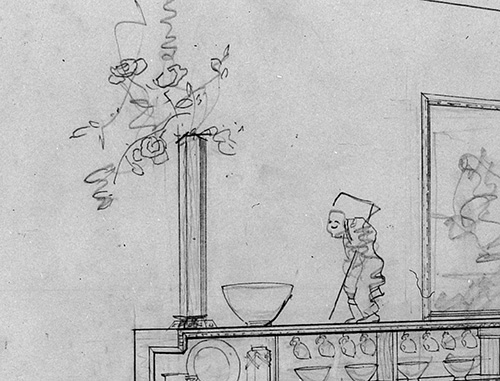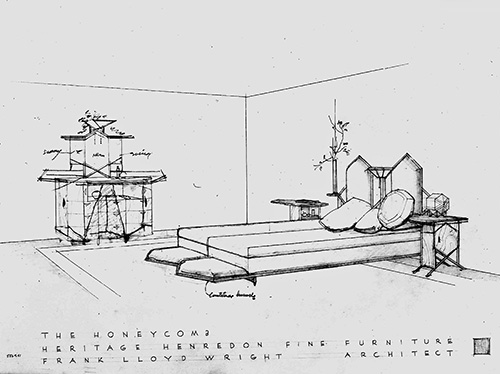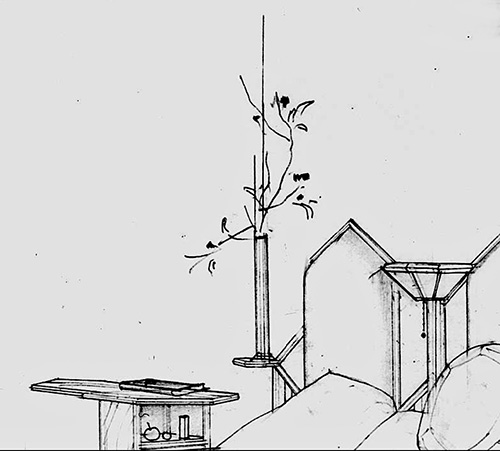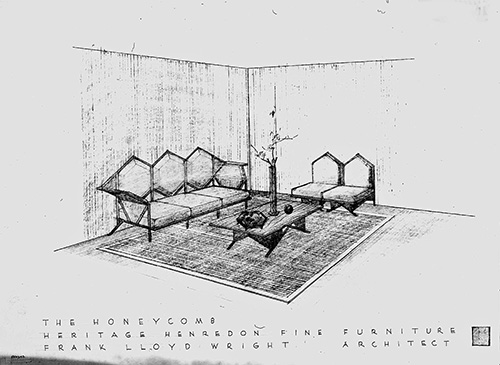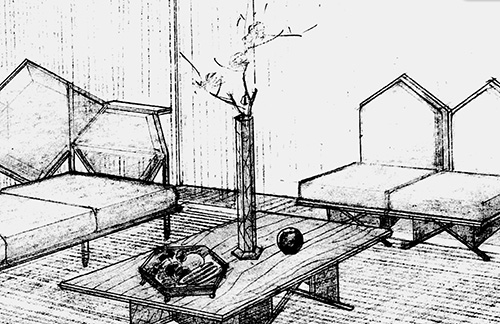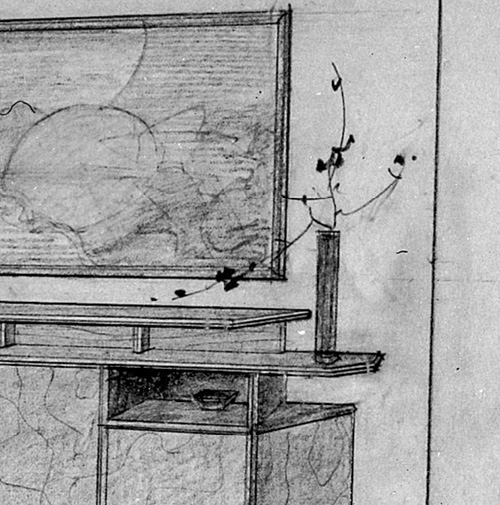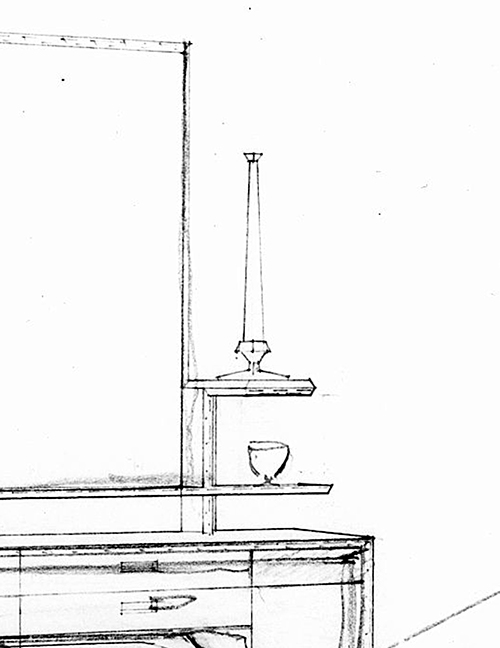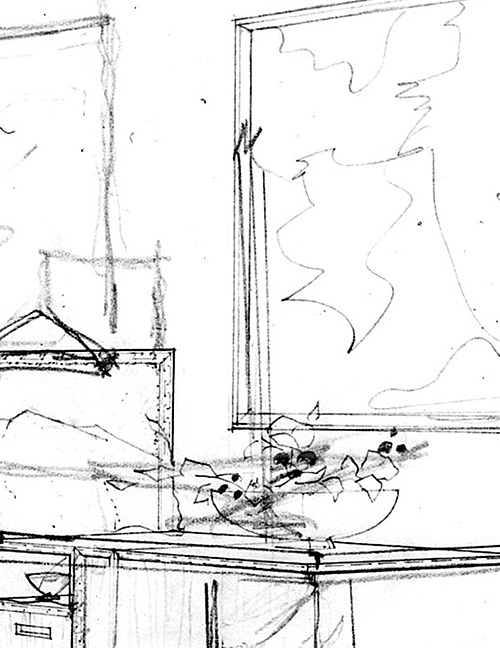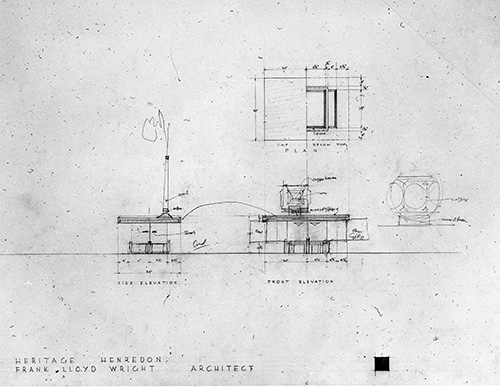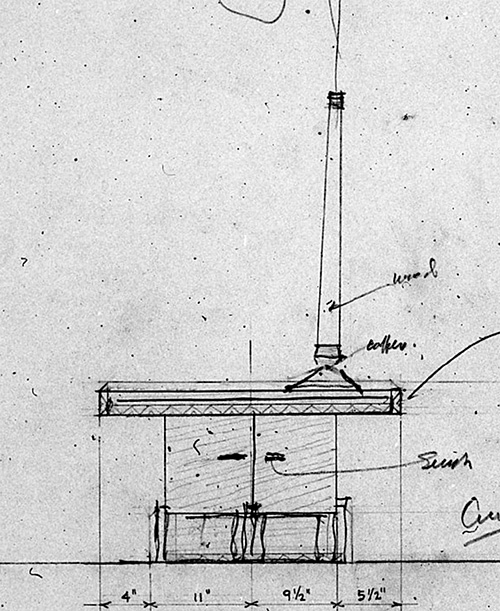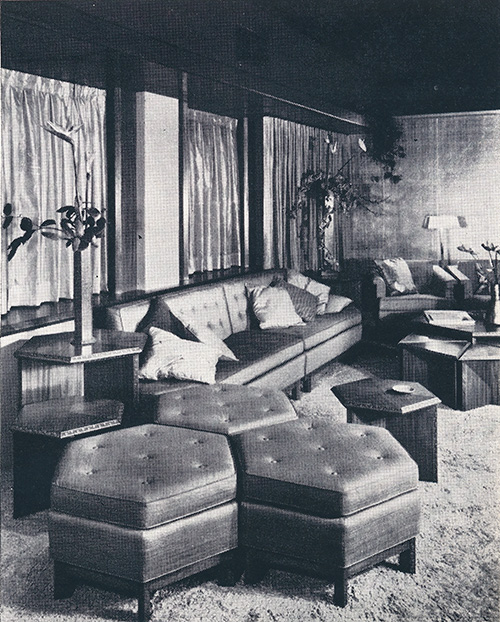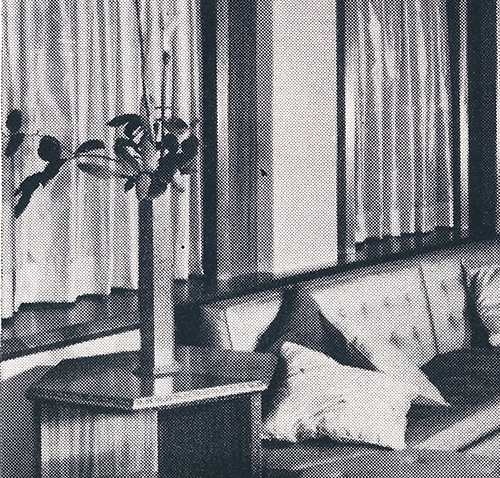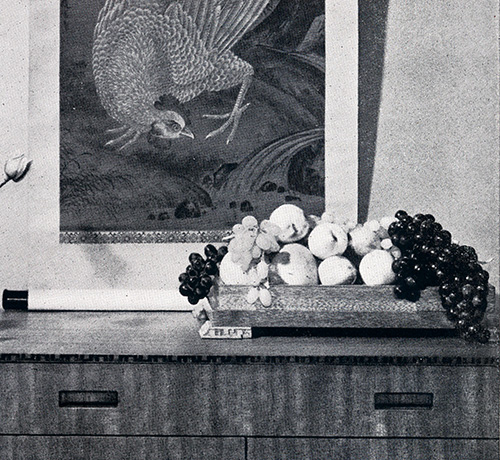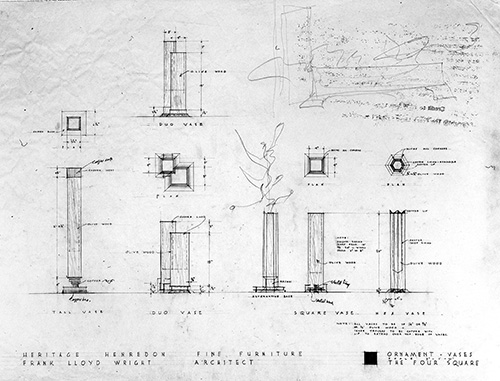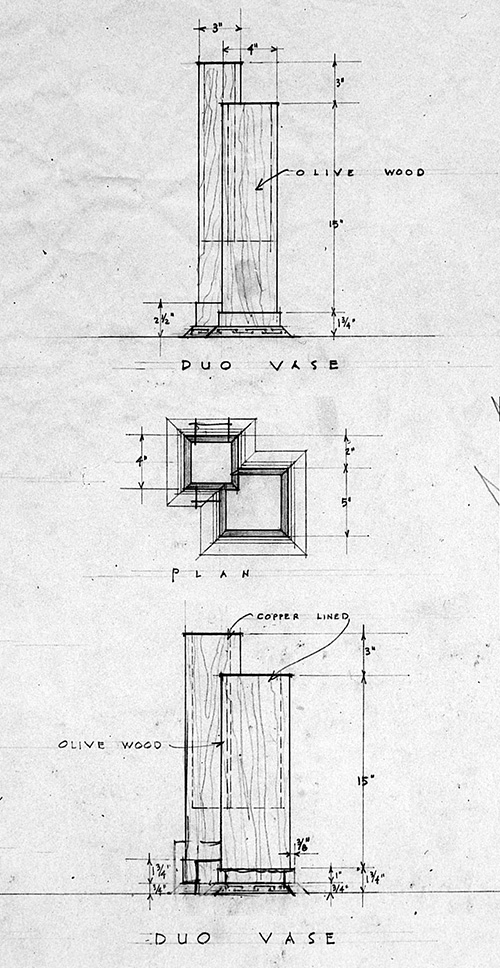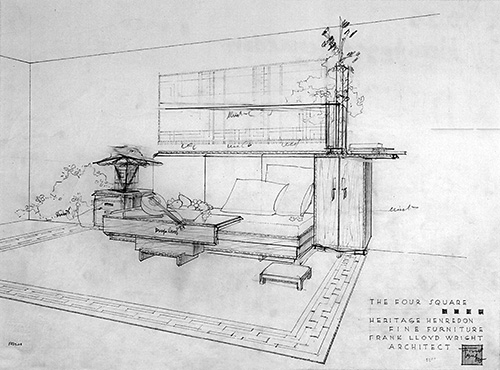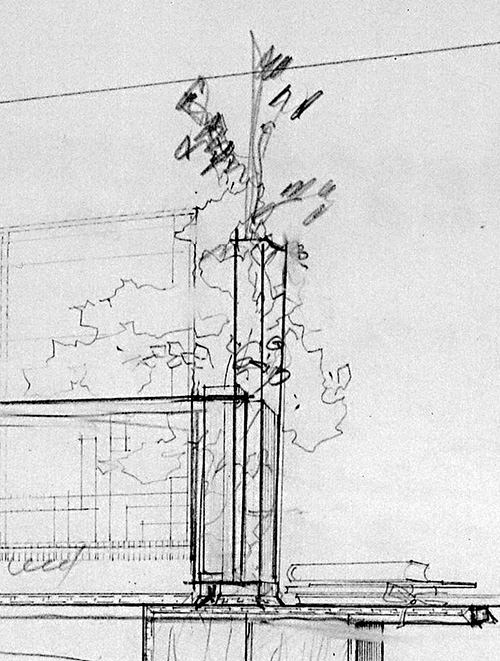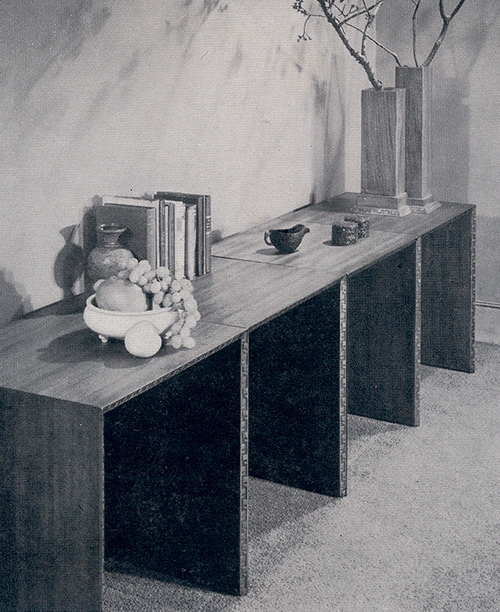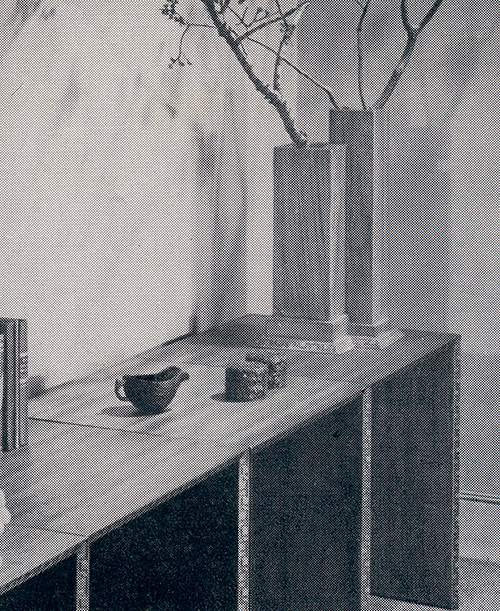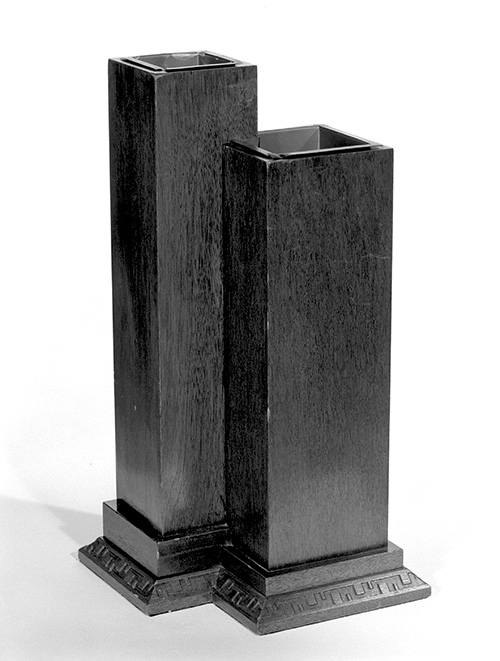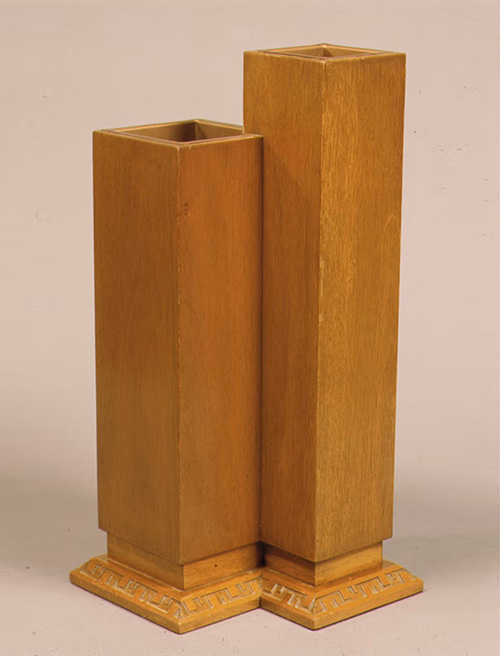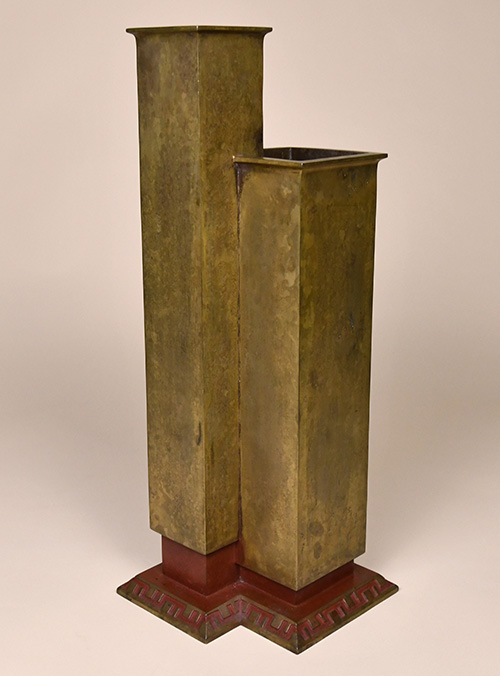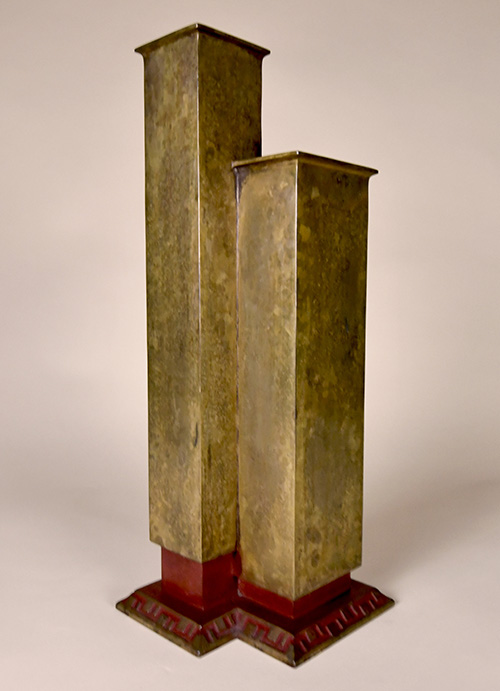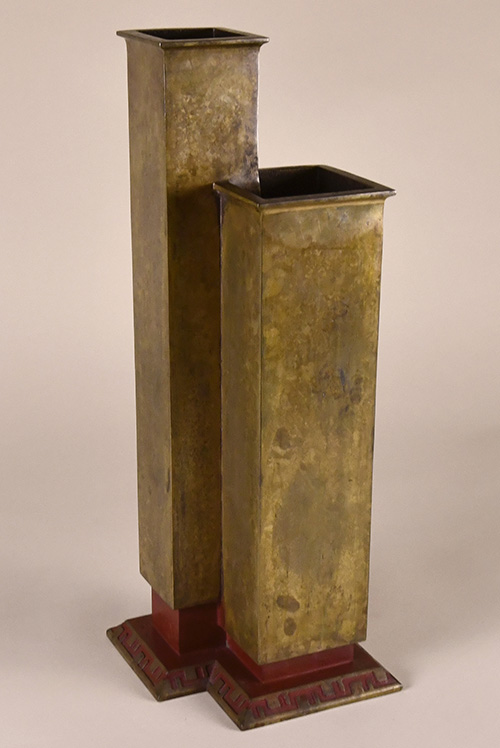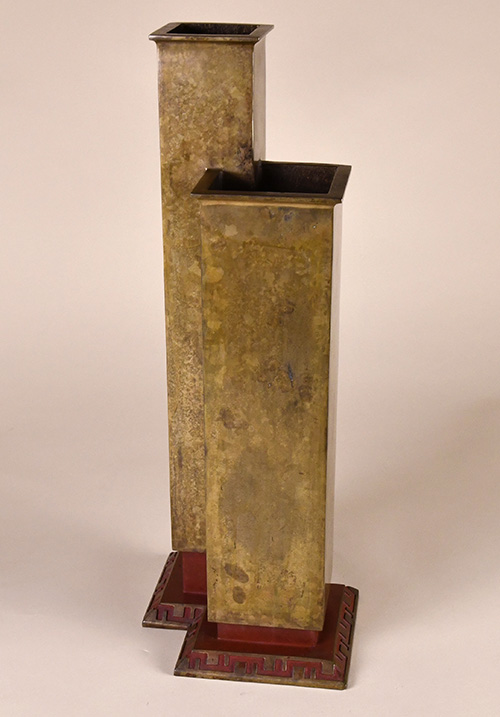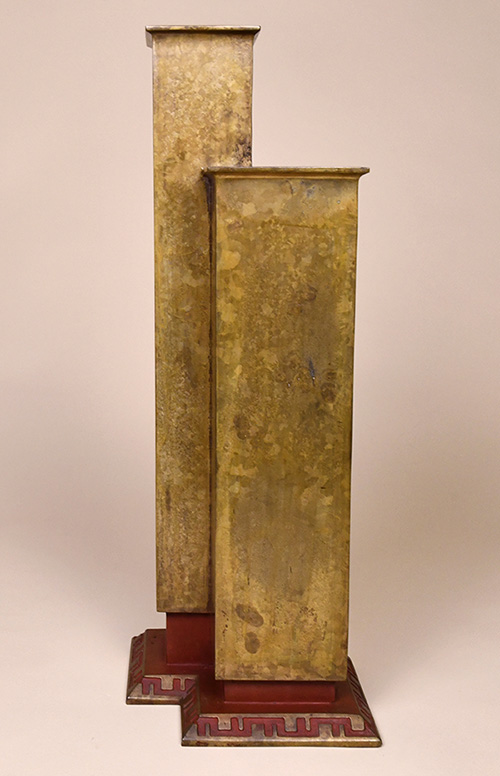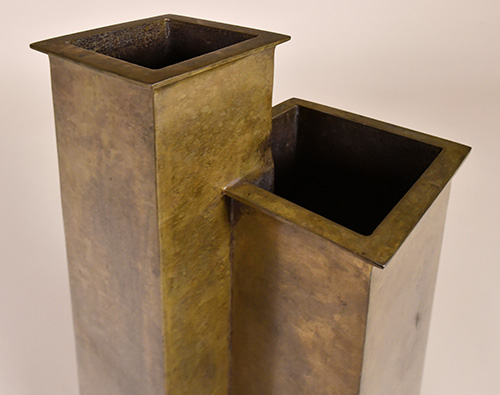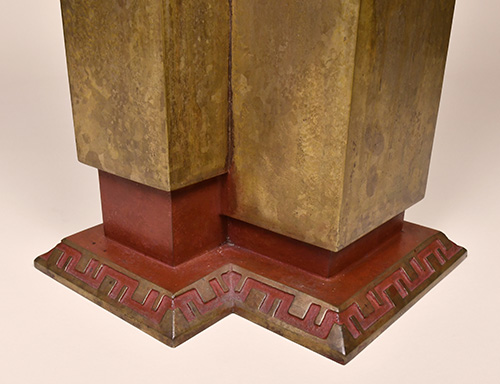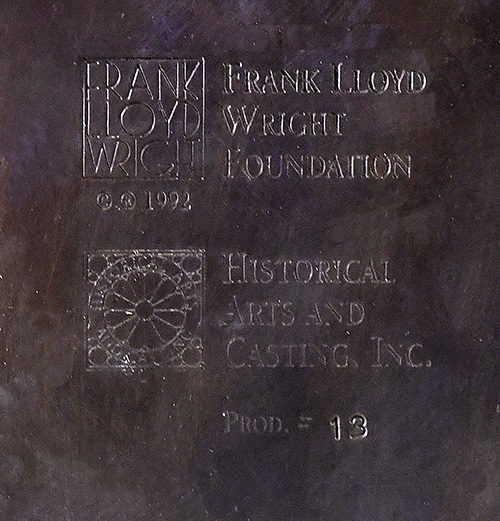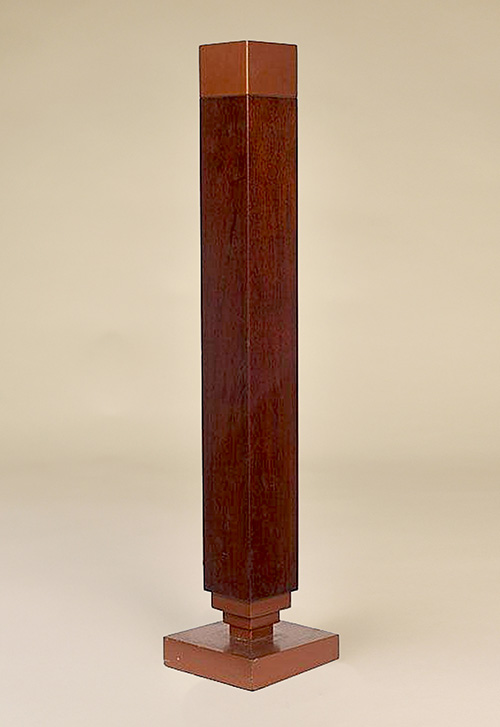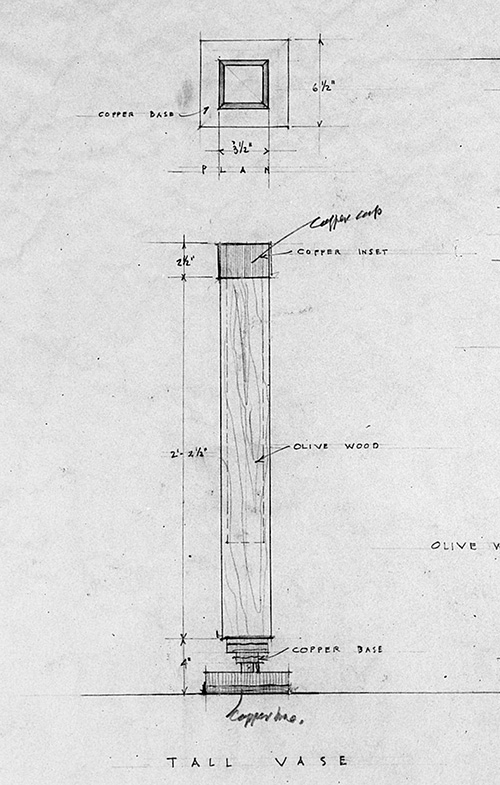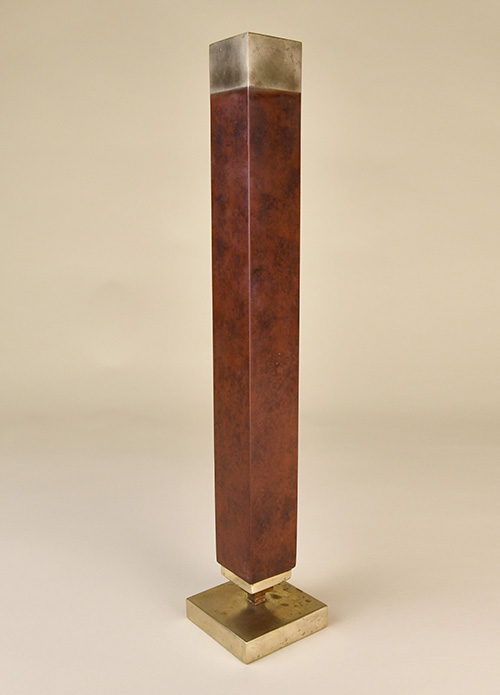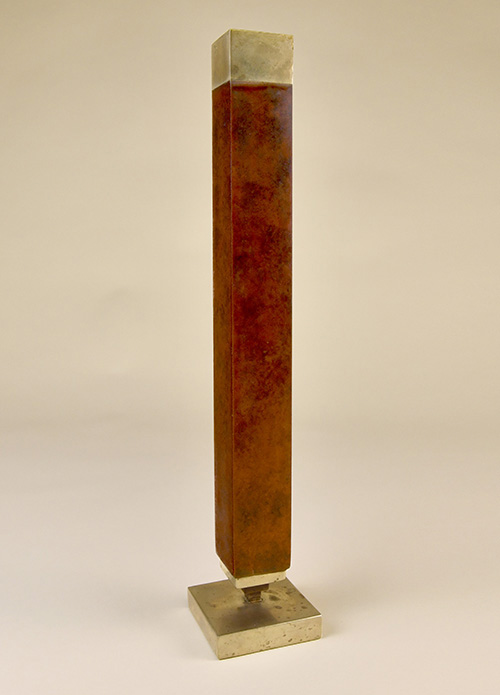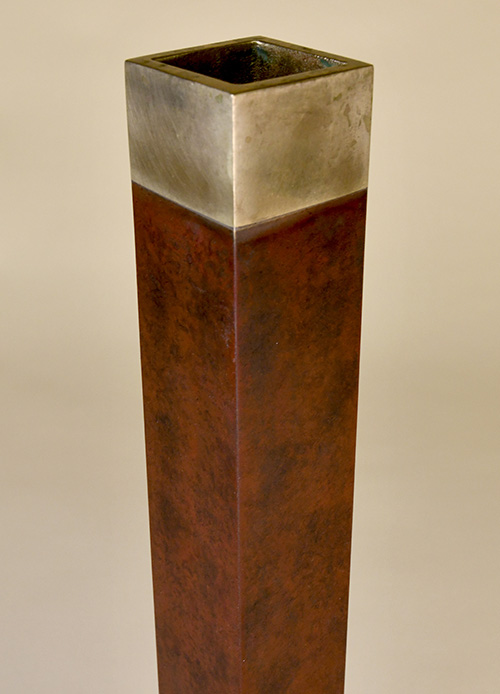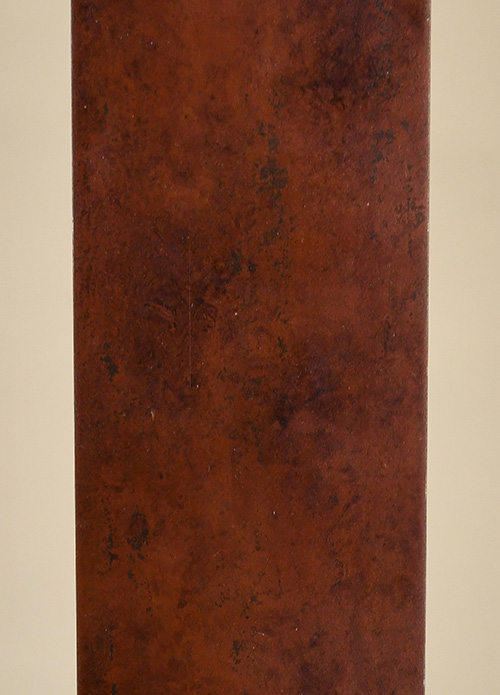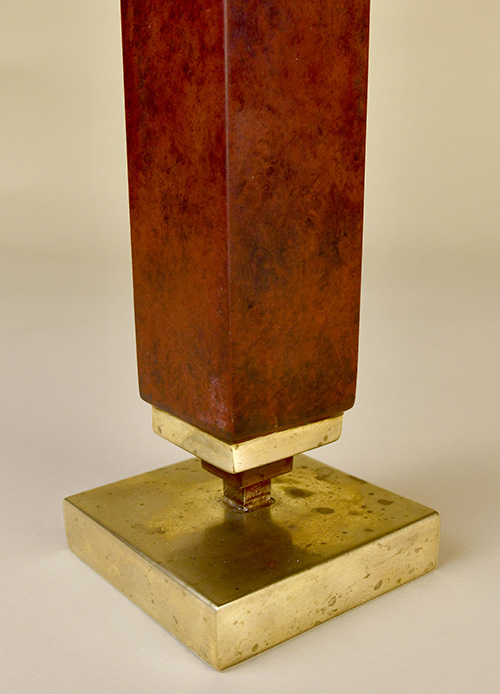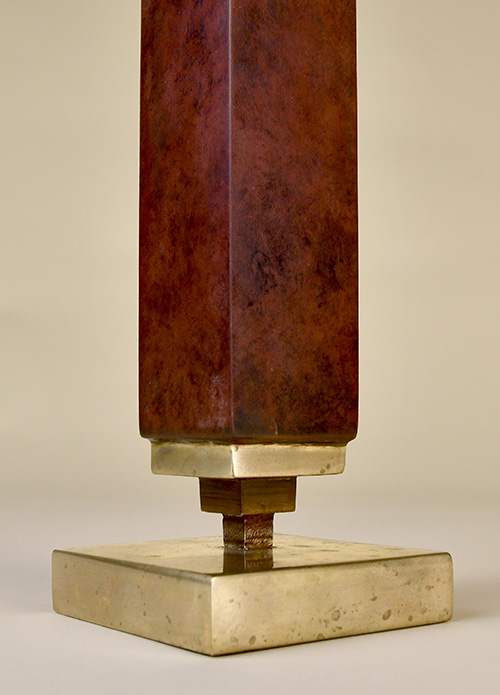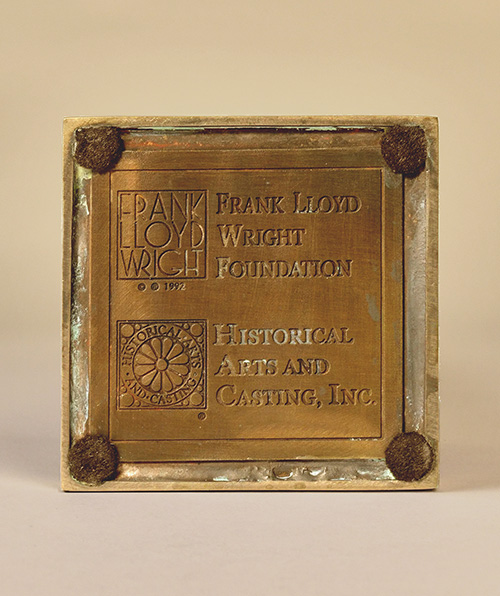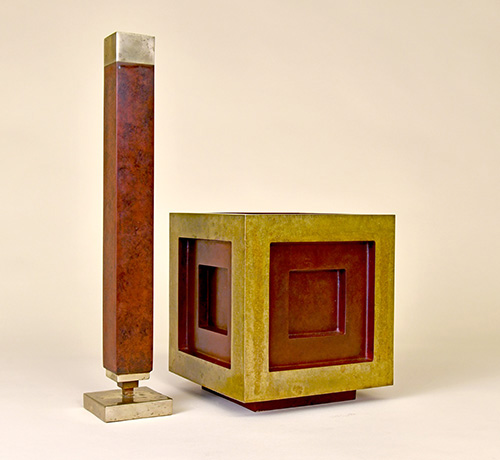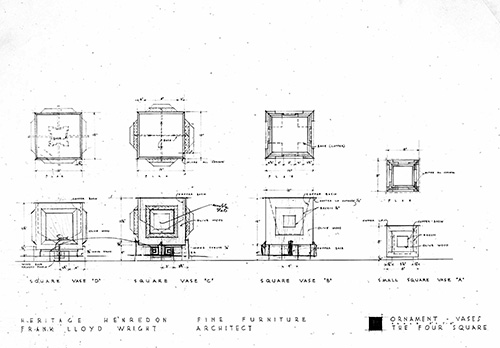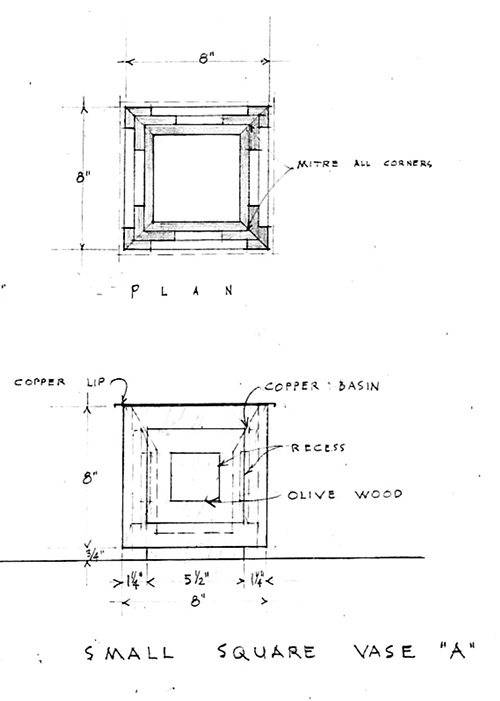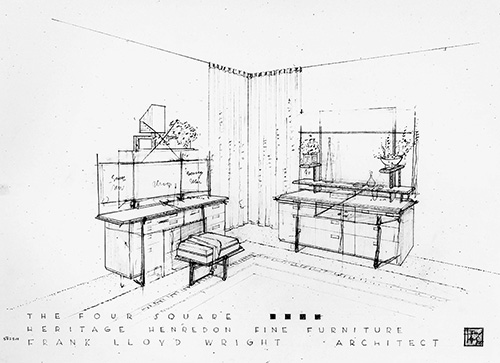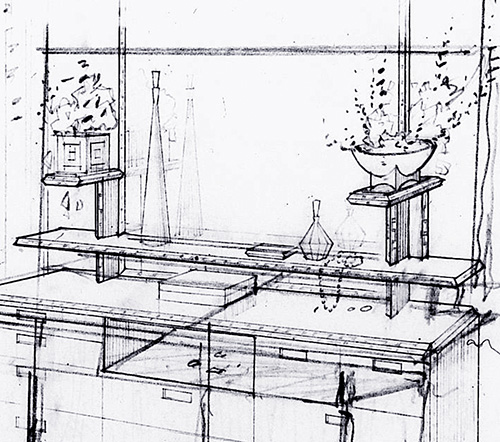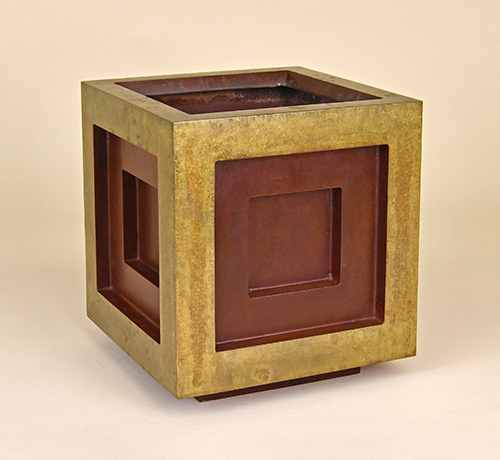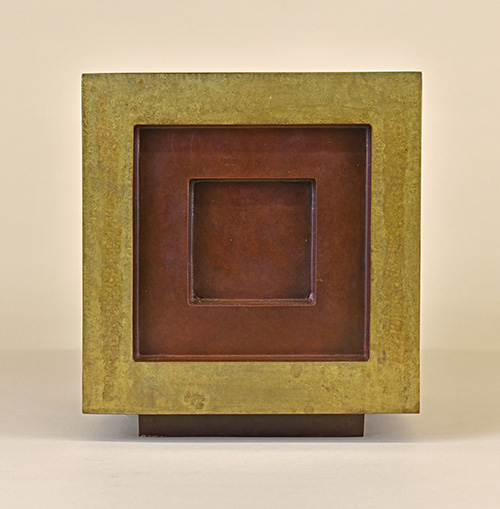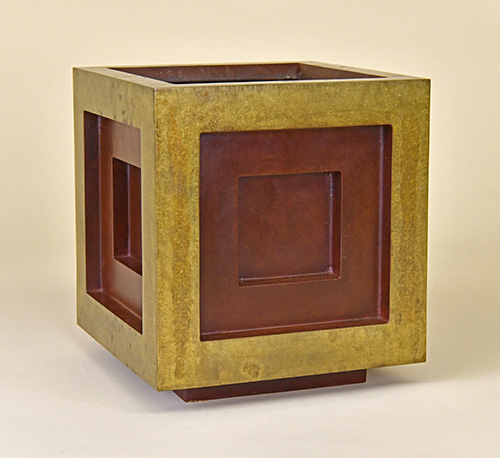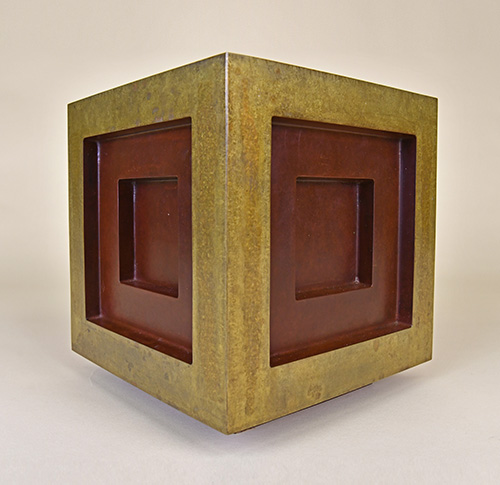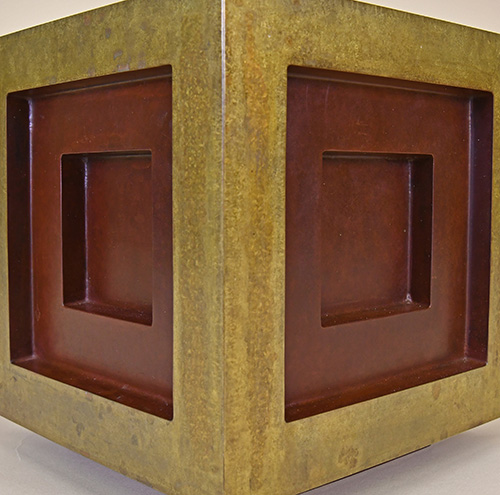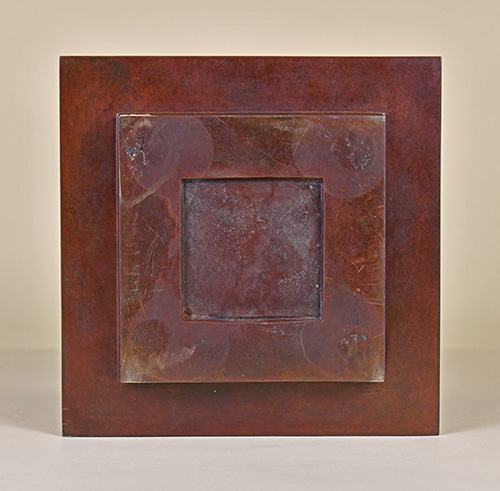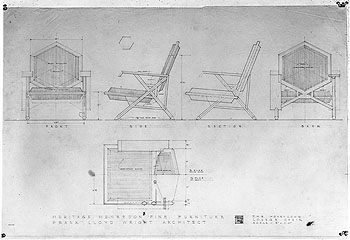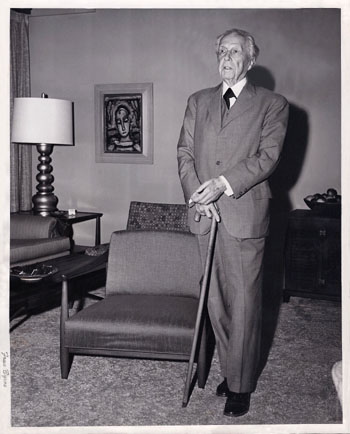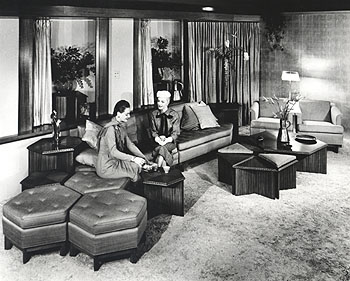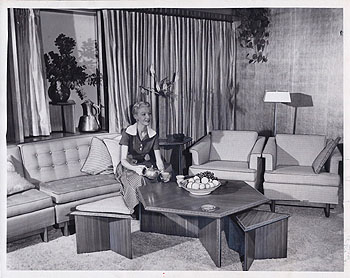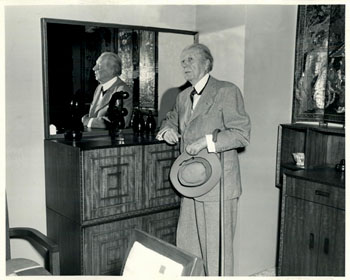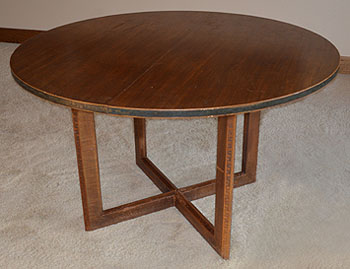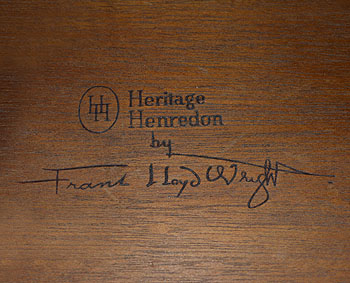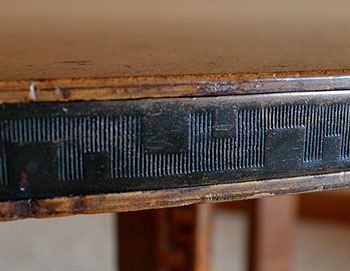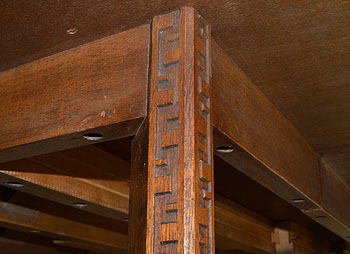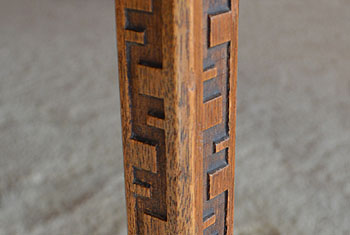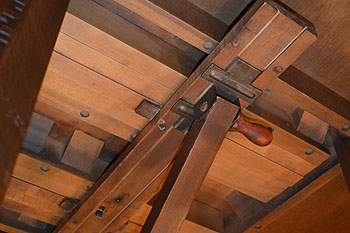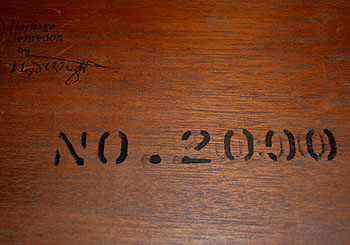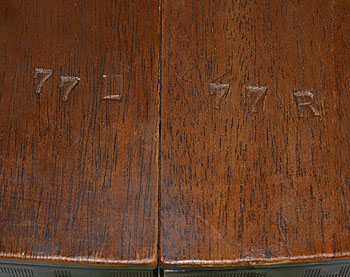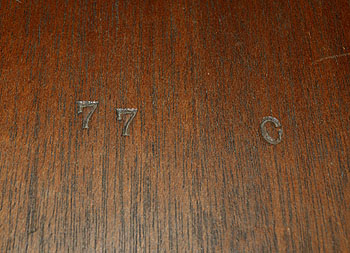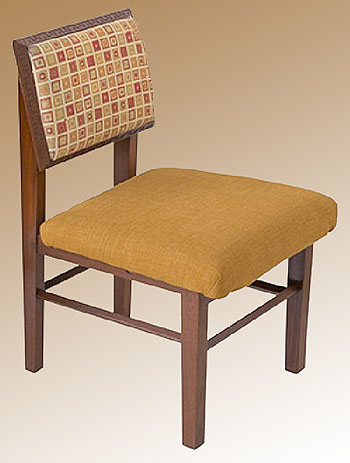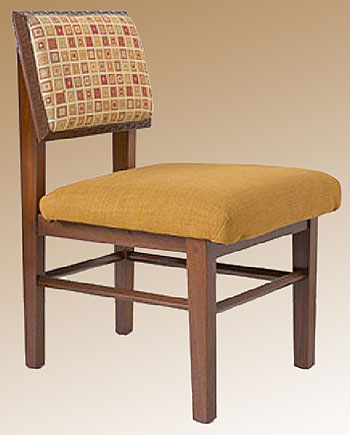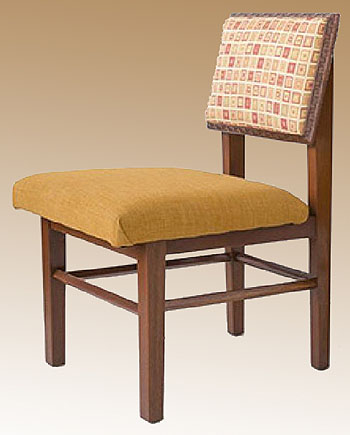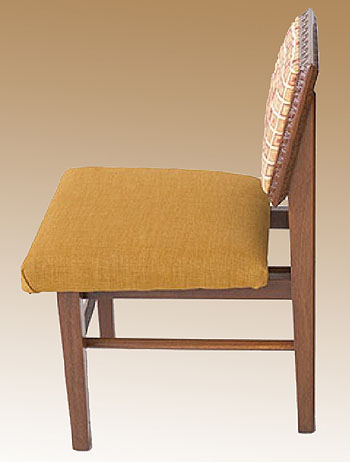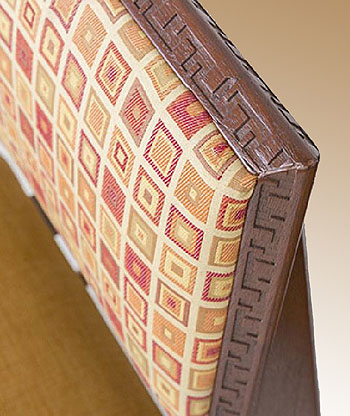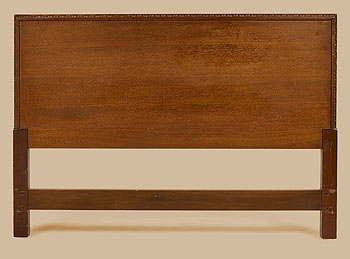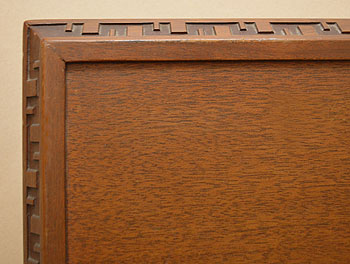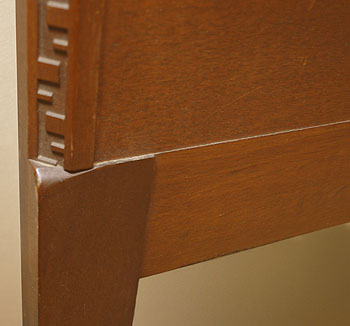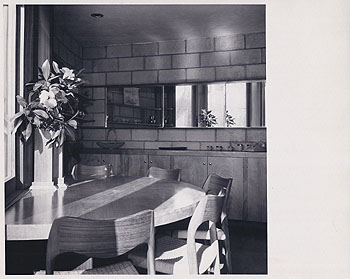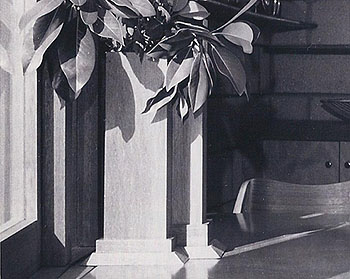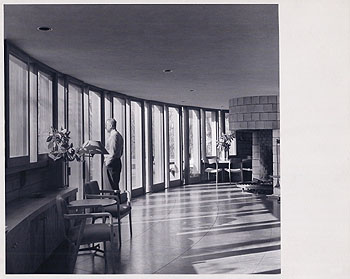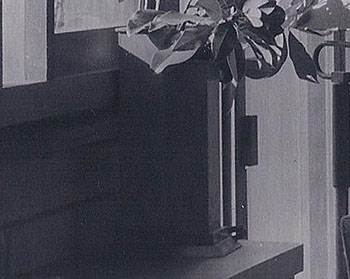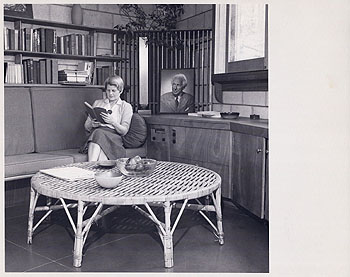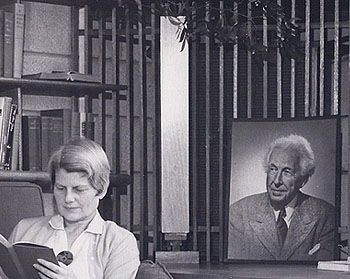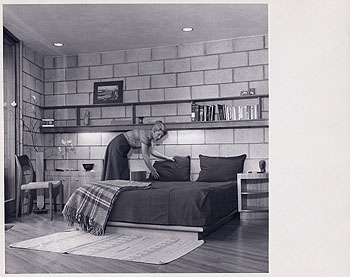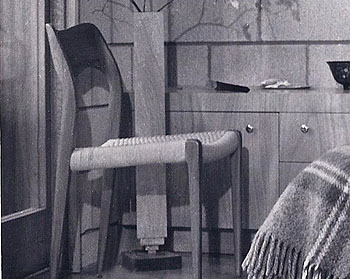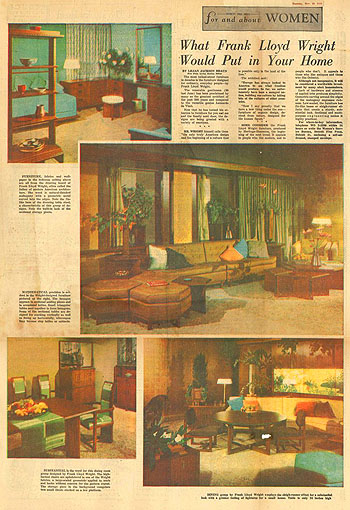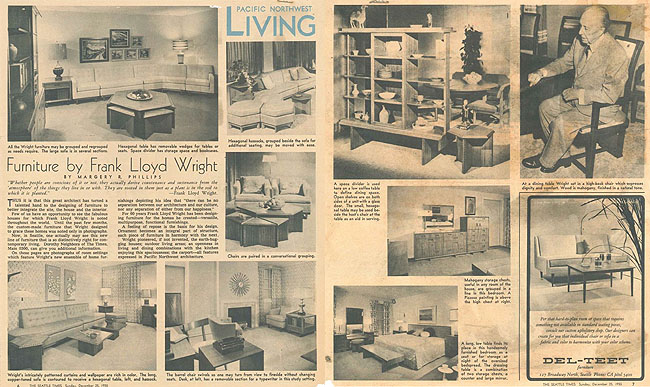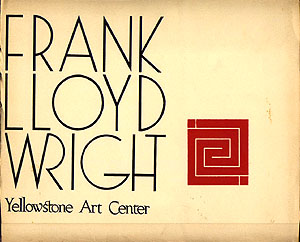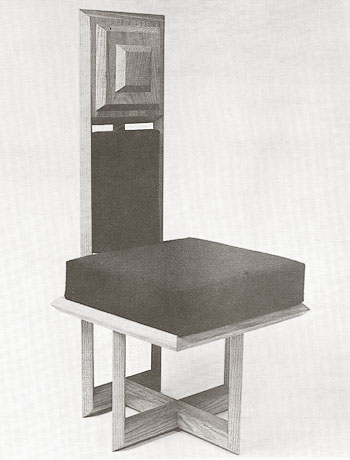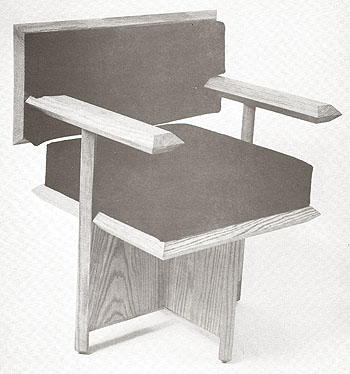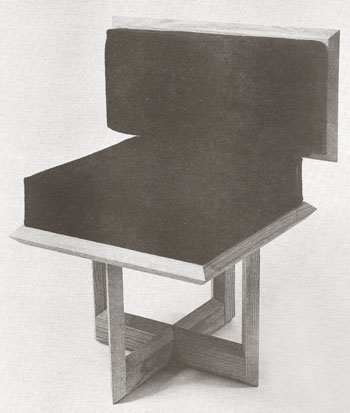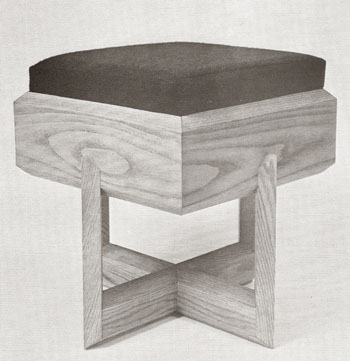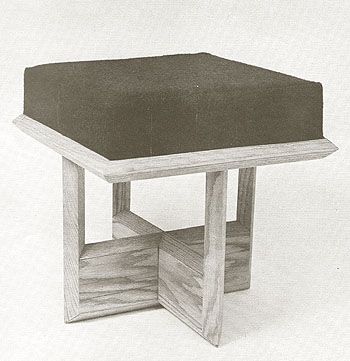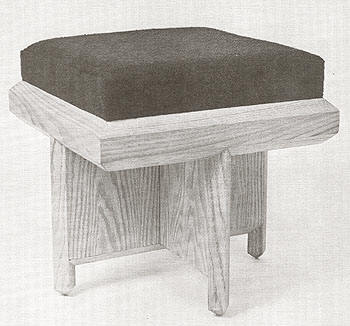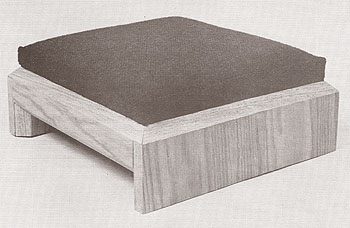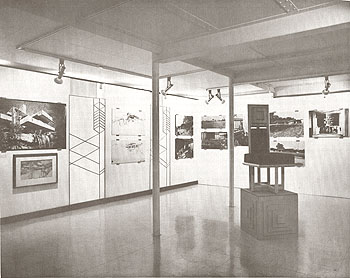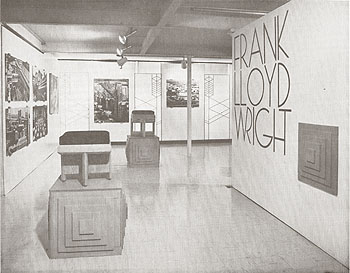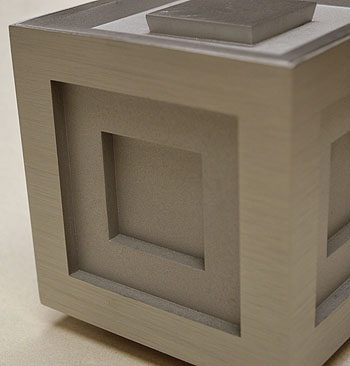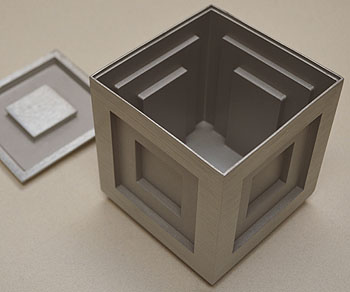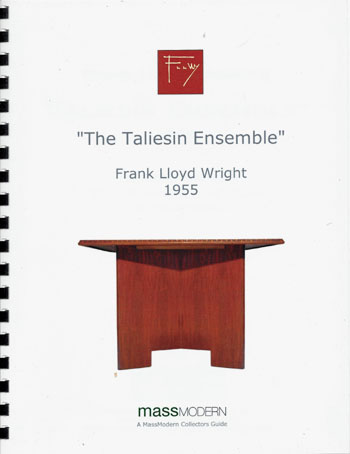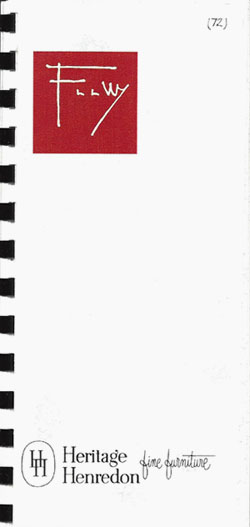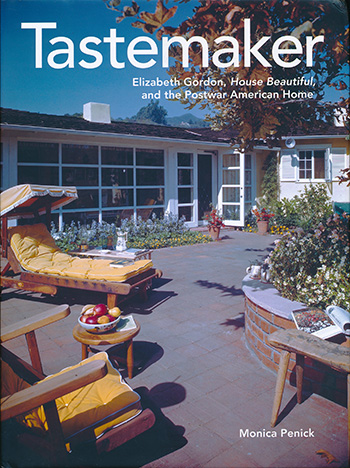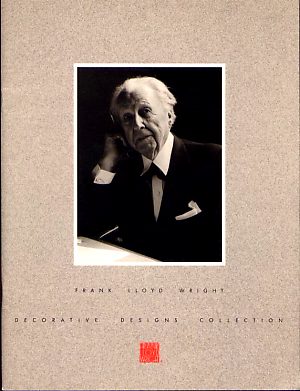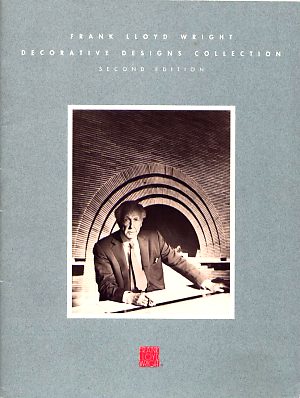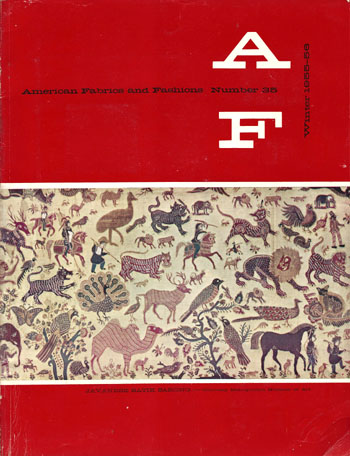
SUPPORT THE
WRIGHT LIBRARY
PROCEEDS FROM EVERY SALE GOES TO SUPPORT THE WRIGHT LIBRARY.
CLICK TO ORDER.
WE PROUDLY SUPPORT THE FRANK LLOYD WRIGHT FOUNDATION

WE PROUDLY SUPPORT THE FRANK LLOYD WRIGHT BUILDING CONSERVANCY
WE PROUDLY SUPPORT FALLINGWATER
AND THE WESTERN PENNSYLVANIA CONSERVANCY

TALIESIN ENSEMBLE
WRIGHT DESIGNED FURNISHINGS
In 1955, Frank Lloyd Wright developed the "Taliesin Ensemble", a line of furnishings for those that did not live in one of his homes. Partnerships were formed with five companies: 1) Heritage-Henredon, a line of furniture designed by Wright. 2) Karastan, Rugs. 3) The Martin-Senour Company, the Taliesin Palette, 36 personally selected paint colors. 4) Minic, Accessories. 5) F. Schumacher & Co., Fabrics & Wallpaper designed by Wright.
According to "Frank Lloyd Wright's House Beautiful," Maddex 2000, page 36, "At Elizabeth Gordon's urging, Wright in 1955developed a line of home furnishings for people who did not live in one of his houses."
For additional information see the November 1955 issue of House Beautiful: Heritage-Henredon Furniture page 48-49. F. Schumacher & Co. Fabrics & Wallpaper, page 94. The Martin-Senour Company Paints, page 204. Karastan Rugs, page 349. There is also an article including all five companies, pages 282-290.F. Schumacher Martin-Senour Paints Karastan Minic Prototypes Minic Prototype Details Heritage-Henredon
Wright Decorative Designs American Fabrics Wright Designed Furniture
F. SCHUMACHER & CO.
Date: 1955 Title: Schumacher's Taliesin Line of Decorative Fabrics and Wallpaper (Published by E.W. & Co. - Sample Books, Chicago).
Author: Schumacher, Frederic
Description: Salesmen's sample book for a line of wallpapers designed by Frank Lloyd Wright. 26 wallpaper samples (four large sample designs in six or seven smaller colorways). The wallpaper sold for $5.95 to $7.45 a roll, matched a line of fabrics also produced by Schumacher and coordinated with Wright's furniture for Heritage-Henredon. 13 large fabric samples with an additional 125 smaller samples of 5 to 30 colorways. Designs include No. 103, 504, 102, 101, 502, 104, 501, 505, 705, 503, 706, 506, 507 (in this order). Includes 30 photos and one illustration of Wright's work and examples of products in use. Last bound page is 18 perforated reply cards. Also included but loose are three press releases (1955 - 1, 1956 - 2), price list and additional loose samples. See David Hanks, "Decorative Designs of Frank Lloyd Wright", pp. 195-198. Sweeney lists the date as 1957 but includes: "This book is undated and possible appeared in 1955." F. Schumacher & Co. was founded in 1889. A letter that accompanied this book states "Our Sixty-Sixth Year" which would make the publication date 1955 as Sweeney alludes to. Also according to "Frank Lloyd Wright's House Beautiful", Maddex 2000, page 36, "At Elizabeth Gordon's urging, Wright in 1955 developed a line of home furnishings for people who did not live in one of his houses." (First Edition) (Sweeney 1148)
Size: 17.5 x 22.75
Pages: Not Paginated - Pp 36 Plus
S#: 1148.00.0706
Page 1 - Note: Pages are not numbered.
Sample book also includes wallpaper samples not included.
Page 2 & 3
Page 4 & 5
Page 6 & 7
.
Page 8 & 9
Page 10 & 11
Page 12 & 13
Page 14 & 15
Page 16 & 17
Page 18 & 19
Page 20 & 21
Page 22 & 23
.
Page 24 & 25
Page 26 & 27
Page 28 & 29
Page 30 & 31
Page 32 & 33
Page 34 & 35
Page 36
Back Cover
Date: 1955
Title: Schumacher Fabric Sample Design 102, Fabric 775740 Leaf Green. .
Description: Original Schumacher Leaf Green Fabric Sample ,Design 102, Fabric 775740 Leaf Green, Taliesin Line of Decorative Fabrics. Manufactured by F. Schumacher & Co., 1955. In 1955 at Elizabeth Gordon’s urging, Frank Lloyd Wright developed the "Taliesin Ensemble", a line of furnishings for those that did not live in one of his homes. Partnerships were formed with five companies: 1) Heritage-Henredon, a line of furniture designed by Wright. 2) Karastan, Rugs. 3) The Martin-Senour Company, the Taliesin Palette, 36 personally selected paint colors. 4) Minic, Accessories. 5) F. Schumacher & Co., Fabrics & Wallpaper designed by Wright.
Text on edge: “Design 102. An Exclusive Schumacher Hand Print.” Hand Printed one side only. Samples included in Schumacher's Taliesin Line of Decorative Fabrics and Wallpaper, p.9-10. Six colors include: 1) Blue 2) Leaf Green 3) Old Gold 4) Coral and Flame 5) Tan and Slate 6) Wood Brown and Tan. Two photographs with Design 102 included on p.25.
Size: 22" Wide x 45" Long
S#: 1148.09.1224Date: 1955
Title: 1) Schumacher Fabric Design 102 Living Room 1955.
Description: Copy photograph of Schumacher Fabric Design 102 Living Room, published in Schumacher's Taliesin Line of Decorative Fabrics and Wallpaper. Design 102 was part of the Taliesin Line of Decorative Fabrics, Manufactured by F. Schumacher & Co., 1955. In 1955 at Elizabeth Gordon’s urging, Frank Lloyd Wright developed the "Taliesin Ensemble", a line of furnishings for those that did not live in one of his homes. Partnerships were formed with five companies: 1) Heritage-Henredon, a line of furniture designed by Wright. 2) Karastan, Rugs. 3) The Martin-Senour Company, the Taliesin Palette, 36 personally selected paint colors. 4) Minic, Accessories. 5) F. Schumacher & Co., Fabrics & Wallpaper designed by Wright.
Schumacher's Taliesin Line of Decorative Fabrics and Wallpaper, p.9-10, were produced in six colors: 1) Blue 2) Leaf Green 3) Old Gold 4) Coral and Flame 5) Tan and Slate 6) Wood Brown and Tan. Copy of photograph published on page 25.
Size: Copy 10 x 8 B&W photograph.
S#: 1148.10.1224Date: 1955
Title: 2) Schumacher Fabric Design 102 Living Room 1955.
Description: Copy photograph of Schumacher Fabric Design 102 Living Room, published in Schumacher's Taliesin Line of Decorative Fabrics and Wallpaper. Design 102 was part of the Taliesin Line of Decorative Fabrics, Manufactured by F. Schumacher & Co., 1955. In 1955 at Elizabeth Gordon’s urging, Frank Lloyd Wright developed the "Taliesin Ensemble", a line of furnishings for those that did not live in one of his homes. Partnerships were formed with five companies: 1) Heritage-Henredon, a line of furniture designed by Wright. 2) Karastan, Rugs. 3) The Martin-Senour Company, the Taliesin Palette, 36 personally selected paint colors. 4) Minic, Accessories. 5) F. Schumacher & Co., Fabrics & Wallpaper designed by Wright.
Schumacher's Taliesin Line of Decorative Fabrics and Wallpaper, p.9-10, were produced in six colors: 1) Blue 2) Leaf Green 3) Old Gold 4) Coral and Flame 5) Tan and Slate 6) Wood Brown and Tan. Copy of photograph published on page 25.
Size: Copy 10 x 8 B&W photograph.
S#: 1148.11.1224Date: 1955
Title: Schumacher Wallpaper Sample, Design 105.
Description: Taliesin Line of Decorative Wallpapers. Manufactured by F. Schumacher & Co., 1955. In 1955 at Elizabeth Gordon's urging, Frank Lloyd Wright developed the "Taliesin Ensemble", a line of furnishings for those that did not live in one of his homes. Partnerships were formed with five companies: 1) Heritage-Henredon, a line of furniture designed by Wright. 2) Karastan, Rugs. 3) The Martin-Senour Company, the Taliesin Palette, 36 personally selected paint colors. 4) Minic, Accessories. 5) F. Schumacher & Co., Fabrics & Wallpaper designed by Wright. Text on sides of wallpaper: "[FLLW] The Taliesin Line of Frank Lloyd Wright. Design 105. An Exclusive Schumacher Hand Print."ť Wallpaper printed in six colors: A) Warm Gray (Background); B) Brown; C) Blue; D) Teal; E) Dark Gray; F) Olive Gray. Label pasted to verso: "Taliesin Line Designed by Frank Lloyd Wright. "Design 105." 7772 C. Bluebird & Green Olive. Trimmed Width 27" - Repeat Approx. 25Ľ". Retail Price $7.65. F. Schumacher & Co. 60 West 40th St., New York 18, N. Y. Companion Fabric 776074."ť Note: Sample was tucked into the last page of Schumacher's Taliesin Line of Decorative Fabrics and Wallpaper Sample Book.
Size: Sample size: 30" Wide x 24" Deep.
S#: 1148.08.0706Date: 1955
Title: Schumacher's Fabric Sample Design 512,
Description: Taliesin Line of Decorative Fabrics. Manufactured by F. Schumacher & Co., 1955. In 1955 at Elizabeth Gordon's urging, Frank Lloyd Wright developed the "Taliesin Ensemble", a line of furnishings for those that did not live in one of his homes. Partnerships were formed with five companies: 1) Heritage-Henredon, a line of furniture designed by Wright. 2) Karastan, Rugs. 3) The Martin-Senour Company, the Taliesin Palette, 36 personally selected paint colors. 4) Minic, Accessories. 5) F. Schumacher & Co., Fabrics & Wallpaper designed by Wright. Label: "FLLW. Design 512. 735019 - 50". Copper. Rayon, 23% Mohair, Cotton. Mohair Damask." Text of verso: "The World's Foremost Architect, Frank Lloyd Wright, Has Styled This Design Exclusively For, F. Schumacher & Co. To Be Sold Only Throught Authorized Dealers of The Taliesin Line. F. Schumacher & Co., 60 W. 40th St., New York 18, New York.
Size: 25.5" x 26.75"
S#: 1148.07.0421Date: 1955 Title: Schumacher/Heritage-Henredon Dining Room 1955.
Description: This is a copy of the photograph published in the "Schumacher's Taliesin Line of Decorative Fabrics and Wallpaper," Schumacher/Wright, 1955, as an example of "Design No. 705" fabric and wallpaper. A similar design was used in 2001 at the Nakoma Clubhouse, Cleo, CA. The furniture was produced by Heritage-Henredon, designed by Frank Lloyd Wright. The buffet cabinet in the background is a combination of three small chests, No. 2002 (L), 2003 and 2001 (R). The table appears to be possibly a prototype of the dining room tables to come. The legs are correct, with the bullnose outer edge and carved patterned design. The round table top has the bullnose edge, but no design. To date, we have seen rectangular table tops as well as other furniture with the decorative design, but the round table tops, No. 2000 and 2001, are trimmed with copper moulding. The chairs do not appear to be designed by Wright, and were possibly used due to the lack of samples at the time. There is a note in House Beautiful, November, 1955, p.282 which might shed some light in explaining the discrepancies. "Much of this merchandise was not available for photograph as this issue went to press..." (Thanks to Peter Kelley, MassModern for his insight.) See additional information about the Nakoma Clubhouse.
Size: 10 x 8 B&W photograph.
S#: 1092.93.0416
Date: 1955 Title: Schumacher/Heritage-Henredon Dining Room 1955.
Description: This is a copy of the photograph published in House Beautiful, November, 1955, p.283. Drapes and wallpaper are "Design No. 705", "Schumacher's Taliesin Line of Decorative Fabrics and Wallpaper," Schumacher/Wright, 1955, fabric and wallpaper. A similar design was used in 2001 at the Nakoma Clubhouse, Cleo, CA. The furniture was produced by Heritage-Henredon, designed by Frank Lloyd Wright. The buffet cabinet in the background is a combination of four small chests (L to R), No. 2003, 2002, 2003 and 2001. The shelf was an optional add-on. The table appears to be possibly a prototype of the dining room tables to come. The legs are correct, with the bullnose outer edge and carved patterned design. The round table top has the bullnose edge, but no design. To date, we have seen rectangular table tops as well as other furniture with the decorative design, but the round table tops, No. 2000 and 2001, are trimmed with copper moulding. The bench is No. 1904. There is a note in House Beautiful, November, 1955, p.282 which might shed some light in explaining the discrepancies. "Much of this merchandise was not available for photograph as this issue went to press..." (Thanks to Peter Kelley, MassModern for his insight.) See additional information about the Nakoma Clubhouse.
Size: 8 x 10 Color photograph.
S#: 1092.94.0416
Date: 1955 Title: 1955 Letter: "Our Sixty-sixth Year"ť (Printed by F. Schumacher & Co., New York)
Author: H.L. Rose, Sales Manager
Description: Frank Lloyd Wright and F. Schumacher & Company Present "Taliesin"ť. Letter accompanying the 1955 portfolio.
Size: 8.5 x 11
Pages: 1
S#: 1148.01.0706
Date: 1956 Title: 1956 Letter: "Our Sixty-seventh Year"ť (Printed by F. Schumacher & Co., New York)
Author: H.L. Rose, Sales Manager
Description: Bonus Sample! Newest Addition to Taliesin Line. Letter accompanying sample of Design 107.
Size: 8.5 x 11
Pages: 1
S#: 1148.02.0706
Date: 1956 Title: 1956 Flyer: "A Special Bonus Sample"ť (Printed by F. Schumacher & Co., New York)
Author: F. Schumacher & Co.
Description: Small flyer accompanying Design 107.
Size: 7.75 x 4.5
Pages: 1
S#: 1148.03.0706
Date: 1956 Title: 1956 Letter: "Our Sixty-seventh Year"ť (Printed by F. Schumacher & Co., New York)
Author: H.L. Rose, Sales Manager
Description: Latest Additions to The Taliesin Line by Frank Lloyd Wright. Letter accompanying latest samples.
Size: 8.5 x 11
Pages: 1
S#: 1148.04.0706
Date: 1956 Title: 1956 Letter: "Additions to Frank Lloyd Wright Taliesin Line."ť (Printed by F. Schumacher & Co., New York)
Author: H.L. Rose, Sales Manager
Description: Price list stapled to above letter accompanying latest samples.
Size: 8.5 x 11
Pages: 1
S#: 1148.05.0706
Date: 1986 Title: Frank Lloyd Wright: Schumacher (Produced by F. Schumacher & Co.)
Author: F. Schumacher & Co.
Description: This booklet is from the Schumacher 1986 Frank Lloyd Wright Collection. This was the first full Schumacher Frank Lloyd Wright collection since the original Frank Lloyd Wright collection in 1955. The Collection includes Wallcoverings, Rugs, Panels and Sheers, Wovens, and Prints. The set included three slip cases which held bound sample books. One for print fabrics, one for woven fabrics and one for wallpapers. The slip case also included this booklet. Includes 38 photographs.
Size: 8.5 x 11.6
Pages: Pp 24
ST#: 1986.31.0707
Date: 1986
Title: Schumacher Fabric and wall coverings.
Description: Wallcovering: Design 102 and the Taliesin West "Origami" Armchair, both designed by Frank Lloyd Wright. In 1955 Frank Lloyd Wright designed a line of fabrics and wallcoverings for Schumacher. Design 102 was introduced in 1955, and sample published in Schumacher's Taliesin Line of Decorative Fabrics and Wallpapers, Designed by Frank Lloyd Wright. This photograph was published in Frank Lloyd Wright: Schumacher, 1986. Label pasted to verso: "Schumacher Wallcovering Design #102 by Frank Lloyd Wright. Chair is also Wright original." Clipping pasted to verso: "The late Frank Lloyd Wright designed this new line." Stamped on clipping: "FR Jun 13 1986." See other Wright designed chairs.
Size: Original 8 x 10 B&W photograph.
ST#: 1986.91.0619Date: 1986 Title: Frank Lloyd Wright: Schumacher (Rugs only) (Produced by F. Schumacher & Co.)
Author: F. Schumacher & Co.
Description: This booklet is from the Schumacher 1986 Frank Lloyd Wright Collection. This was the first full Schumacher Frank Lloyd Wright Collection since the original Frank Lloyd Wright Collection in 1955. This booklet consisted of eight rug designs only, which were reproductions or adaptations of original designs. The full Collection includes Wallcoverings, Rugs, Panels and Sheers, Wovens, and Prints. The set included three slip cases which held bound sample books. One for print fabrics, one for woven fabrics and one for wallpapers. Includes 8 photographs. (First Edition)
Size: 8.5 x 11
Pages: Pp 12
ST#: 1986.33.0709
Date: 1986
Title: Schumacher Fabric Samples.
Description: Schumacher Fabric Samples 1986. FLW F86 Series, 26 samples
Size: 4" x 7.5".
ST#: 1986.65.0416A) Little House Window, 54" wide: 1) Khaki, 16M0000; 2) Sage 16M0001; 3) Sand 16M0002; 4) Cerulean 16M0003; 5) Alabaster 16M0004 Date: 1986
Title: A2: Schumacher Fabric, 1986. FLWWF86 Series, Little House Window, Sage, 16M0001
.
Description: Schumacher Fabric display sample of Little House Window, Sage. Screen printed one side. Large affixed label: “Frank Lloyd Wright” in a red Square. Verso: “Adapted From an Authentic Design of “Frank Lloyd Wright” (facsimile of Wright’s Signature). Certified by the Frank Lloyd Wright Foundation. Schumacher. A Division of F. Schumacher & Company.” 10.25 x 3.25 folded to 5.125 x 3.25. Small affixed label: “Schumacher. 16M0001-54" 137CM. Sage, Little House Window. Frank Lloyd Wright Coll.” 7 x 2.375 folded to 3.5 x 2.375. Printed on edge of fabric: “...Foundation. An Exclusive (C) Schumacher & Co. Three edges are sewn.
Size: 27.5" x 26.5".
ST#: 1986.154.0424B) Design 102, 54" wide: 1) Document Blue, 16M0020; 2) Terra-Cotta, 16M0021; 3) Slate Blue & Olive, 16M00221; 4) Amethyst & Sand, 16M0023; 5) Stone Green, 16M0024; C) Liberty Triangles 54": 1) Amethyst, 16M0040; 2) Sky, 16M0042; 3) Sand, 16M0043; 4) Slate, 16M0044; 5) Adobe, 16M0045; 6) Black & White, 16M0046; 7) Taupe, 16M0047; Date: 1986
Title: C1: Schumacher Fabric, 1986. FLWWF86 Series, Liberty Triangles, Amethyst, 16M0040.
Description: Schumacher Fabric display sample of Liberty Triangles, Amethyst. Printed or screen printed one side. Large affixed label: “Frank Lloyd Wright” in a red Square. Verso: “Adapted From an Authentic Design of “Frank Lloyd Wright” (facsimile of Wright’s Signature). Certified by the Frank Lloyd Wright Foundation. Schumacher. A Division of F. Schumacher & Company.” 10.25 x 3.25 folded to 5.125 x 3.25. Small affixed label: “Schumacher. 16M0040-54" 137CM. Amethyst, Liberty Triangles. Frank Lloyd Wright Coll.” 7 x 2.375 folded to 3.5 x 2.375. Printed on edge of fabric: “Copyright (C) F. Schumacher & Co. Three edges are sewn.
Size: 28.5" x 26".
ST#: 1986.153.0424D) Prisms 54": 1) Lake Blue & Sage, 16M0050; 2) Cedar, 16M0051; 3) Amethyst, 16M0053; 4) Cobalt & Pumpkin, 16M0055; E) Texture 54": 1) Pumice, 16M0060; 2) Moonstone, 16M0061; 3) Lava, 16M0062; 4) Travertine Pine, 16M0063; 5) Bittersweet, 16M0064; Date: 1986
Title: Schumacher Fabric Samples 1986.
Description: FLWWF86 Series, 28 samples
Size: 3" x 5 "
ST#: 1986.66.0416A) Imperial Triangle, 53" Wide: 1) Indigo, 52M990; 2) Chamois, 52M991; 3) Celadon, 52M993; 4) Terra Cotta, 52M994; 5) Otter, 52M995; B) Storer House Matelasse, 55" Wide: 1) Sand, 53M150; 2) Mercury, 53M151; 3) Cactus Leaf, 53M152; 4) Tulipwood, 53M153; 5) Indigo, 53M154; 6) Ruby, 53M155; 7) Blush Ash, 53M156; 8) Cactus Rose, 53M157; C) Liberty Weave, 51" Wide: 1) Clove, 89M691; 2) Bittersweet, 89M692; 3) Peacock, 89M693; 4) Ruby, 89M694; Date: 1986
Title: C3: Schumacher Fabric Sample, Liberty Weave, Peacock, 1986.
Description: Schumacher Liberty Weave, Peacock, salesman sample. Label stapled to fabric: "Schumacher. 89E693-51" 130CM. Peacock, Liberty Weave. 10 ˝" V-RPT-27 - CM. 6 ˝" H-RPT - 17CM. 100% Spun Rayon. France. Clean-S. Frank Lloyd Wright."ť Hand Written on label: "9/86."ť Label affixed to label: "$136 - 12/91."ť
Larger label stapled to fabric. "Frank Lloyd Wright"ť in a red square. Verso: " Adapted from an authentic design of Frank Lloyd Wright. Certified by the Frank Lloyd Wright Foundation. Schumacher."ť
Four smaller fabric samples sewn onto the larger sample. Labels affixed to verso. 1) Liberty Weave Ruby, 89M694. 55" wide. 2) Liberty Weave Bittersweet, 89M692. 55" wide. 3) Liberty Weave Clove, 89M691. 55" wide. 4) Liberty Weave Desert, 89E690. Samples are 3" x 5". Large sample, sewn edges three sides.
Size: 25 x 25
ST#: 1986.123.0722D) Chevron Repp, 51" Wide: 1) Desert, 89M890; 2) Amber Brown, 89M891; 3) Blue Ash, 89M892; 4) Sienna, 89M893; 5) Persimmon, 89M894; 6) Aurora, 89M895; 7) Corsair, 89M896; Date: 1986
Title: D1: Schumacher Fabric, 1986. FLWWF86 Series, Chevron Repp, Desert, 89M890.
Description: Schumacher Fabric display sample of Chevron Repp, Desert. Large affixed label: “Frank Lloyd Wright” in a red Square. Verso: “Adapted From an Authentic Design of “Frank Lloyd Wright” (facsimile of Wright’s Signature). Certified by the Frank Lloyd Wright Foundation. Schumacher. A Division of F. Schumacher & Company.” 10.25 x 3.25 folded to 5.125 x 3.25. Small affixed label: “Schumacher. 89M890-51" 130CM. Desert, Chevron Repp... France. Frank Lloyd Wright Coll. 32.” 7 x 2.375 folded to 3.5 x 2.375. Three edges are sewn.
Size: 26" x 25".
ST#: 1986.152.0424Date: 1986
Title: D2: Schumacher Fabric, 1986. FLWWF86 Series, Chevron Repp, Amber Brown, 89M890.
Description: Schumacher Fabric display sample of Chevron Repp, Amber Brown.
Large affixed label: “Frank Lloyd Wright” in a red Square. Verso: “Adapted From an Authentic Design of “Frank Lloyd Wright” (facsimile of Wright’s Signature). Certified by the Frank Lloyd Wright Foundation. Schumacher. A Division of F. Schumacher & Company.” 10.25 x 3.25 folded to 5.125 x 3.25.
Small affixed label: “Schumacher. 89M891-51" 130CM. Amber Brown, Chevron Repp... France. Frank Lloyd Wright Coll. 38.” 7 x 2.375 folded to 3.5 x 2.375. Three edges are sewn.
Size: 26" x 25".
ST#: 1986.155.0225E) Reflective Ceiling, 56" Wide: 1) Desert, 89M931; 2) Cactus Rose, 89M932; 3) Dusk, 89M933; 4) Tulipwood, 89M934; Date: 1987 Title: Frank Lloyd Wright A collection of Wallcoverings, Companion Fabrics and Borders.
Author: F. Schumacher & Co.
Description: Schumacher Wallpaper sample book of Frank Lloyd Wright designs. 131 samples of wallpaper, borders and fabric.
Size: 13.5 x 17.5
Pages: Pp 142
ST#: 1987.18.0704
Date: 1991
Title: Schumacher Pattern #56760
Author: F. Schumacher & Co.
Description: Frank Lloyd Wright Sample Fabric
Size: 28 x 32
ST#: 1991.18.0800
Date: 1997 Title: Schumacher Fabric Samples.
Description: Frank Lloyd Wright Series. Seventeen fabric samples by Schumacher. Label on verso: "Frank Lloyd Wright, Exclusive Schumacher Woven. Schumacher." Manufactures circa 1997. Acquired originally in 1997.
Size: Samples approximately 5" x 8.5".
ST#: 1997.69.0316
A) Tulip Tapestry: 1) Clay Springs 28202; 2) Quartzsite 28203; 3) Vermilion Cliffs 28204; 4)Verde 28205; 5) Black Peak 28206. 54" wide, 137 CM. B) Coonley Weave: 1) Putty 56700; 2) Clay 56701; 3) Blue 56703; 4) Garnet 56704. 54" wide, 137 CM. C) Imperial Triangles II: 1) Cream 56710. 54" wide, 137 CM. D) Prairie Mirage: 1) Cedar 56751; 2) Juniper 56751. 54" wide, 137 CM. E) March Balloons: 1) Wheat 56760; 2) Clover 56762; 3) Hunter 56765. 55" wide, 140 CM. (Frank Lloyd Wright Germany). F) Liberty Weave: 1) Ruby 89694; 2) Sienna 89696. 51" wide, 130CM. Date: 1998 Title: Frank Lloyd Wright Wallpaper & Border Collection
Author: F. Schumacher & Co.
Description: 117 Samples
Size: 14.5 x 10.5
ST#: 1998.17.0800
Date: 1999 Title: Frank Lloyd Wright Wallpaper & Border Collection
Author: F. Schumacher & Co.
Description: 92 Samples
Size: 14.5 x 10.5
ST#: 1999.26.0800
Date: 1999 Title: Frank Lloyd Wright Fabric Collection
Author: F. Schumacher & Co.
Description: 81 Samples
Size: 12 x 10.5
ST#: 1999.25.0800
Date: 1999 Title: Schumacher's Frank Lloyd Wright Wovens Series. Set of 82 Loose Woven Fabric Samples.
Description: 1) Willits Glass: Gypsum 20010; Chamois 20011; Cactus 20012; Canyon 20013; Jasper 20014; Tahoe Blue 20015; Poppy 20016. (7) 2) Grasses: Gypsum 20020; Chamois 20021; Cactus 20022; Adobe 20023; Nickel 20024; Poppy 20025. (6) 3) Trellised Vine: Gypsum 25330; Chamois 25331; Cactus 25332; Nickel 25333; Jasper 25334; Poppy 25335. (6) 4) Fern Meadow: Gypsum 25340; Chamois 25341; Cactus 25342; Nickel 25343; Jasper 25344; Poppy 25345. (6) 5) Prairie Sumac: Gypsum 25350; Chamois 25351; Cactus 25352; Jasper 25354; Tahoe Blue 25355; Poppy 25356, Pinon 25357. (7) 6) Prairie Foliage: Gypsum 25360; Chamois 25361; Cactus 25362; Canyon 25363, Nickel 25364, Jasper 25365; Tahoe Blue 25366; Dessert Plum 25367, Pinon 25368, Poppy 25369. (10) 7) Floating Maple Leaves: Chamois 25370; Cactus 25371; Canyon 25372, Tahoe Blue 25373; Dessert Plum 25374, Pinon 25375. (6) 8) Glencoe Window: Poppy 43230; Jasper 43231; Cactus 43232; Gypsum 43233; Pinon 43234; Adobe 43235; Tahoe Blue 43236; Dessert Plum 43267, Pinon 43268. (10) 9) Waterfall Stripe: Gypsum 60150; Canyon 60151; Desert Plum 60152; Jasper 60153; Jasper 60153 (2nd, Darker); Cactus 60154. (6) 10) Simple Leaves: Gypsum 60170; Chamois 60171; Cactus 60172; Canyon 60173; Nickel 60174; Jasper 60175; Tahoe Blue 60176; Poppy 60177; Pinon 60178. (Two sets - 18) (82 Total).
Size: 8.5 x 5.25 each.
ST#: 1999.65.1111
1) Willits Glass (Left to Right): Gypsum 20010; Chamois 20011; Cactus 20012; Canyon 20013; Jasper 20014; Tahoe Blue 20015; Poppy 20016. (7) 2) Grasses (Left to Right): Gypsum 20020; Chamois 20021; Cactus 20022; Adobe 20023; Nickel 20024; Poppy 20025. (6) 3) Trellised Vine (Left to Right): Gypsum 25330; Chamois 25331; Cactus 25332; Nickel 25333; Jasper 25334; Poppy 25335. (6) 4) Fern Meadow (Left to Right): Gypsum 25340; Chamois 25341; Cactus 25342; Nickel 25343; Jasper 25344; Poppy 25345. (6) 5) Prairie Sumac (Left to Right): Gypsum 25350; Chamois 25351; Cactus 25352; Jasper 25354; Tahoe Blue 25355; Poppy 25356, Pinon 25357. (7) 6) Prairie Foliage (Left to Right): Gypsum 25360; Chamois 25361; Cactus 25362; Canyon 25363, Nickel 25364, Jasper 25365; Tahoe Blue 25366; Dessert Plum 25367, Pinon 25368, Poppy 25369. (10) 7) Floating Maple Leaves (Left to Right): Chamois 25370; Cactus 25371; Canyon 25372, Tahoe Blue 25373; Dessert Plum 25374, Pinon 25375. (6) 8) Glencoe Window (Left to Right): Poppy 43230; Jasper 43231; Cactus 43232; Gypsum 43233; Pinon 43234; Adobe 43235; Tahoe Blue 43236; Dessert Plum 43267, Pinon 43268. (10) 9) Waterfall Stripe (Left to Right): Gypsum 60150; Canyon 60151; Desert Plum 60152; Jasper 60153; Jasper 60153 (2nd, Darker); Cactus 60154. (6) 10) Simple Leaves (Left to Right): Gypsum 60170; Chamois 60171; Cactus 60172; Canyon 60173; Nickel 60174; Jasper 60175; Tahoe Blue 60176; Poppy 60177; Pinon 60178. (Two sets - 18) Date: 1999
Title: Schumacher's Frank Lloyd Wright Collection, Woven Fabric, 1999.
Description: Schumacher's Frank Lloyd Wright Collection. Willits Glass, Chamois 20011.
Size: Two pieces: 1) 4 yards (144") x 20"; 2) 29" x 16.5."
ST#: 1999.104.1123Date: 1999 Title: Schumacher's Frank Lloyd Wright Sheers Series. Eight Sheer Fabric Sample Booklets.
Description: 1) Wisteria Madras: *Ivory 12240; Ecru 12241. (2)
2) Bamboo Sheer: *Stone 12254 (2); Straw 12252; Robin's Egg 12251; Natural 12250. (5)
3) Masselink Ferns: *Sandstone 12270; Granite 12271; Moss 12272. (3)
4) Pine Bark Stencil: White 12260; Ivory 12261; Chamois 12262; Cactus 12263; *Adobe 12264; Also includes Imperial Triangles: Natural 12280. (6)
5) Geometric Stencil: *White 12290; Chamois 12291; Adobe 12292; Jasper 12293; Cactus 12294. (5)
6) Fern Stencil: *Wheat 170520; Champagne 170521; Pewter 170522; Snow 170523; Eucalyptus 170524. (5)
7) Fountain Wisteria: *Wheat 170530; Eucalyptus 170531; Hemp 170532. (3)
8) Autobiography: *Snow 170540; Champagne 170541; Wheat 170542; Pewter 170543. (4) (33 total Samples.)
*Indicates which sample is shown.Size: 5.7 x 9.6 each
ST#: 1999.66.1111
1) Wisteria Madras: *Ivory 12240; Ecru 12241. (2)
2) Bamboo Sheer: *Stone 12254 (2); Straw 12252; Robin's Egg 12251; Natural 12250. (5)
3) Masselink Ferns: *Sandstone 12270; Granite 12271; Moss 12272. (3)
4) Pine Bark Stencil: White 12260; Ivory 12261; Chamois 12262; Cactus 12263; *Adobe 12264; Also includes Imperial Triangles: Natural 12280. (6)
5) Geometric Stencil: *White 12290; Chamois 12291; Adobe 12292; Jasper 12293; Cactus 12294. (5)
6) Fern Stencil: *Wheat 170520; Champagne 170521; Pewter 170522; Snow 170523; Eucalyptus 170524. (5)
7) Fountain Wisteria: *Wheat 170530; Eucalyptus 170531; Hemp 170532. (3)
8) Autobiography: *Snow 170540; Champagne 170541; Wheat 170542; Pewter 170543. (4) Date: 1999 Title: Schumacher Press Kit Folder "Schumacher: Introducing 1999 Frank Lloyd Wright Collection".
Author: F. Schumacher & Co.
Description: Includes four descriptive sheets, PR Release, reprint of an article published in "Art Institute of Chicago Museum Studies" 1995, and Folder.
Size: 9 x 12
Pages: Pp 4
ST#: 1999.27.0800
Date: 1999 Title: Schumacher Descriptive Sheet #1.
Author: F. Schumacher & Co.
Description: "Schumacher. Introducing 1999 Frank Lloyd Wright Collection. Inspired by Wright's personal collection of Japanese works of art, passion for nature, as well as the stained glass interiors of some of Wright's homes, Schumacher's 1999 Frank Lloyd Wright Collection extracts the essence of nature in 30 beautiful patterns..." Designed in eight earth-tone colors including Poppy, Chamois, Adobe, Jasper and Tahoe Blue. The three available designs include Prairie Foliage in ten colorways, Waterfall Stripe available in six colorways and Prairie Sumac in eight colorways.
Size: 8.5 x 11.
Pages: Pp 2
ST#: 1999.27A
Date: 1999 Title: Schumacher Descriptive Sheet #2.
Author: F. Schumacher & Co.
Description: "Schumacher. Introducing 1999 Frank Lloyd Wright Collection. Inspired by Wright's personal collection of Japanese works of art, passion for nature, as well as the stained glass interiors of some of Wright's homes, Schumacher's 1999 Frank Lloyd Wright Collection extracts the essence of nature in 30 beautiful patterns..." Designed in eight earth-tone colors including Poppy, Chamois, Adobe, Jasper and Tahoe Blue. The three available designs include Fern Stencil, Bougainvillaea and Incense.
Size: 8.5 x 11
Pages: Pp 2
ST#: 1999.27B
Date: 1999 Title: Schumacher Descriptive Sheet #3.
Author: F. Schumacher & Co.
Description: "Schumacher. Introducing 1999 Frank Lloyd Wright Collection. Inspired by Wright's personal collection of Japanese works of art, passion for nature, as well as the stained glass interiors of some of Wright's homes, Schumacher's 1999 Frank Lloyd Wright Collection extracts the essence of nature in 30 beautiful patterns..." Designed in eight earth-tone colors including Poppy, Chamois, Adobe, Jasper and Tahoe Blue. The four available designs include Trellised Vine, Willits Glass, Masselink Ferns and Fern Meadow.
Size: 8.5 x 11
Pages: Pp 2
ST#: 1999.27C
Date: 1999 Title: Schumacher Descriptive Sheet #4.
Author: F. Schumacher & Co.
Description: "Patterson, Flynn & Martin. 1999 Frank Lloyd Wright Collection. Inspired by Wright's personal collection of Japanese works of art, passion for nature, as well as the stained glass interiors of some of Wright's homes, Schumacher's 1999 Frank Lloyd Wright Collection extracts the essence of nature in 30 beautiful patterns including the Maple Leaf Custom Rug."
Size: 8.5 x 11
Pages: Pp 2
ST#: 1999.27D
Date: 1999 Title: Schumacher announces new line of fabrics, wallpapers and floor coverings, 1999.
Author: F. Schumacher & Co.
Description: "Frank Lloyd Wright's Passion. Schumacher beautifully captures the essence of Wright's botanicals in a new line of Home Furnishings. Over two years ago, the Schumacher design team was invited to Taliesin West, Frank Lloyd Wright's home and architectural laboratory in Scottsdale, AZ. Inspired by Wright's vast private collections of botanical representations, especially those in Japanese art..."
Size: 8.5 x 11
Pages: Pp 2
ST#: 1999.27E
Date: 1995 Title: "Make Designs to Your Heart's Content": The Frank Lloyd Wright/Schumacher Venture. Reprint of an article published in "Art Institute of Chicago Museum Studies", Vol. 21, No. 2, 1995.
Author: Thurman, Christa C. Mayer
Description: "In 1976, the Art Institute's Department of Textiles acquired a textile and wallpaper sample book, or folio, titled "Schumacher's Taliesin Line of Decorative Fabrics and Wallpapers Designed by Frank Lloyd Wright.", along with thirteen fabrics of varying lengths. Today, nearly twenty years later, this purchase has proven to be a wise one, for copies of the folio are rare, with only twelve examples known to exist..." History of Wright's textile designs and the Wright / Schumacher venture. Includes eleven photographs and illustrations.
Size: 8.5 x 11
Pages: Pp 153 - 163
ST#: 1999.27F
Date: 2009 Title: V&A Pattern: The Fifties (Hard Cover with Paper Band and CD) (Published by V&A Publishing, Victoria and Albert Museum, London)
Author: Prichard, Sue
Description: Beautifully designed, accessible, and informative, this little book is a repository of ideas and inspiration for designers of all kinds. Included in each volume is a CD of all the images shown within. The Fifties produced some of the most inventive and innovative twentieth-century pattern designs as the emerging trend for abstraction in the fine arts. Sue Prichard is curator of contemporary textiles at the V&A. (Publisher's description.) Includes 65 colour illustrations, one by Frank Lloyd Wright. Original Hard Cover List Price $12.95. (Fourth Edition)
Size: 5.25 x 7.25
Pages: Pp 80
ST#: 2009.27.0513
Date: 2017
Title: Schumacher Fabric Sample, Design 105, Neutral #176872.
Description: Taliesin Line of Decorative Fabrics. Manufactured by Schumacher & Co., 2017. In 1955 at Elizabeth Gordon's urging, Frank Lloyd Wright developed the "Taliesin Ensemble", a line of furnishings for those that did not live in one of his homes. Partnerships were formed with five companies: 1) Heritage-Henredon, a line of furniture designed by Wright. 2) Karastan, Rugs. 3) The Martin-Senour Company, the Taliesin Palette, 36 personally selected paint colors. 4) Minic, Accessories. 5) F. Schumacher & Co., Fabrics & Wallpaper designed by Wright.
In honor of the 150th anniversary of Frank Lloyd Wright's birth, Schumacher released a new textile collection in collaboration with the Frank Lloyd Wright Foundation. The "Applied Architecture"ť line is composed of original patterns, as well as new designs.
Text on sides of fabric: "Design 105' An exclusive Schumacher Screen Print For The Frank Lloyd Wright Foundation. [Frank Lloyd Wright] Foundation. 1955. FLlWF."ť
Fabric Screen printed in five colors on off-white fabric: A) Dark Gray or Black; B) Warm Grey ; C) Light Grey; D) Grey; E) Beige. Although many of the original fabrics were woven, it is interesting to note that many of the original fabrics, and also this one were printed.
Size: Sample size: 54" Wide x 50" Deep.
ST#: 2017.48.0722
MARTIN-SENOUR PAINTS
Date: 1955
Envelope
Title:
Frank Lloyd Wright Selects the Taliesin Palette in Martin-Senour Paints (Produced by The Martin-Senour Company, Chicago)According to "Frank Lloyd Wright's House Beautiful"ť, Maddex 2000, page 36, "At Elizabeth Gordon's urging, Wright in 1955 developed a line of home furnishings for people who did not live in one of his houses."ť
Author: Martin-Senour Company
Description: Inside: House Beautiful and these manufacturers worked together to produce the Taliesin Ensemble: Heritage-Henredon, Furniture; Karastan, Rugs; The Martin-Senour Company, Paints; Minic, Accessories; F. Schumacher & Co., Fabrics & Wallpaper. Includes 36 painted swatches. Back: "In a program that reflects the American spirit and culture, Mr. Wright has designed furniture for Heritage-Henredon, fabrics and wallpaper for F. Schumacher & Co., rugs for Karastan and integrated all these with 36 personally selected Martin-Senour Colors", #A32-66. Ads in the November 1955 issue of House Beautiful announced: Heritage-Henredon Furniture page 48-49. F. Schumacher & Co. Fabrics & Wallpaper, page 94. The Martin-Senour Company Paints, page 204. Karastan Rugs, page 349. There is also an article including all five companies, pages 282-290. Includes original shipping envelope.
Size: 9.5 x 9.5
Pages: Pp 4
ST#: 1148.06.0507
KARASTAN Date: 1955
Title: Karastan Ad in House Beautiful - November 1955 (Published monthly by the Hearst Corp., New York)
Description: The Karastan Ad in House Beautiful indicated that Wright was designing a line of carpets. Wright adapted the drawings he proposed in 1926-28 for the covers of Liberty Magazine. "On the way ...A collection of rugs by Frank Lloyd Wright for Karastan. In the firm belief that today's home requires a rug as fresh and provocative as the new trends in building design, we're asking Frank Lloyd Wright to create a series of rugs for Karastan. The Taliesin Collection, to be introduced next spring, is still on the drawing boards. But we can safely predict that it will be as beautiful and livable, as thoughtful and original as everything this great designer has done." November 1955, p.349.
Size: 4 x 10.5 B&W photograph
S#: 1066.01.0620
MINIC / HERITAGE-HENREDON PROTOTYPES Date: 1953-54
Title: Minic Rectangular Planter and Hexagonal Weed Vase Prototypes, 1953-1954.
Description: Prototypes were designed by Frank Lloyd Wright for the Taliesin Ensemble, which consisted of Furniture, Accessories, Fabric, Wallpaper, Carpet and Paint.
“From the inception of Taliesin Ensemble in 1953 to forming the partnerships and to finally introducing the line in 1955 in House Beautiful, these manufacturers were working against an extremely tight deadline. Some partners were able to go into production with their new creation (albeit for a short period of time) while the others remained a concept with only a handful of prototypes made.
“One such partner was Minic Accessories. Valentine Minnich... Continue...
Size: Original 8 x 10 Color High Res digital photograph.
S#: 0987.134.0824Date: 1953-54
Title: Minic Rectangular Planter 1953-1954.
Description: Prototype Minic Rectangular Planter designed by Frank Lloyd Wright for the Taliesin Ensemble, which consisted of Furniture, Accessories, Fabric, Wallpaper, Carpet and Paint. Constructed of mahogany, the planter is rectangular in shape. The sides are 3" tall x 20" long by 10" deep, and are .563" thick. The base of the sides is 1.25" tall x 20.625" wide x 10.625" deep. The feet of the planter are 3.25" x 3.25" x .75" high. The Wright designed pattern is carved into the feet of the base.
“From the inception of Taliesin Ensemble in 1953 to forming the partnerships and to finally introducing the line in 1955 in House Beautiful, these manufacturers were working against an extremely tight deadline. Some partners were able to go into production with their new creation (albeit for a short period of time) while the others remained a concept with only a handful of prototypes... Continue... See Additional Details...
Size: 22" W x 12" D x 3.75" H
S#: 0987.133.0624Date: 1953-54
Title: 2) Minic Rectangular Planter 1953-1954.
Description: Prototype Minic Rectangular Planter designed by Frank Lloyd Wright for the Taliesin Ensemble, which consisted of Furniture, Accessories, Fabric, Wallpaper, Carpet and Paint. Constructed of mahogany, the planter is rectangular in shape. The sides are 3" tall x 20" long by 10" deep, and are .563" thick. The base of the sides is 1.25" tall x 20.625" wide x 10.625" deep. The feet of the planter are 3.25" x 3.25" x .75" high. The Wright designed pattern is carved into the feet of the base...
Rectangular Planter Prototype manufactured by Minic Accessories, USA. Constructed of mahogany. Label pasted to base: “16-Dec-10, Sale 2370, Lot 2370, Christie’s.” Provenance: Christie’s, December 17, 2010. Private Collection. Price realized $3,000. Continue... See Additional Details...
Size: 22" W x 12" D x 3.8125" H.
S#: 0987.137.1224Date: 1953-54
Title: Minic Tall Hexagonal Weed Vase Prototype 1953-1954.
Description: Prototype Minic Hexagonal Weed Vase designed by Frank Lloyd Wright for the Taliesin Ensemble, which consisted of Furniture, Accessories, Fabric, Wallpaper, Carpet and Paint. Constructed of mahogany, the stem and base are hexagonal in shape. The stem is 1/2" thick, and each of the six pieces is 2" x 20. The base is 3/4" thick and each side is 3" wide. The sleeve is constructed of copper-anodized aluminum. The top lip is 3" wide, and the stem is 2 3/8" x 13 3/4". The Wright designed pattern is carved in the base.
“From the inception of Taliesin Ensemble in 1953 to forming the partnerships and to finally introducing the line in 1955 in House Beautiful, these manufacturers were working against an extremely tight deadline. Some partners were able to go into production with their new creation (albeit for a short period of time) while the others remained a concept with only a handful of prototypes made.
“One such partner was Minic Accessories. Valentine Minnich, the proprietor of Minic Accessories in New York, had been working with Gordon to create sets for the magazine's many photo shoots. The initial meeting between Minnich and Wright was arranged by Gordon in 1953, and took place at the Minic office in New York City. Minic occupied four floors in the building, in total measuring approximately 30,000 square feet. Valentine Minnich's son, William Minnich, was also in attendance at the meeting; he was only fourteen years old, but he had been apprenticing since he was five years of age. William recalls how his father and Wright were "kindred blood" and could understand each other from the moment they met.
“Wright wanted to create objects that were inspired by the slender weed vase design from the 1890s, but made of wood; he asked for something “light in design and light in luminous energy and natural as in pure and as in uncultivated.” Valentine Minnich and his two sons were able to quickly draft dozens of sketches within two weeks of the meeting. With Wright's input, severall... Continue... See Additional Details...
Size: Base: 20.75" H × 5.25" W x 6" D. Stem: 3.5" W x 4" D.
S#: 0987.132.0624Date: 1953-54
Title: Minic Square Weed Vase 1953-1954.
Description: Prototype Minic Square Weed Vase designed by Frank Lloyd Wright for the Taliesin Ensemble, which consisted of Furniture, Accessories, Fabric, Wallpaper, Carpet and Paint. Constructed of mahogany, the stem and base are square in shape. The overall dimensions are 5.5" x 5.5" deep by 19.75" tall. The stem of the vase is 0.5625" thick, and measures 3.125" wide by 3.125" deep by 18" tall. The pedestal is 2.5" x 2.5" x .75" tall. The base is 5.5" x 5.5 x 1" tall. The sleeve is constructed of copper-anodized aluminum. The top lip of the sleeve 2.25" x 2.25". The sleeve is 1.75" x 1.75" x 14" tall.
This version of the Minic prototype vase appears to have been produced in two sizes. This shorter version, and a second taller version. On June 4, 2024, Toomey & Co. auctioned a taller version. It was 7" x 7" x 29.75" tall. The realized result was $4,032.
“From the inception of Taliesin Ensemble in 1953 to forming the partnerships and to finally introducing the line in 1955 in House Beautiful, these manufacturers were working against an extremely tight deadline. Some partners were able to go into production with their new creation (albeit for a short period of time) while the others remained a concept with only a handful of prototypes made.
“One such partner was Minic Accessories. Valentine Minnich, the proprietor of Minic Accessories in New York, had been working with Gordon to create sets for the magazine's many photo shoots. The initial meeting between Minnich and Wright was arranged by Gordon in 1953, and took place at the Minic office in New York City. Minic occupied four floors in the building, in total measuring approximately 30,000 square feet. Valentine Minnich's son, William Minnich, was also in attendance at the meeting; he was only fourteen years old, but he had been apprenticing since he was five years of age. William recalls how his father and Wright were "kindred blood" and could understand... Continue... See Additional Details...
Size: 5.5" x 5.5" deep by 19.75" tall.
S#: 0987.135.1024Date: 1953-1954
Title: Minic Tall Weed Prototype Vase, 1953-1954.
Description: Photograph of a Minic Tall Weed Prototype Vase designed by Frank Lloyd Wright for the Taliesin Ensemble, which consisted of Furniture, Accessories, Fabric, Wallpaper, Carpet and Paint. Constructed of mahogany, the top and base are painted. The overall dimensions are 32" H x 6.5" x 6.5".
“From the inception of Taliesin Ensemble in 1953 to forming the partnerships and to finally introducing the line in 1955 in House Beautiful, these manufacturers were working against an extremely tight deadline. Some partners were able to go into production with their new creation (albeit for a short period of time) while the others remained a concept with only a handful of prototypes made.
“One such partner was Minic Accessories. Valentine Minnich, the proprietor of Minic Accessories in New York, had been working with Gordon to create sets for the magazine's many photo shoots. The initial meeting between Minnich and Wright was arranged by Gordon in 1953, and took place at the Minic office in New York City. Minic occupied four floors in the building, in total measuring approximately 30,000 square feet. Valentine Minnich's son, William Minnich, was also in attendance at the meeting; he was only fourteen years old, but he had been apprenticing since he was five years of age. William recalls how his father and Wright were "kindred blood" and could understand each other from the moment they met.
“Wright wanted to create objects that were inspired by the slender weed vase design from the 1890s, but made of wood; he asked for something “light in design and light in luminous energy and natural as in pure and as in uncultivated.” Valentine Minnich and his two sons were able to quickly draft dozens of sketches within two weeks of the meeting. With Wright's input, several prototypes were created in various woods including rosewood, white oak, American walnut, teak, birch, and mahogany. Wright liked mahogany the best and wanted to proceed with production. Ultimately, however, the pieces created by Minic Accessories were not mass-produced due to issues related to manufacturing. Only a handful of prototypes are known to exist today, with a few in prestigious private and institutional collections...” Toomey & Co. 2024.
Read William Mimmich’s first hand account of the relationship between Frank Lloyd Wright and Valentine Minnich. Although Minic produced prototype of the accessories and furniture, Heritage Henredon was selected to mass produce the furniture line. The accessories, vases and planters, were not mass produced nor did they become part of the Heritage Henredon line. The prototypes produced by Minic have been carefully preserved.
On March 2, 2008, this Minic Prototype was sold at Toomey & Co., and the price realized was $9,500. It may be the prototype photographed for the November, 1955 issue of House Beautiful, and published on page 290 S#1092.273. It was manufactured in mahogany, with a painted top and base, and was 32" H x 6.5" x 6.5". Courtesy of Toomey & Co., 2008. 8 x 10 Color photograph. See Additional Details...
Size: 32" H x 6.5" x 6.5"
S#: 0987.138.0625Date: 1953-54
Title: Minic Monumental Weed-Holder Prototype 1953-1954.
Description: Minic Monumental Weed-Holder Prototype designed by Frank Lloyd Wright for the Taliesin Ensemble, which consisted of Furniture, Accessories, Fabric, Wallpaper, Carpet and Paint. Constructed of mahogany, the stem and base are square in shape, but is tapered from the bottom, to the top. The stem in rotated 45 degrees from the base.
The design for the vase was inspired from the slender weed-holder Frank Lloyd Wright designed around 1895. Wright began experimenting with variations for designs of weed-holders as early as 1894, Monograph 1887-1901, Pfeiffer, 1991, pages 60-61. John Lloyd Wright wrote "Not satisfied with the bric-a-brac of the day, Father designed his own. The copper weed-holders pictured to the right and left of the chair are his early creations. Father liked weeds!" My Father Who is on Earth, 1946, page 24.
It was one of Wright's favorite objects. He included it in a number of drawings and projects he worked on, including the Husser house, his own Home and Studio, the Dana house and Browne's Bookstore. By 1925, one was photographed in the Taliesin III Living Room, "Nature of Materials", Hitchcock, 1942, Plate 273.
In 1910 Frank Lloyd Wright produced the "Ausgeführte Bauten und Entwürfe von Frank Lloyd Wright" (S.87), published by Ernst Wasmuth, in Berlin. Wright included the weed-holder in Browne's Bookstore Plate XXXVI (36).
Taliesin Ensemble: “From the inception of the Taliesin Ensemble in 1953 to forming the partnerships and to finally introducing the line in 1955 in House Beautiful, these manufacturers were working against an extremely tight deadline. Some partners were able to go into production with their new creation while the others remained a concept with only a handful of prototypes made. Continue... See Additional Details...
Size: The overall dimensions are 44.125" tall x 11.5" wide x 11.5" deep.
S#: 0987.136.1224Date: 1955
Title: Heritage-Henredon Square Ornamental Vases, 1955 (FLLW #5529.29).
Description: Detail plans for four Heritage-Henredon Four Square ornamental vases. D) Square Vase “D”. C) Square Vase “C”. 3) Square Vase “B”. 4) Small Square Vase “A”.
4) Small Square Vase “A”: The Small Square Vase is the smallest of the four variations, 8" x 8" x 8" with a 3/4" base. Each repeating square is recessed, 1.25" thick, leaving the inside square 3" x 3". The vase was specified in olive wood, the face of the outside square was specified in copper. Minic produced all the prototypes for the line of furniture, Heritage-Henredon produced the line of furniture. These vases were not mass produced. Lower text: “Heritage Henredon Fine Furniture. Frank Lloyd Wright, Architect.” Text lower right: “Ornamental Vases. The Four Square.” Hand written lower left: “5529.29.” Courtesy of the Frank Lloyd Wright Archives, Avery Library. See Additional Details...
Size: 10 x 8 B&W photograph.
S#: 1092.295.0725Date: 1955
Title: Heritage-Henredon Four Square Bedroom Furniture, Perspective Illustration, 1955 (FLLW #5529.01).
Description: Perspective illustration of the Heritage-Henredon Four Square bedroom furniture, designed by Frank Lloyd Wright in 1955, FLLW #5529.01. One of the items in this drawing is the design for the Small Square Vase “A”, set on the left side of the right dresser. Wright commissioned Minic to produce prototypes of the Small Square Vase, which never became part of the full line of Wright designed Heritage-Henredon furniture. Minic produced all the prototypes for the line of furniture, Heritage-Henredon produced the line of furniture. Lower right text: “The Four Square, Heritage Henredon Fine Furniture. Frank Lloyd Wright, Architect.” Text lower left: “5529.01.” Courtesy of the Frank Lloyd Wright Archives, Avery Library. See Additional Details...
Size: 10 x 8 B&W photograph.
S#: 1092.296.0725Date: 1955
Title: Heritage-Henredon Four Square Bedroom Furniture, Perspective Illustration, 1955 (FLLW #5529.02).
Description: Perspective illustration of the Heritage-Henredon Four Square bedroom furniture, designed by Frank Lloyd Wright in 1955, FLLW #5529.02. Two of the items in this drawing are designs for the Tall Monumental Weed-Holder, seen on the left and right. Wright commissioned Minic to produce a prototype of the Monumental Weed-Holder, which never became part of the full line of Wright designed Heritage-Henredon furniture. It appears that two prototype sizes were produced. The design for the vase was inspired from the slender weed-holder Frank Lloyd Wright designed around 1895.
Minic produced all the prototypes for the line of furniture, Heritage-Henredon produced the line of furniture. The Monumental Weed-Holder remained a well preserved prototype. Lower text: “The Four Square, Heritage Henredon Fine Furniture. Frank Lloyd Wright, Architect.” Text lower left: “5529.02.” Text in square, lower right: “FLLW April 55.” Courtesy of the Frank Lloyd Wright Archives, Avery Library. See Additional Details...
Size: 10 x 7.5 B&W photograph.
S#: 1092.281.0225Date: 1955
Title: Heritage-Henredon Furniture, Cabinet Table and Accessories, Elevations and Plan, 1955 (FLLW #5529.10).
Description: Elevations and plan for the Heritage-Henredon Cabinet Table and Accessories, designed by Frank Lloyd Wright in 1955, FLLW #5529.10. One of the items in this drawing is a design for the Tall Monumental Weed-Holder, seen on the left. Wright commissioned Minic to produce a prototype of the Monumental Weed-Holder, which never became part of the full line of Wright designed Heritage-Henredon furniture. It appears that two prototype sizes were produced. The design for the vase was inspired from the slender weed-holder Frank Lloyd Wright designed around 1895.
Minic produced all the prototypes for the line of furniture, Heritage-Henredon produced the line of furniture. The Monumental Weed-Holder remained a well preserved prototype. Lower text: “Heritage Henredon. Frank Lloyd Wright, Architect.” Hand Written text lower left: “5529.10.” Courtesy of the Frank Lloyd Wright Archives, Avery Library. See Additional Details...
Size: 10 x 7.5 B&W photograph.
S#: 1092.282.0225Date: 1955
Title: 1) Heritage-Henredon Four Square Dining Room Furniture, Perspective Illustration, 1955 (FLLW #5529.05).
Description: Perspective illustration of the Heritage-Henredon Four Square dining room furniture, designed by Frank Lloyd Wright in 1955, FLLW #5529.05. One of the items in this drawing is the design for the Tall Hexagonal Weed Vase, seen on the top left. Wright commissioned Minic to produce a prototype of the Tall Hexagonal Vase, which never became part of the full line of Wright designed Heritage-Henredon furniture. Minic produced all the prototypes for the line of furniture, Heritage-Henredon produced the line of furniture. The Tall Hexagonal Weed Vase remained a well preserved prototype. Lower text: “The Four Square, Heritage Henredon Fine Furniture. Frank Lloyd Wright, Architect.” Text lower left: “5529.05.” Text in square, lower right: “FLLW April 55.” Courtesy of the Frank Lloyd Wright Archives.... See Additional Details...
Size: 10 x 7.5 B&W photograph.
S#: 1092.268.0824Date: 1955
Title: 2) Heritage-Henredon Honeycomb Bedroom Furniture, Perspective Illustration, 1955 (FLLW #5529.41).
Description: Perspective illustration of the Heritage-Henredon Honeycomb bedroom furniture, designed by Frank Lloyd Wright in 1955, FLLW #5529.41. One of the items in this drawing is the design for the Tall Hexagonal Weed Vase, seen just to the left of the headboard. Wright commissioned Minic to produce a prototype of the Tall Hexagonal Vase, which never became part of the full line of Wright designed Heritage-Henredon furniture. Minic produced all the prototypes for the line of furniture, Heritage-Henredon produced the line of furniture. The Tall Hexagonal Weed Vase remained a well preserved prototype. Lower text: “The Honeycomb, Heritage Henredon Fine Furniture. Frank Lloyd Wright, Architect.” Text lower left: “5529.41.” Courtesy of the Frank Lloyd Wright Archives, Avery Library. See Additional Details...
Size: 10 x 8 B&W photograph.
S#: 1092.269.0824Date: 1955
Title: 3) Heritage-Henredon Honeycomb Living Room Furniture, Perspective Illustration, 1955 (FLLW #5529.42).
Description: Perspective illustration of the Heritage-Henredon Honeycomb dining room furniture, designed by Frank Lloyd Wright in 1955, FLLW #5529.42. One of the items in this drawing is the design for the Tall Hexagonal Weed Vase, set in the center of the coffee table. Wright commissioned Minic to produce a prototype of the Tall Vase, which never became part of the full line of Wright designed Heritage-Henredon furniture. Minic produced all the prototypes for the line of furniture, Heritage-Henredon produced the line of furniture. The Tall Hexagonal Weed Vase remained a well preserved prototype. Lower text: “The Honeycomb, Heritage Henredon Fine Furniture. Frank Lloyd Wright, Architect.” Text lower left: “5529.42.” Courtesy of the Frank Lloyd Wright Archives, Avery Library. See Additional Details...
Size: 10 x 8 B&W photograph.
S#: 1092.270.0824Date: 1955
Title: 4) Heritage-Henredon Honeycomb Dining Room Furniture, Perspective Illustration, 1955 (FLLW #5529.43).
Description: Perspective illustration of the Heritage-Henredon Honeycomb dining room furniture, designed by Frank Lloyd Wright in 1955, FLLW #5529.43. One of the items in this drawing is the design for the Tall Hexagonal Weed Vase, set on the cabinet to the far right. Wright commissioned Minic to produce a prototype of the Tall Hexagonal Vase, which never became part of the full line of Wright designed Heritage-Henredon furniture. Minic produced all the prototypes for the line of furniture, Heritage-Henredon produced the line of furniture. The Tall Hexagonal Weed Vase remained a well preserved prototype. Lower text: “The Honeycomb, Heritage Henredon Fine Furniture. Frank Lloyd Wright, Architect.” Text lower left: “5529.43.” Courtesy of the Frank Lloyd Wright Archives, Avery Library. See Additional Details...
Size: 10 x 8 B&W photograph.
S#: 1092.271.0824Date: 1955
Title: Heritage-Henredon Ornamental Vases, Details, 1955 (FLLW #5529.39).
Description: Detail plans for four Heritage-Henredon Four Square ornamental vases. 1) Tall Rectangular Vase. 2) Duo Vase. 3) Square Vase. 4) Hex Vase.
1) Tall Rectangular Weed Vase. The top and base were specified in copper, the neck in Olive wood. Height: 29" x 3.5" x 3.5." The base was 6.5" x 6.5."
2) Duo Vase: There are two variations of the Duo Vase. On the top plan the neck, between the vase and the base, is thicker than the vases. See the Brooklyn Museum prototype. On the lower plan, the neck, between the vase and the base, is thinner than the vases. See the Metropolitan Museum of Art Prototype. Minic produced all the prototypes for the line of furniture, Heritage-Henredon produced the line of furniture. Lower text: “Heritage Henredon Fine Furniture. Frank Lloyd Wright, Architect.” Text lower right: “Ornamental Vases. The Four Square.” Courtesy of the Frank Lloyd Wright Archives, Avery Library. See Additional Details...
Size: 10 x 8 B&W photograph.
S#: 1092.279.1024Date: 1955
Title: Heritage-Henredon Four Square Living Room Furniture, Perspective Illustration, 1955 (FLLW #5529.04).
Description: Perspective illustration of the Heritage-Henredon Four Square living room furniture, designed by Frank Lloyd Wright in 1955, FLLW #5529.04. One of the items in this drawing is the design for the Double Vase, set on a cabinet on the right. Wright commissioned Minic to produce prototypes of the Double Vase, which never became part of the full line of Wright designed Heritage-Henredon furniture. Minic produced all the prototypes for the line of furniture, Heritage-Henredon produced the line of furniture. Lower right text: “The Four Square, Heritage Henredon Fine Furniture. Frank Lloyd Wright, Architect.” Text lower left: “5529.04.” Courtesy of the Frank Lloyd Wright Archives, Avery Library. See Additional Details...
Size: 10 x 8 B&W photograph.
S#: 1092.280.1024Date: 1955
Title: 1) Heritage-Henredon Living Room Furniture, 1955.
Description: Copy photograph of Heritage-Henredon living room furniture designed by Frank Lloyd Wright in 1955. One of the items in this photograph is the prototype of the Tall Hexagonal Weed Vase, set on the end table on the far left. Wright commissioned Minic to produce a prototype of the Tall Hexagonal Vase, which never became part of the full line of Wright designed Heritage-Henredon furniture. Minic produced all the prototypes for the line of furniture, Heritage-Henredon produced the line of furniture. A second tall rectangular vase can be seen in the background between the couch and chair. The Tall Hexagonal Weed Vase remained a well preserved prototype. Published in House Beautiful, November 1955, p.338. Caption: “All Wright's furniture is designed to group and re-group in interesting combinations, as this picture shows. Note how edge of sofa was made to receive the hexagonal hassock, which in turn composes with two others, as well as with other pieces in room. Note harmony of Wright accessories.” A similar photograph is published in color in Tastemaker. According to Penick, this was photographed at the Chicago Merchendise Mart, Tastemaker, 2017, p.146. Courtesy of the House Beautiful. See Additional Details...
Size: 8 x 10 Copy B&W photograph
S#: 1092.272.0824Date: 1955
Title: 2) Heritage-Henredon Line of Accessories, 1955.
Description: Copy photograph of Heritage-Henredon line of accessories designed by Frank Lloyd Wright in 1955. One of the items in this photograph is the prototype of the Rectangular Planter, set on the cabinet to the right. Wright commissioned Minic to produce a prototype of the Rectangular Planter, which never became part of the full line of Wright designed Heritage-Henredon furniture. Minic produced all the prototypes for the line of furniture, Heritage-Henredon produced the line of furniture. A tall rectangular vase and a small square vase, both prototypes, can be seen on the left. The Rectangular Planter remained a well preserved prototype. Published in House Beautiful, November 1955, p.290. Caption: “Mr. Wright has designed a line of accessories in exotic woods (with metal liners) to hold flowers, branches of foliage, fruit, shells, or whatever you might want to display. Some match the mahogany furniture; others are of walnut, ebony, rosewood and holly.” Courtesy of the House Beautiful. See Additional Details...
Size: 8 x 8.25 Copy B&W photograph.
S#: 1092.273.0824Date: 1955
Title: Heritage-Henredon Minic Double Vase, created 1953-1954, House Beautiful, November 1955.
Description: Copy of photograph published in House Beautiful, November 1955, p.289. Setting on the table is a Minic prototype of the Double Vase designed by Frank Lloyd Wright for the Taliesin Ensemble. This vase is the version that matches the vase in the Brooklyn Museum collection. This vase differs from the Metropolitan Museum of Art prototype. The neck, between the vase and the base, is thicker than the vases.
Although Minic produced prototypes of the accessories and furniture, Heritage Henredon was selected to mass produce the furniture line. The accessories, vases and planters, were not mass produced nor did not become part of the Heritage Henredon line.
This prototype was produced by Minic Custom Woodwork Inc., New York in a collaboration with Frank Lloyd Wright. Courtesy of House Beautiful. See Additional Details...
Size: 8 x 10 B&W copy photograph.
S#: 1092.278.1024Date: 1983
Title: Heritage-Henredon Minic Double Vase, created 1953-1954, Brooklyn Museum, New York.
Description: View (1983) of the prototype of the Minic Double Vase designed by Frank Lloyd Wright for the Taliesin Ensemble, which consisted of Furniture, Accessories, Fabric, Wallpaper, Carpet and Paint. Constructed of mahogany, the Wright designed pattern is carved in the base. This vase is in the Brooklyn Museum collection.This vase differs from the Metropolitan Museum of Art prototype. The neck, between the vase and the base, is thicker than the vases.
“From the inception of Taliesin Ensemble in 1953 to forming the partnerships and to finally introducing the line in 1955 in House Beautiful, these manufacturers were working against an extremely tight deadline. Some partners were able to go into production with their new creation (albeit for a short period of time) while the others remained a concept with only a handful of prototypes made.
“One such partner was Minic Accessories. Valentine Minnich, the proprietor of Minic Accessories in New York, had been working with Gordon to create sets for the magazine's many photo shoots. The initial meeting between Minnich and Wright was arranged by Gordon in 1953, and took place at the Minic office in New York City. Minic occupied four floors in the building, in total measuring approximately 30,000 square feet. Valentine Minnich's son, William Minnich, was also in attendance at the meeting; he was only fourteen years old, but he had been apprenticing since he was five years of age. William recalls how his father and Wright were "kindred blood" and could understand each other from the moment they met.
“Wright wanted to create objects that were inspired by the slender weed vase design from the 1890s, but made of wood; he asked for something “light in design and light in luminous energy and natural as in pure and as in uncultivated.” Valentine Minnich and his two sons were able to quickly draft dozens of sketches within two weeks of the meeting. With Wright's input, several prototypes were created in various woods including rosewood, white oak, American walnut, teak, birch, and mahogany. Wright liked mahogany the best and wanted to proceed with production. Ultimately, however, the pieces created by Minic Accessories were not mass-produced due to issues related to manufacturing. Only a handful of prototypes are known to exist today, with a few in prestigious private and institutional collections...” Toomey & Co., 2024.Read William Mimmich’s first-hand account of the relationship between Frank Lloyd Wright and Valentine Minnich.
Although Minic produced prototypes of the accessories and furniture, Heritage Henredon was selected to mass produce the furniture line. The accessories, vases and planters, were not mass produced nor did not become part of the Heritage Henredon line.
This prototype was a gift from Minic Custom Woodwork Inc., New York, to the Brooklyn Museum in 1983. Vase size: 19.5" x 13.875" x 10.25". Vase constructed of mahogany. Courtesy of the Brooklyn Museum, New York. See Additional Details...
Size: 8 x 10 B&W photograph.
ST#: 1983.66.1024Date: 1983
Title: Heritage-Henredon Minic Double Vase, created 1953-1954, Metropolitan Museum of Art.
Description: View (1983) of the prototype of the Minic Double Vase designed by Frank Lloyd Wright for the Taliesin Ensemble, which consisted of Furniture, Accessories, Fabric, Wallpaper, Carpet and Paint. Constructed of mahogany, the Wright designed pattern is carved in the base. This vase is in the Metropolitan Museum of Art collection. This vase differs from the Brooklyn Museum prototype. The neck, between the vase and the base, is thinner than the vases.
“From the inception of Taliesin Ensemble in 1953 to forming the partnerships and to finally introducing the line in 1955 in House Beautiful, these manufacturers were working against an extremely tight deadline. Some partners were able to go into production with their new creation (albeit for a short period of time) while the others remained a concept with only a handful of prototypes made.
“One such partner was Minic Accessories. Valentine Minnich, the proprietor of Minic Accessories in New York, had been working with Gordon to create sets for the magazine's many photo shoots. The initial meeting between Minnich and Wright was arranged by Gordon in 1953, and took place at the Minic office in New York City. Minic occupied four floors in the building, in total measuring approximately 30,000 square feet. Valentine Minnich's son, William Minnich, was also in attendance at the meeting; he was only fourteen years old, but he had been apprenticing since he was five years of age. William recalls how his father and Wright were "kindred blood" and could understand each other from the moment they met.
“Wright wanted to create objects that were inspired by the slender weed vase design from the 1890s, but made of wood; he asked for something “light in design and light in luminous energy and natural as in pure and as in uncultivated.” Valentine Minnich and his two sons were able to quickly draft dozens of sketches within two weeks of the meeting. With Wright's input, several prototypes were created in various woods including rosewood, white oak, American walnut, teak, birch, and mahogany. Wright liked mahogany the best and wanted to proceed with production. Ultimately, however, the pieces created by Minic Accessories were not mass-produced due to issues related to manufacturing. Only a handful of prototypes are known to exist today, with a few in prestigious private and institutional collections...” Toomey & Co., 2024. Read William Mimmich’s first-hand account of the relationship between Frank Lloyd Wright and Valentine Minnich.
Although Minic produced prototypes of the accessories and furniture, Heritage Henredon was selected to mass produce the furniture line. The accessories, vases and planters, were not mass produced nor did not become part of the Heritage Henredon line.
This prototype was a gift from Minic Custom Woodwork Inc., New York, to the Metropolitan Museum of Art in 1983. Vase size: 20" x 9.5" x 9.5". Vase constructed of mahogany and sheet metal. Courtesy of the Metropolitan Museum of Art. See Additional Details...
Size: 8 x 10 Color photograph.
ST#: 1983.65.1024Date: 1992
Title: Heritage-Henredon Duo Vase, Historic Arts & Castings, 1992.
Description: Designed by Frank Lloyd Wright in 1955 for the Taliesin Ensemble, consisting of furniture, accessories, fabric, wallpaper, carpet and paint. A few prototypes were created by Minic Accessories in New York. We were able to locate three examples: 1) Metropolitan Museum of Art; 2) Brooklyn Museum; 3) Taliesin. This reproduction was produced in 1992 by Historic Arts & Casting, Inc.
“From the inception of Taliesin Ensemble in 1953 to forming the partnerships and to finally introducing the line in 1955 in House Beautiful, these manufacturers were working against an extremely tight deadline. Some partners were able to go into production with their new creation (albeit for a short period of time) while the others remained a concept with only a handful of prototypes made.
“One such partner was Minic Accessories. Valentine Minnich, the proprietor of Minic Accessories in New York, had been working with Gordon to create sets for the magazine's many photo shoots. The initial meeting between Minnich and Wright was arranged by Gordon in 1953, and took place at the Minic office in New York City. Minic occupied four floors in the building, in total measuring approximately 30,000 square feet. Valentine Minnich's son, William Minnich, was also in attendance at the meeting; he was only fourteen years old, but he had been apprenticing since he was five years of age. William recalls how his father and Wright were "kindred blood" and could understand each other from the moment they met.
“Wright wanted to create objects that were inspired by the slender weed vase design from the 1890s, but made of wood; he asked for something “light in design and light in luminous energy and natural as in pure and as in uncultivated.” Valentine Minnich and his two sons were able to quickly draft dozens of sketches within two weeks of the meeting. With Wright's input, several prototypes were created in various woods including rosewood, white oak, American walnut, teak, birch, and mahogany. Wright liked mahogany the best and wanted to proceed with production. Ultimately, however, the pieces created by Minic Accessories were not mass-produced due to issues related to manufacturing. Only a handful of prototypes are known to exist today, with a few in prestigious private and institutional collections...” Toomey & Co., 2024. Read William Mimmich’s first-hand account of the relationship between Frank Lloyd Wright and Valentine Minnich.
Although Minic produced prototypes of the accessories and furniture, Heritage Henredon was selected to mass produce the furniture line. Unfortunately the accessories, vases and planters, were not mass produced nor did not become part of the Heritage Henredon line.
In 1992, Historic Arts & Casting produced The Metalwork Collection, consisting of designs by Frank Lloyd Wright and Louis Sullivan, some of which were produced for the first time. Heritage-Henredon Duo Vase. This double vase consists of two vases, overlapping to create a single object. The Wright designed pattern is repeated in the base.
Engraved in base: Frank Lloyd Wright logo, “Frank Lloyd Wright Foundation, (C) (R) 1992". Historical Arts logo, "Historical Arts & Casting Inc., Prod. =” Stamped (number): “13.” Original sale price $2,400. See Additional Details...
Size: Overall size: 7.625 x 7.625 x 8.25 x 10.75 x 20.75 Tall. Short vase: 4.5 x 4.5 x 16.5; Top: 4.5 x 4.5; Vase: 4 x 4; Neck (between vase and base): 3.375 x 3.375 x 0.875; Base: 5.875 x 5.875 x 0.75. Tall vase: 3.375 x 3.375 x 20.75; Top: 3.375 x 3.375; Vase: 3 x 3; Neck (between vase and base): 2.375 x 2.375 x 1.875; Base: 4.875 x 4.875 x 0.75.
ST#: 1992.164.0924Date: 1992
Title: Heritage-Henredon Tall Rectangular Weed Vase, Historic Arts & Casting, Inc., 1992.
Description: Designed by Frank Lloyd Wright in 1955 for the Taliesin Ensemble, consisting of furniture, accessories, fabric, wallpaper, carpet and paint. A few prototypes were created by Minic Accessories in New York.
This vase was illustrated on a plan titled “Heritage Henredon Fine Furniture. Ornamental Vases, The Four Square.” The top and base were specified in copper, the neck in Olive wood. Height: 29" x 3.5" x 3.5." The base was 6.5" x 6.5." This vase is 16.375" x 1.75" x 1.75." The base is 3" x 3." The neck is finished to simulate olive wood. Below the simulated olive wood, the base is reduced to 1.5 x 1.5, then reduced in half to .75 x .75, then reduced in half again to .375 x .375, almost giving the appearance of the neck floating above the base.
Stamped in the base is the date 1992. We were unable to locate this vase in Historic Arts & Castings’ catalogs, but we did locate it in the Frank Lloyd Wright Preservation Trust Museum Catalog, 2006, Spring / Summer, page 2. Caption: “Tall Square Vase. The distinct architectural styling of this cast bronze vase was originally intended to accompany a line of home furnishings Wright designed in 1955 for the Heritage-Henredon Furniture Company. 3" w x 16-1/4" h.” Original list price $498.00.
“From the inception of Taliesin Ensemble in 1953 to forming the partnerships and to finally introducing the line in 1955 in House Beautiful, these manufacturers were working against an extremely tight deadline. Some partners were able to go into production with their new creation (albeit for a short period of time) while the others remained a concept with only a handful of prototypes made... Continue...
Size: 16.375" x 1.75" x 1.75." Base: 3" x 3"
ST#: 1992.172.0525
See Additional Details...
See Additional Details...Date: 1992
Title: Heritage-Henredon Small Square Vase “A”, Historic Arts & Castings, 1992.
Description: Designed by Frank Lloyd Wright in 1955 for the Taliesin Ensemble, consisting of furniture, accessories, fabric, wallpaper, carpet and paint. A few prototypes were created by Minic Accessories in New York.
This vase was illustrated on a plan titled “Heritage Henredon Fine Furniture. Ornamental Vases, The Four Square.” The plan included four different designs. 4) Small Square Vase “A”: The Small Square Vase is the smallest of the four variations, 8" x 8" x 8" with a 3/4" base. Each repeating square is recessed, 1.25" thick, leaving the inside square 3" x 3". The vase was specified in olive wood, the face of the outside square was specified in copper. Minic produced all the prototypes for the line of furniture, Heritage-Henredon produced the line of furniture.
Historic Arts description: “When Frank Lloyd Wright designed the "Four Square" line of furniture for his Heritage Henredon collection, he designed accessories as complements to the furniture pieces. Our Vase, the smallest of a series of four square vases, was originally designed in olive wood with a copper liner. Although it was never put into production, a prototype was... Continue...
Size: 8" x 8" x 8", base: 5" x 5" x .75
S#: 1992.173.0525
See Additional Details...
See Additional Details...Date: 2024
Title: Photograph of a Prototype Tall Square Weed Vase, View: 2024.
Description: Prototype of the Tall Minic Square Weed Vase designed by Frank Lloyd Wright in 1953-1954 for the Taliesin Ensemble, which consisted of Furniture, Accessories, Fabric, Wallpaper, Carpet and Paint. Constructed of mahogany, the stem and base are square in shape. Wright designed, and Minic produced a number of variations of vases for the Taliesin Ensemble, from single to duo vases. This version of the Minic prototype vases appears to have been produced in two sizes. The shorter version, S#0987.135, and this taller version. On June 4, 2024, Toomey & Co. auctioned this taller version. It is 7" x 7" x 29.75" tall. The realized result was $4,032.
“Wright wanted to create objects that were inspired by the slender weed vase design from the 1890s, but made of wood; he asked for something “light in design and light in luminous energy and natural as in pure and as in uncultivated.” Valentine Minnich and his two sons were able to quickly draft dozens of sketches within two weeks of the meeting. With Wright's input, several prototypes were created in various woods including rosewood, white oak, American walnut, teak, birch, and mahogany. Wright liked mahogany the best and wanted to proceed with production. Ultimately, however, the pieces created by Minic Accessories were not mass-produced due to issues related to manufacturing. Only a handful of prototypes are known to exist today, with a few in prestigious private and institutional collections...” Toomey & Co., 2024. Read William Mimmich’s first-hand account of the relationship between Frank Lloyd Wright and Valentine Minnich.
Although Minic produced prototypes of the accessories and furniture, Heritage Henredon was selected to mass produce the furniture line. The accessories, vases and planters, were not mass produced nor did not become part of the Heritage Henredon line.
This taller Weed Vase was also from the William Minnich estate. Courtesy of Toomey & Co., Chicago. Continue. See Additional Details...
Size: 8 x 10 Color photograph.
ST#: 2024.09.1124Date: 2024
Title: Minic Prototype Short and Tall Square Weed Vases, View: 2024.
Description: Prototype of the tall and short Minic Square Weed Vases designed by Frank Lloyd Wright in 1953-1954 for the Taliesin Ensemble, which consisted of Furniture, Accessories, Fabric, Wallpaper, Carpet and Paint. Constructed of mahogany, the stem and base are square in shape. Wright designed, and Minic produced a number of variations of vases for the Taliesin Ensemble, from single to duo vases. To date, the Square Weed Vases appear to have been produced in two sizes. The taller version is 7" x 7" x 29.75" tall. The shorter, S#987.S#0987.135, is 5.5" x 5.5" deep by 19.75" tall. On June 4, 2024, Toomey & Co. auctioned the taller version. The realized result was $4,032.
Both Weed Vases were from the William Minnich estate. Courtesy of Toomey & Co., Chicago. Two separate photographs combined by Douglas M. Steiner to visually show size relationship between the two vases. Continue. See Additional Details...
Size: 8 x 10 Color photograph.
ST#: 2024.11.1124MINIC PROTOTYPE DETAILS RECTAGULAR PLANTER HEXAGONAL WEED VASE WEED VASE MONUMENTAL WEED-HOLDER ILLUSTRATIONS 1955
VASE & PLANTER 1955 DUO VASE TALL RECTANGULAR WEED VASE 1992 SMALL SQUARE VASE 1992
WILLIAM MIMMICH'S ACCOUNT
Minic Rectangular Planter and Hexagonal Weed Vase Prototypes, 1953-1954. Prototypes were designed by Frank Lloyd Wright for the Taliesin Ensemble, which consisted of Furniture, Accessories, Fabric, Wallpaper, Carpet and Paint.
“From the inception of Taliesin Ensemble in 1953 to forming the partnerships and to finally introducing the line in 1955 in House Beautiful, these manufacturers were working against an extremely tight deadline. Some partners were able to go into production with their new creation (albeit for a short period of time) while the others remained a concept with only a handful of prototypes made.
“One such partner was Minic Accessories. Valentine Minnich, the proprietor of Minic Accessories in New York, had been working with Gordon to create sets for the magazine's many photo shoots...
“Wright wanted to create objects that were inspired by the slender weed vase design from the 1890s, but made of wood; he asked for something “light in design and light in luminous energy and natural as in pure and as in uncultivated... Only a handful of prototypes are known to exist today, with a few in prestigious private and institutional collections...” Toomey & Co. 2024.
These Minic Prototypes are one of those rare examples extant and comes from the collection of William Valentine Minnich. Read William Mimmich’s first-hand accountt of the relationship between Frank Lloyd Wright and Valentine Minnich.
Although Minic produced prototype of the accessories and furniture, Heritage Henredon was selected to mass produce the furniture line. The accessories, vases and planters, were not mass produced nor did not become part of the Heritage Henredon line. The prototypes produced by Minic have been carefully preserved. (S#0987.134.0824)
MINIC PROTOTYPE RECTANGULAR PLANTER Minic Rectangular Planter 1953-1954. Prototype Minic Rectangular Planter designed by Frank Lloyd Wright for the Taliesin Ensemble, which consisted of Furniture, Accessories, Fabric, Wallpaper, Carpet and Paint. Constructed of mahogany, the planter is rectangular in shape. The sides are 3" tall x 20" long by 10" deep, and are .563" thick. The base of the sides is 1.25" tall x 20.625" wide x 10.625" deep. The feet of the planter are 3.25" x 3.25" x .75" high. The Wright designed pattern is carved into the feet of the base.
“From the inception of Taliesin Ensemble in 1953 to forming the partnerships and to finally introducing the line in 1955 in House Beautiful, these manufacturers were working against an extremely tight deadline. Some partners were able to go into production with their new creation (albeit for a short period of time) while the others remained a concept with only a handful of prototypes made.
“One such partner was Minic Accessories. Valentine Minnich, the proprietor of Minic Accessories in New York, had been working with Gordon to create sets for the magazine's many photo shoots. The initial meeting between Minnich and Wright was arranged by Gordon in 1953, and took place at the Minic office in New York City. Minic occupied four floors in the building, in total measuring approximately 30,000 square feet. Valentine Minnich's son, William Minnich, was also in attendance at the meeting; he was only fourteen years old, but he had been apprenticing since he was five years of age. William recalls how his father and Wright were "kindred blood" and could understand each other from the moment they met.
“Wright wanted to create objects that were inspired by the slender weed vase design from the 1890s, but made of wood; he asked for something “light in design and light in luminous energy and natural as in pure and as in uncultivated.” Valentine Minnichand his two sons were able to quickly draft dozens of sketches within two weeks of the meeting. With Wright's input, several prototypes were created in various woods including rosewood, white oak, American walnut, teak, birch, and mahogany. Wright liked mahogany the best and wanted to proceed with production. Ultimately, however, the pieces created by Minic Accessories were not mass-produced due to issues related to manufacturing. Only a handful of prototypes are known to exist today, with a few in prestigious private and institutional collections...” Toomey & Co. 2024.
This Minic Prototype Rectangular Planter is one of those rare examples extant and comes from the collection of William Valentine Minnich. Planters was created in two shapes, square and rectangular. This is the rectangular iteration of the two shapes, devised by Wright and Valentine Minnich. The foil manufacturer's label is affixed to the underside: “Frank Lloyd Wright The Taliesin Line Manufactured by Minic Makers of Fine Interiors and Accessories.” Read William Mimmich’s first-hand account of the relationship between Frank Lloyd Wright and Valentine Minnich.
Although Minic produced prototype of the accessories and furniture, Heritage Henredon was selected to mass produce the furniture line. The accessories, vases and planters, were not mass produced nor did not become part of the Heritage Henredon line. The prototypes produced by Minic have been carefully preserved.
We were able to locate another example at Taliesin.
Prototype Rectangular Planter manufactured by Minic Accessories, USA. Constructed of mahogany. Provenance: Valentine Minnich, New York. Thence by descent to William Valentine Minnich.
1) Detail of the Minic Rectangular Planter Prototype 1953-1954. Prototype Minic Rectangular Planter designed by Frank Lloyd Wright for the Taliesin Ensemble, which consisted of Furniture, Accessories, Fabric, Wallpaper, Carpet and Paint. Constructed of mahogany, the planter is rectangular in shape. The sides are 3" tall x 20" long by 10" deep, and are .563" thick. The base of the sides is 1.25" tall x 20.625" wide x 10.625" deep. The feet of the planter are 3.25" x 3.25" x .75" high. The Wright designed pattern is carved into the feet of the base. Copyright 2024, Douglas M. Steiner. (S#0987.133.0624-1) 2) Detail of the Minic Rectangular Planter Prototype 1953-1954. Constructed of mahogany, the planter is rectangular in shape. The sides are 3" tall x 20" long by 10" deep, and are .563" thick. The base of the sides is 1.25" tall x 20.625" wide x 10.625" deep. The feet of the planter are 3.25" x 3.25" x .75" high. The Wright designed pattern is carved into the feet of the base. Copyright 2024, Douglas M. Steiner. (S#0987.133.0624-2) 3) Detail of the Minic Rectangular Planter Prototype 1953-1954. Constructed of mahogany, the planter is rectangular in shape. The sides are 3" tall x 20" long by 10" deep, and are .563" thick. The base of the sides is 1.25" tall x 20.625" wide x 10.625" deep. The feet of the planter are 3.25" x 3.25" x .75" high. The Wright designed pattern is carved into the feet of the base. Copyright 2024, Douglas M. Steiner. (S#0987.133.0624-3) 4) Detail of the Minic Rectangular Planter Prototype 1953-1954. Constructed of mahogany, the planter is rectangular in shape. The sides are 3" tall x 20" long by 10" deep, and are .563" thick. The base of the sides is 1.25" tall x 20.625" wide x 10.625" deep. The feet of the planter are 3.25" x 3.25" x .75" high. The Wright designed pattern is carved into the feet of the base. Copyright 2024, Douglas M. Steiner. (S#0987.133.0624-4) 5) Detail of the Minic Rectangular Planter Prototype 1953-1954. Constructed of mahogany, the planter is rectangular in shape. The sides are 3" tall x 20" long by 10" deep, and are .563" thick. The base of the sides is 1.25" tall x 20.625" wide x 10.625" deep. The feet of the planter are 3.25" x 3.25" x .75" high. The Wright designed pattern is carved into the feet of the base. Copyright 2024, Douglas M. Steiner. (S#0987.133.0624-5) 6) Detail of the Minic Rectangular Planter Prototype 1953-1954. The original Minic label is affixed to the base. Copyright 2024, Douglas M. Steiner. (S#0987.133.0624-6) MINIC PROTOTYPE RECTANGULAR PLANTER - 2 1) Minic Rectangular Planter 1953-1954. Prototype Minic Rectangular Planter designed by Frank Lloyd Wright for the Taliesin Ensemble, which consisted of Furniture, Accessories, Fabric, Wallpaper, Carpet and Paint. Constructed of mahogany, the planter is rectangular in shape. The sides are 3" tall x 20" long by 10" deep, and are .563" thick. The base of the sides is 1.25" tall x 20.625" wide x 10.625" deep. The feet of the planter are 3.25" x 3.25" x .75" high. The Wright designed pattern is carved into the feet of the base... (S#0987.137.1224-1) 2) Detail of the Minic Rectangular Planter 1953-1954. Prototype Minic Rectangular Planter designed by Frank Lloyd Wright for the Taliesin Ensemble. Constructed of mahogany, the planter is rectangular in shape. The sides are 3" tall x 20" long by 10" deep, and are .563" thick. The base of the sides is 1.25" tall x 20.625" wide x 10.625" deep. The feet of the planter are 3.25" x 3.25" x .75" high. The Wright designed pattern is carved into the feet of the base... (S#0987.137.1224-2) 3) Detail of the Minic Rectangular Planter 1953-1954. Prototype Minic Rectangular Planter designed by Frank Lloyd Wright for the Taliesin Ensemble. Constructed of mahogany, the planter is rectangular in shape. The sides are 3" tall x 20" long by 10" deep, and are .563" thick. The base of the sides is 1.25" tall x 20.625" wide x 10.625" deep. The feet of the planter are 3.25" x 3.25" x .75" high. The Wright designed pattern is carved into the feet of the base... (S#0987.137.1224-3) 4) Detail of the Minic Rectangular Planter 1953-1954. Prototype Minic Rectangular Planter designed by Frank Lloyd Wright for the Taliesin Ensemble. Constructed of mahogany, the planter is rectangular in shape. The sides are 3" tall x 20" long by 10" deep, and are .563" thick. The base of the sides is 1.25" tall x 20.625" wide x 10.625" deep. The feet of the planter are 3.25" x 3.25" x .75" high. The Wright designed pattern is carved into the feet of the base... (S#0987.137.1224-4) 5) Detail of the Minic Rectangular Planter 1953-1954. Prototype Minic Rectangular Planter designed by Frank Lloyd Wright for the Taliesin Ensemble. Constructed of mahogany, the planter is rectangular in shape. The sides are 3" tall x 20" long by 10" deep, and are .563" thick. The base of the sides is 1.25" tall x 20.625" wide x 10.625" deep. The feet of the planter are 3.25" x 3.25" x .75" high. The Wright designed pattern is carved into the feet of the base... (S#0987.137.1224-5)
MINIC PROTOTYPE HEXAGONAL WEED VASE Minic Tall Hexagonal Weed Vase Prototype 1953-1954. Prototype Minic Hexagonal Weed Vase designed by Frank Lloyd Wright for the Taliesin Ensemble, which consisted of Furniture, Accessories, Fabric, Wallpaper, Carpet and Paint. Constructed of mahogany, the stem and base are hexagonal in shape. The stem is 1/2" thick, and each of the six pieces is 2" x 20. The base is 3/4" thick and each side is 3" wide. The sleeve is constructed of copper-anodized aluminum. The top lip is 3" wide, and the stem is 2 3/8" x 13 3/4". The Wright designed pattern is carved in the base.
“From the inception of Taliesin Ensemble in 1953 to forming the partnerships and to finally introducing the line in 1955 in House Beautiful, these manufacturers were working against an extremely tight deadline. Some partners were able to go into production with their new creation (albeit for a short period of time) while the others remained a concept with only a handful of prototypes made.
“One such partner was Minic Accessories. Valentine Minnich, the proprietor of Minic Accessories in New York, had been working with Gordon to create sets for the magazine's many photo shoots. The initial meeting between Minnich and Wright was arranged by Gordon in 1953, and took place at the Minic office in New York City. Minic occupied four floors in the building, in total measuring approximately 30,000 square feet. Valentine Minnich's son, William Minnich, was also in attendance at the meeting; he was only fourteen years old, but he had been apprenticing since he was five years of age. William recalls how his father and Wright were "kindred blood" and could understand each other from the moment they met.
“Wright wanted to create objects that were inspired by the slender weed vase design from the 1890s, but made of wood; he asked for something “light in design and light in luminousenergy and natural as in pure and as in uncultivated.” Valentine Minnich and his two sons were able to quickly draft dozens of sketches within two weeks of the meeting. With Wright's input, several prototypes were created in various woods including rosewood, white oak, American walnut, teak, birch, and mahogany. Wright liked mahogany the best and wanted to proceed with production. Ultimately, however, the pieces created by Minic Accessories were not mass-produced due to issues related to manufacturing. Only a handful of prototypes are known to exist today, with a few in prestigious private and institutional collections...” Toomey & Co. 2024.
This Prototype Minic Hexagonal Weed Vase is one of those rare examples extant and comes from the collection of William Valentine Minnich. This vase was created in two sizes. This is the larger iteration of the two sizes, devised by Wright and Valentine Minnich. The foil manufacturer's label is affixed to the underside: “Frank Lloyd Wright The Taliesin Line Manufactured by Minic Makers of Fine Interiors and Accessories.” Read William Mimmich’s first-hand account of the relationship between Frank Lloyd Wright and Valentine Minnich.
Although Minic produced prototype of the accessories and furniture, Heritage Henredon was selected to mass produce the furniture line. The accessories, vases and planters, were not mass produced nor did not become part of the Heritage Henredon line. The prototypes produced by Minic have been carefully preserved.
Prototype Hexagonal Weed Vase manufactured by Minic Accessories, USA. Constructed of mahogany and copper-anodized aluminum. Provenance: Valentine Minnich, New York. Thence by descent to William Valentine Minnich.
MINIC PROTOTYPE SQUARE WEED VASE SHORT WEED VASE TALL WEED VASE Minic Square Weed Vase Prototype 1953-1954. Prototype Minic Weed Vase designed by Frank Lloyd Wright for the Taliesin Ensemble, which consisted of Furniture, Accessories, Fabric, Wallpaper, Carpet and Paint. Constructed of mahogany, the stem and base are square in shape. The overall dimensions are 5.5" x 5.5" deep by 19.75" tall. The stem of the vase is 0.5625" thick, and measures 3.125" wide by 3.125" deep by 18" tall. The pedestal is 2.5" x 2.5" x .75" tall. The base is 5.5" x 5.5 x 1" tall. The sleeve is constructed of copper-anodized aluminum. The top lip of the sleeve 2.25" x 2.25". The sleeve is 1.75" x 1.75" x 14" tall.
This version of the Minic prototype vase appears to have been produced in two sizes. This shorter version, and a second taller version. On June 4, 2024, Toomey & Co. auctioned a taller version. It was 7" x 7" x 29.75" tall. The realized result was $4,032.
“From the inception of Taliesin Ensemble in 1953 to forming the partnerships and to finally introducing the line in 1955 in House Beautiful, these manufacturers were working against an extremely tight deadline. Some partners were able to go into production with their new creation (albeit for a short period of time) while the others remained a concept with only a handful of prototypes made.
“One such partner was Minic Accessories. Valentine Minnich, the proprietor of Minic Accessories in New York, had been working with Gordon to create sets for the magazine's many photo shoots. The initial meeting between Minnich and Wright was arranged by Gordon in 1953, and took place at the Minic office in New York City. Minic occupied four floors in the building, in total measuring approximately 30,000 square feet. Valentine Minnich's son, William Minnich, was also in attendance at the meeting; he was only fourteen years old, but he had been apprenticing since he was five years of age. William recalls how his father and Wright were "kindred blood" and could understand each other from the moment they met.“Wright wanted to create objects that were inspired by the slender weed vase design from the 1890s, but made of wood; he asked for something “light in design and light in luminous energy and natural as in pure and as in uncultivated.” Valentine Minnich and his two sons were able to quickly draft dozens of sketches within two weeks of the meeting. With Wright's input, several prototypes were created in various woods including rosewood, white oak, American walnut, teak, birch, and mahogany. Wright liked mahogany the best and wanted to proceed with production. Ultimately, however, the pieces created by Minic Accessories were not mass-produced due to issues related to manufacturing. Only a handful of prototypes are known to exist today, with a few in prestigious private and institutional collections...” Toomey & Co. 2024.
This Prototype Minic Hexagonal Weed Vase is one of those rare examples extant and comes from the collection of William Valentine Minnich. This vase was created in two sizes. This is the larger iteration of the two sizes, devised by Wright and Valentine Minnich. The original foil manufacturer's label is affixed to the base: “Frank Lloyd Wright The Taliesin Line Manufactured by Minic Makers of Fine Interiors and Accessories.” Read William Mimmich’s first-hand account of the relationship between Frank Lloyd Wright and Valentine Minnich.
Although Minic produced prototype of the accessories and furniture, Heritage Henredon was selected to mass produce the furniture line. The accessories, vases and planters, were not mass produced nor did they become part of the Heritage Henredon line. The prototypes produced by Minic have been carefully preserved.
Prototype Weed Vase manufactured by Minic Accessories, USA. Constructed of mahogany and copper-anodized aluminum. Aquired from the estate of William Minnich. Provenance: Valentine Minnich, New York. Thence by descent to William Valentine Minnich.
1) Detail of the Minic Weed Vase Prototype 1953-1954. Prototype Minic Weed Vase designed by Frank Lloyd Wright for the Taliesin Ensemble, which consisted of Furniture, Accessories, Fabric, Wallpaper, Carpet and Paint. Constructed of mahogany, the stem and base are square in shape. The overall dimensions are 5.5" x 5.5" deep by 19.75" tall. Copyright 2024, Douglas M. Steiner. (S#0987.135.1024-1) 2) Detail of the Minic Weed Vase Prototype 1953-1954. Prototype Minic Weed Vase designed by Frank Lloyd Wright for the Taliesin Ensemble, which consisted of Furniture, Accessories, Fabric, Wallpaper, Carpet and Paint. Constructed of mahogany, the stem and base are square in shape. The overall dimensions are 5.5" x 5.5" deep by 19.75" tall. Copyright 2024, Douglas M. Steiner. (S#0987.135.1024-2) 3) Detail of the Minic Weed Vase Prototype 1953-1954. Prototype Minic Weed Vase designed by Frank Lloyd Wright for the Taliesin Ensemble, which consisted of Furniture, Accessories, Fabric, Wallpaper, Carpet and Paint. Constructed of mahogany, the stem and base are square in shape. Copyright 2024, Douglas M. Steiner. (S#0987.135.1024-3) 4) Detail of the Minic Weed Vase Prototype 1953-1954. Prototype Minic Weed Vase designed by Frank Lloyd Wright for the Taliesin Ensemble, which consisted of Furniture, Accessories, Fabric, Wallpaper, Carpet and Paint. Constructed of mahogany, the stem and base are square in shape. Copyright 2024, Douglas M. Steiner. (S#0987.135.1024-4) 5) Detail of the Minic Weed Vase Prototype 1953-1954. Prototype Minic Weed Vase designed by Frank Lloyd Wright for the Taliesin Ensemble, which consisted of Furniture, Accessories, Fabric, Wallpaper, Carpet and Paint. Constructed of mahogany, the stem and base are square in shape. Copyright 2024, Douglas M. Steiner. (S#0987.135.1024-5) 6) Detail of the Minic Weed Vase Prototype 1953-1954. Prototype Minic Weed Vase designed by Frank Lloyd Wright for the Taliesin Ensemble, which consisted of Furniture, Accessories, Fabric, Wallpaper, Carpet and Paint. Constructed of mahogany, the stem and base are square in shape. Copyright 2024, Douglas M. Steiner. (S#0987.135.1024-6) 7) Detail of the Minic Weed Vase Prototype 1953-1954. The original foil manufacturer's label is affixed to the base: “Frank Lloyd Wright The Taliesin Line Manufactured by Minic Makers of Fine Interiors and Accessories.” Copyright 2024, Douglas M. Steiner. (S#0987.135.1024-7) MINIC TALL PROTOTYPE WEED VASE 1955 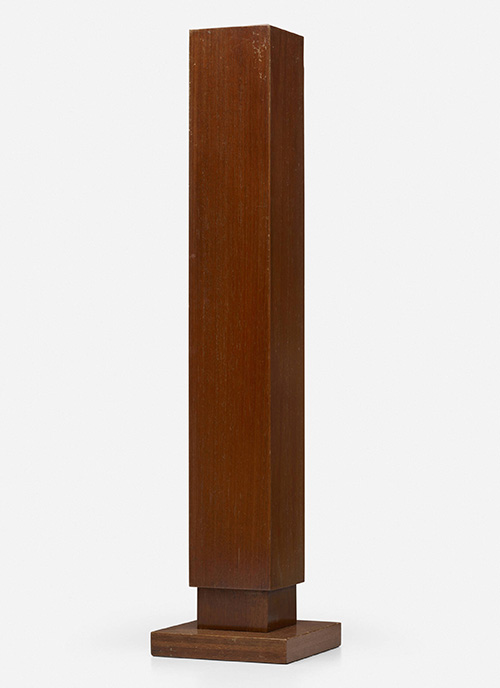
Prototype Tall Square Weed Vase, View: 2024. Prototype of the Tall Minic Square Weed Vase designed by Frank Lloyd Wright in 1953-1954 for the Taliesin Ensemble, which consisted of Furniture, Accessories, Fabric, Wallpaper, Carpet and Paint. Constructed of mahogany, the stem and base are square in shape. Wright designed, and Minic produced a number of variations of vases for the Taliesin Ensemble, from single to duo vases. This version of the Minic prototype vases appears to have been produced in two sizes. The shorter version, S#0987.135, and this taller version. On June 4, 2024, Toomey & Co. auctioned this taller version. It is 7" x 7" x 29.75" tall. The realized result was $4,032.
This taller Weed Vase was also from the William Minnich estate. Courtesy of Toomey & Co., Chicago. (ST#2024.09.1124)Minic Prototype Short and Tall Square Weed Vases, View: 2024.
Prototype of the tall and short Minic Square Weed Vases designed by Frank Lloyd Wright in 1953-1954 for the Taliesin Ensemble, which consisted of Furniture, Accessories, Fabric, Wallpaper, Carpet and Paint. Constructed of mahogany, the stem and base are square in shape. Wright designed, and Minic produced a number of variations of vases for the Taliesin Ensemble, from single to duo vases. To date, the Square Weed Vases appear to have been produced in two sizes. The taller version is 7" x 7" x 29.75" tall. The shorter, S#987.S#0987.135, is 5.5" x 5.5" deep by 19.75" tall. On June 4, 2024, Toomey & Co. auctioned the taller version. The realized result was $4,032.
Both Weed Vases were from the William Minnich estate. Courtesy of Toomey & Co., Chicago. Two separate photographs combined by Douglas M. Steiner to visually show size relationship between the two vases. (ST#2024.11.1124)
MINIC MONUMENTAL WEED-HOLDER Minic Monumental Weed-Holder 1953-1954. Minic Monumental Weed-Holder Prototype designed by Frank Lloyd Wright for the Taliesin Ensemble, which consisted of Furniture, Accessories, Fabric, Wallpaper, Carpet and Paint. Constructed of mahogany, the stem and base are square in shape, but is tapered from the bottom, to the top. The stem in rotated 45 degrees from the base.
The design for the vase was inspired from the slender weed-holder Frank Lloyd Wright designed around 1895. Wright began experimenting with variations for designs of weed-holders as early as 1894, Monograph 1887-1901, Pfeiffer, 1991, pages 60-61. John Lloyd Wright wrote "Not satisfied with the bric-a-brac of the day, Father designed his own. The copper weed-holders pictured to the right and left of the chair are his early creations. Father liked weeds!" My Father Who is on Earth, 1946, page 24.
It was one of Wright's favorite objects. He included it in a number of drawings and projects he worked on, including the Husser house, his own Home and Studio, the Dana house and Browne's Bookstore. By 1925, one was photographed in the Taliesin III Living Room, "Nature of Materials", Hitchcock, 1942, Plate 273.
In 1910 Frank Lloyd Wright produced the "Ausgeführte Bauten und Entwürfe von Frank Lloyd Wright" (S.87), published by Ernst Wasmuth, in Berlin. Wright included the weed-holder in Browne's Bookstore Plate XXXVI (36).
Taliesin Ensemble: “From the inception of the Taliesin Ensemble in 1953 to forming the partnerships and to finally introducing the line in 1955 in House Beautiful, these manufacturers were working against an extremely tight deadline. Some partners were able to go into production with their new creation while the others remained a concept with only a handful of prototypes made.
“One such partner was Minic Accessories. Valentine Minnich, the proprietor of Minic Accessories in New York, had been working with Gordon to create sets for the magazine's many photo shoots. The initial meeting between Minnich and Wright was arranged by Gordon in 1953, and took place at the Minic office in New York City. Minic occupied four floors in the building, in total measuring approximately 30,000 square feet. Valentine Minnich's son, William Minnich, was also in attendance at the meeting; he was only fourteen years old, but he had been apprenticing since he was five years of age. William recalls how his father and Wright were "kindred blood" and could understand each other from the moment they met.
“Wright wanted to create objects that were inspired by the slender weed-vase design from the 1890s, but made of wood; he asked for something “light in design and light in luminous energy and natural as in pure and as in uncultivated.” Valentine Minnich and his two sons were able to quickly draft dozens of sketches within two weeks of the meeting. With Wright's input, several prototypes were created in various woods including rosewood, white oak, American walnut, teak, birch, and mahogany.Wright liked mahogany the best and wanted to proceed with production. Ultimately, however, the pieces created by Minic Accessories were not mass-produced due to issues related to manufacturing. Only a handful of prototypes are known to exist today, with a few in prestigious private and institutional collections...” Toomey & Co. 2024.
This Minic Monumental Weed-Holder Prototype is one of those rare examples extant and comes from the collection of William Valentine Minnich. This vase was created in two sizes: 32" high and 44.125" high. This is the larger iteration of the two sizes, devised by Wright and Valentine Minnich. The manufacturer's foil label is affixed to the base: “Frank Lloyd Wright The Taliesin Line Manufactured by Minic Makers of Fine Interiors and Accessories.” Read William Mimmich’s first-hand account of the relationship between Frank Lloyd Wright and Valentine Minnich.
Although Minic produced prototypes of the accessories and furniture, Heritage Henredon was selected to mass produce the furniture line. The accessories, vases and planters, were not mass produced nor did they become part of the Heritage Henredon line. The prototypes produced by Minic have been carefully preserved.
This version of the Minic Weed-Holder prototype vase appears to have been produced in two size:: 32" high and 44.125" high. On October 19, 2023, two vases, a tall (43.5") and a short (32.75"), were sold at Sotheby’s. The price realized for the tall, Lot 82 was $10,795, and for the short, Lot 83, $6,096. On March 26, 2024, a tall (44.125") vase was sold at Toomey & Co. The price realized for Lot 259 was $9,450. On May 15, 2024, a short (31.5") vase was sold by Piasa Auction House, Paris. The price realized for Lot 65 was 6,500 Euro ($6,744). On June 4, 2024, A pair (2) of 32" vases were sold by Toomey & Co. The price realized for Lot 240 was $5,000.
A Short (32.5") vase is on display at the Metropolitan Museum of Art, New York. A copy of this vase sets on the floor in Frank Lloyd Wright’s Studio in Taliesin, Spring Green, ST#2016.26.0218-60.
This Monumental Weed-Holder Prototype vase was manufactured by Minic Accessories, USA. Constructed of mahogany and copper-anodized aluminum. The overall dimensions are 44.125" tall x 11.5" wide x 11.5" deep. The top of the stem measures 2.125" x 2.125". The base of the stem measures 4.5" x 4.5", then flares out to 5.75" x 5.75". The base is furned 45 degrees and is 11.5" x 11.5". The circular sleeve is constructed of copper-anodized aluminum. The diameter of the top lip of the sleeve 1.5". The diameter of the sleeve is 1.5" x 12.125" tall.
Provenance: Valentine Minnich, New York. Thence by descent to William Valentine Minnich. Size: 44.125" tall x 11.5" wide x 11.5" deep.
ILLUSTRATIONS / PLANS 1955 1) DINING ROOM WITH TALL VASE 2) BEDROOM WITH TALL VASE
3) LIVING ROOM WITH TALL VASE 4) DINING ROOM WITH TALL VASE
5 MONUMENTAL WEED-HOLDER 6 MONUMENTAL WEED-HOLDER1) HERITAGE-HENREDON DINING ROOM 1) Heritage-Henredon Four Square Dining Room Furniture, Perspective Illustration, 1955 (FLLW #5529.05). Perspective illustration of the Heritage-Henredon Four Square dining room furniture, designed by Frank Lloyd Wright in 1955, FLLW #5529.05. One of the items in this drawing is the design for the Tall Hexagonal Weed Vase, seen on the top left. Wright commissioned Minic to produce a prototype of the Tall Hexagonal Vase, which never became part of the full line of Wright designed Heritage-Henredon furniture. Minic produced all the prototypes for the line of furniture, Heritage-Henredon produced the line of furniture. The Tall Hexagonal Weed Vase remained a well preserved prototype. Lower text: “The Four Square, Heritage Henredon Fine Furniture. Frank Lloyd Wright, Architect.” Text lower left: “5529.05.” Text in square, lower right: “FLLW April 55.” (S#1092.268.0824) 1B) Detail of the Heritage-Henredon Four Square Dining Room Furniture, Perspective Illustration with Tall Hexagonal Weed Vase, 1955 (FLLW #5529.05). 2) HERITAGE-HENREDON BEDROOM 2) Heritage-Henredon Honeycomb Bedroom Furniture, Perspective Illustration, 1955 (FLLW #5529.41). Perspective illustration of the Heritage-Henredon Honeycomb bedroom furniture, designed by Frank Lloyd Wright in 1955, FLLW #5529.41. One of the items in this drawing is the design for the Tall Hexagonal Weed Vase, seen just to the left of the headboard. Wright commissioned Minic to produce a prototype of the Tall Hexagonal Vase, which never became part of the full line of Wright designed Heritage-Henredon furniture. Minic produced all the prototypes for the line of furniture, Heritage-Henredon produced the line of furniture. The Tall Hexagonal Weed Vase remained a well preserved prototype. Lower text: “The Honeycomb, Heritage Henredon Fine Furniture. Frank Lloyd Wright, Architect.” Text lower left: “5529.41.” (S#1092.269.0824) 2B) Detail of the Heritage-Henredon Honeycomb Bedroom Furniture, Perspective Illustration with Tall Hexagonal Weed Vase, 1955 (FLLW #5529.41). 3) HERITAGE-HENREDON LIVING ROOM 3) Heritage-Henredon Honeycomb Living Room Furniture, Perspective Illustration, 1955 (FLLW #5529.42). Perspective illustration of the Heritage-Henredon Honeycomb dining room furniture, designed by Frank Lloyd Wright in 1955, FLLW #5529.42. One of the items in this drawing is the design for the Tall Hexagonal Weed Vase, set in the center of the coffee table. Wright commissioned Minic to produce a prototype of the Tall Vase, which never became part of the full line of Wright designed Heritage-Henredon furniture. Minic produced all the prototypes for the line of furniture, Heritage-Henredon produced the line of furniture. The Tall Hexagonal Weed Vase remained a well preserved prototype. Lower text: “The Honeycomb, Heritage Henredon Fine Furniture. Frank Lloyd Wright, Architect.” Text lower left: “5529.42.” (S#1092.270.0824) 3B) Detail of the Heritage-Henredon Honeycomb Living Room Furniture, Perspective Illustration with Tall Hexagonal Weed Vase, 1955 (FLLW #5529.42). 4) HERITAGE-HENREDON DINING ROOM 4) Heritage-Henredon Honeycomb Dining Room Furniture, Perspective Illustration, 1955 (FLLW #5529.43). Perspective illustration of the Heritage-Henredon Honeycomb dining room furniture, designed by Frank Lloyd Wright in 1955, FLLW #5529.43. One of the items in this drawing is the design for the Tall Hexagonal Weed Vase, set on the cabinet to the far right. Wright commissioned Minic to produce a prototype of the Tall Hexagonal Vase, which never became part of the full line of Wright designed Heritage-Henredon furniture. Minic produced all the prototypes for the line of furniture, Heritage-Henredon produced the line of furniture. The Tall Hexagonal Weed Vase remained a well preserved prototype. Lower text: “The Honeycomb, Heritage Henredon Fine Furniture. Frank Lloyd Wright, Architect.” Text lower left: “5529.43.” (S#1092.271.0824) 4B) Detail of the Heritage-Henredon Honeycomb Dining Room Furniture, Perspective Illustration with Tall Hexagonal Weed Vase, 1955 (FLLW #5529.43). 5) MONUMENTAL WEED-HOLDER 5) Heritage-Henredon Four Square Bedroom Furniture, Perspective Illustration, 1955 (FLLW #5529.02). Perspective illustration of the Heritage-Henredon Four Square bedroom furniture, designed by Frank Lloyd Wright in 1955, FLLW #5529.02. Two of the items in this drawing are designs for the Tall Monumental Weed-Holder, seen on the left and right. Wright commissioned Minic to produce a prototype of the Monumental Weed-Holder, which never became part of the full line of Wright designed Heritage-Henredon furniture. It appears that two prototype sizes were produced. The design for the vase was inspired from the slender weed-holder Frank Lloyd Wright designed around 1895.
Minic produced all the prototypes for the line of furniture, Heritage-Henredon produced the line of furniture. The Monumental Weed-Holder remained a well preserved prototype. Lower text: “The Four Square, Heritage Henredon Fine Furniture. Frank Lloyd Wright, Architect.” Text lower left: “5529.02.” Text in square, lower right: “FLLW April 55.” (S#1092.281.0225)5B) Detail of the Heritage-Henredon Four Square Bedroom Furniture, Perspective Illustration, 1955 (FLLW #5529.02). 5C) Detail of the Heritage-Henredon Four Square Bedroom Furniture, Perspective Illustration, 1955 (FLLW #5529.02). 6) MONUMENTAL WEED-HOLDER 6) Heritage-Henredon Furniture, Cabinet Table and Accessories, Elevations and Plan, 1955 (FLLW #5529.10). Elevations and plan for the Heritage-Henredon Cabinet Table and Accessories, designed by Frank Lloyd Wright in 1955, FLLW #5529.10. One of the items in this drawing is a design for the Tall Monumental Weed-Holder, seen on the left. Wright commissioned Minic to produce a prototype of the Monumental Weed-Holder, which never became part of the full line of Wright designed Heritage-Henredon furniture. It appears that two prototype sizes were produced. The design for the vase was inspired from the slender weed-holder Frank Lloyd Wright designed around 1895.
Minic produced all the prototypes for the line of furniture, Heritage-Henredon produced the line of furniture. The Monumental Weed-Holder remained a well preserved prototype. Lower text: “Heritage Henredon. Frank Lloyd Wright, Architect.” Hand Written text lower left: “5529.10.” (S#1092.282.0225)6B) Detail of the Heritage-Henredon Furniture, Cabinet Table and Accessories, Elevations and Plan, 1955 (FLLW #5529.10). 1) VASE AND PLANTER 1955 1) Heritage-Henredon Living Room Furniture, 1955. Copy photograph of Heritage-Henredon living room furniture designed by Frank Lloyd Wright in 1955. One of the items in this photograph is the prototype of the Tall Hexagonal Weed Vase, set on the end table on the far left. Wright commissioned Minic to produce a prototype of the Tall Hexagonal Vase, which never became part of the full line of Wright designed Heritage-Henredon furniture. Minic produced all the prototypes for the line of furniture, Heritage-Henredon produced the line of furniture. A second tall rectangular vase can be seen in the background between the couch and chair. The Tall Hexagonal Weed Vase remained a well preserved prototype. Published in House Beautiful, November 1955, p.338. Caption: “All Wright's furniture is designed to group and re-group in interesting combinations, as this picture shows. Note how edge of sofa was made to receive the hexagonal hassock, which in turn composes with two others, as well as with other pieces in room. Note harmony of Wright accessories.” (S#1092.272.0824) 1B) Detail of the Heritage-Henredon Living Room Furniture, 1955. Copy photograph of Heritage-Henredon living room furniture designed by Frank Lloyd Wright in 1955. One of the items in this photograph is the prototype of the Tall Hexagonal Weed Vase. 2) Heritage-Henredon Line of Accessories, 1955. Copy photograph of Heritage-Henredon line of accessories designed by Frank Lloyd Wright in 1955. One of the items in this photograph is the prototype of the Rectangular Planter, set on the cabinet to the right. Wright commissioned Minic to produce a prototype of the Rectangular Planter, which never became part of the full line of Wright designed Heritage-Henredon furniture. Minic produced all the prototypes for the line of furniture, Heritage-Henredon produced the line of furniture. A tall rectangular vase and a square planter, both prototypes, can be seen on the left. The Rectangular Planter remained a well preserved prototype. Published in House Beautiful, November 1955, p.290. Caption: “Mr. Wright has designed a line of accessories in exotic woods (with metal liners) to hold flowers, branches of foliage, fruit, shells, or whatever you might want to display. Some match the mahogany furniture; others are of walnut, ebony, rosewood and holly.” (S#1092.273.0824) 2B) Detail of the Heritage-Henredon Line of Accessories, 1955. Copy photograph of Heritage-Henredon line of accessories designed by Frank Lloyd Wright in 1955. One of the items in this photograph is the prototype of the Rectangular Planter,
MINIC DUO VASE DETAILS 1) PLANS 2) PERSPECTIVE 3) HOUSE BEAUTIFUL 4) BROOKLYN MUSEUM 5) METROPOLITAN MUSEUM 6) HISTORIC ARTS
1) DUO VASE: PLANS 1955 1A) Heritage-Henredon Ornamental Vases, Details, 1955 (FLLW #5529.39). Detail plans for four Heritage-Henredon Four Square ornamental vases. 1) Tall Rectangular Vase. 2) Duo Vase. 3) Square Vase. 4) Hex Vase.
2) Duo Vase: There are two variations of the Duo Vase. On the top plan the neck, between the vase and the base, is thicker than the vases. See the Brooklyn Museum prototype. On the lower plan, the neck, between the vase and the base, is thinner than the vases. See the Metropolitan Museum of Art Prototype. Minic produced all the prototypes for the line of furniture, Heritage-Henredon produced the line of furniture. Lower text: “Heritage Henredon Fine Furniture. Frank Lloyd Wright, Architect.” Text lower right: “Ornamental Vases. The Four Square.” (S#1092.279.1024)1B) Detail of the Heritage-Henredon Ornamental Duo Vase, 1955 (FLLW #5529.39). Duo Vase: There are two variations of the Duo Vase. On the top plan the neck, between the vase and the base, is thicker than the vases. See the Brooklyn Museum prototype. On the lower plan, the neck, between the vase and the base, is thinner than the vases. 2) DUO VASE: PERSPECTIVE 1955 2A) Heritage-Henredon Four Square Living Room Furniture, Perspective Illustration, 1955 (FLLW #5529.04). Perspective illustration of the Heritage-Henredon Four Square living room furniture, designed by Frank Lloyd Wright in 1955, FLLW #5529.04. One of the items in this drawing is the design for the Double Vase, set on a cabinet on the right. Wright commissioned Minic to produce prototypes of the Double Vase, which never became part of the full line of Wright designed Heritage-Henredon furniture. Minic produced all the prototypes for the line of furniture, Heritage-Henredon produced the line of furniture. Lower right text: “The Four Square, Heritage Henredon Fine Furniture. Frank Lloyd Wright, Architect.” Text lower left: “5529.04.” (S#1092.280.1024) 2B) Detail of the Heritage-Henredon Four Square Living Room Furniture, Perspective Illustration, 1955 (FLLW #5529.04). 3) DUO VASE: HOUSE BEAUTIFUL 1955 3A) Heritage-Henredon Minic Double Vase, created 1953-1954, House Beautiful, November 1955.
Copy of photograph published in House Beautiful, November 1955, p.289. Setting on the table is a Minic prototype of the Double Vase designed by Frank Lloyd Wright for the Taliesin Ensemble. This vase is the version that matches the vase in the Brooklyn Museum collection. This vase differs from the Metropolitan Museum of Art prototype. The neck, between the vase and the base, is thicker than the vases.
Although Minic produced prototypes of the accessories and furniture, Heritage Henredon was selected to mass produce the furniture line. The accessories, vases and planters, were not mass produced nor did not become part of the Heritage Henredon line.
This prototype was produced by Minic Custom Woodwork Inc., New York in a collaboration with Frank Lloyd Wright. (S#1092.278.1024)3B) Detail of the Heritage-Henredon Minic Double Vase, created 1953-1954, House Beautiful, November 1955. 4) DUO VASE: BROOKLYN MUSEUM 1983 4) Heritage-Henredon Minic Double Vase, created 1953-1954, Brooklyn Museum, New York. View (1983) of the prototype of the Minic Double Vase designed by Frank Lloyd Wright for the Taliesin Ensemble, which consisted of Furniture, Accessories, Fabric, Wallpaper, Carpet and Paint. Constructed of mahogany, the Wright designed pattern is carved in the base. This vase is in the Brooklyn Museum collection.This vase differs from the Metropolitan Museum of Art prototype. The neck, between the vase and the base, is thickers than the vases.
This prototype was a gift from Minic Custom Woodwork Inc., New York, to the Brooklyn Museum in 1983. Vase size: 19.5" x 13.875" x 10.25". Vase constructed of mahogany. (ST#1983.66.1024)5) DUO VASE: METROPOLITAN MUSEUM 1983 5) Heritage-Henredon Minic Double Vase, created 1953-1954, Metropolitan Museum of Art. View (1983) of the prototype of the Minic Double Vase designed by Frank Lloyd Wright for the Taliesin Ensemble, which consisted of Furniture, Accessories, Fabric, Wallpaper, Carpet and Paint. Constructed of mahogany, the Wright designed pattern is carved in the base. This vase is in the Metropolitan Museum of Art collection. This vase differs from the Brooklyn Museum prototype. The neck, between the vase and the base, is thinner than the vases.
This prototype was a gift from Minic Custom Woodwork Inc., New York, to the Metropolitan Museum of Art in 1983. Vase size: 20" x 9.5" x 9.5". Vase constructed of mahogany and sheet metal. Courtesy of the Metropolitan Museum of Art. (ST#1983.65.1024)6) DUO VASE: HISTORIC ARTS 1992 6A) Heritage-Henredon Duo Vase, Historic Arts & Castings, 1992. Designed by Frank Lloyd Wright in 1955 for the Taliesin Ensemble, consisting of furniture, accessories, fabric, wallpaper, carpet and paint. A few prototypes were created by Minic Accessories in New York. We were able to locate three examples: 1) Metropolitan Museum of Art; 2) Brooklyn Museum; 3) Taliesin. This reproduction was produced in 1992 by Historic Arts & Casting, Inc. (ST#1992.164.0924) 6B) Heritage-Henredon Duo Vase, Historic Arts & Castings, 1992. 6C) Heritage-Henredon Duo Vase, Historic Arts & Castings, 1992. 6D) Heritage-Henredon Duo Vase, Historic Arts & Castings, 1992. 6E) Heritage-Henredon Duo Vase, Historic Arts & Castings, 1992. 6F) Heritage-Henredon Duo Vase, Historic Arts & Castings, 1992. 6G) Heritage-Henredon Duo Vase, Historic Arts & Castings, 1992. 6H) Heritage-Henredon Duo Vase, Historic Arts & Castings, 1992. TALL RECTANGULAR WEED VASE: HISTORIC ARTS 1992 1) PROTOTYPE 1953-1954 2) HOUSE BEAUTIFUL, NOVEMBER 1955 3) PLANS 1955 4) HISTORIC ARTS 1992
Heritage-Henredon Tall Rectangular Weed Vase, Historic Arts & Casting, Inc., 1992. Designed by Frank Lloyd Wright in 1955 for the Taliesin Ensemble, consisting of furniture, accessories, fabric, wallpaper, carpet and paint. A few prototypes were created by Minic Accessories in New York.
This vase was illustrated on a plan titled “Heritage Henredon Fine Furniture. Ornamental Vases, The Four Square.” The top and base were specified in copper, the neck in Olive wood. Height: 29" x 3.5" x 3.5." The base was 6.5" x 6.5." This vase is 16.375" x 1.75" x 1.75." The base is 3" x 3." The neck is finished to simulate olive wood. Below the simulated olive wood, the base is reduced to 1.5 x 1.5, then reduced in half to .75 x .75, then reduced in half again to .375 x .375, almost giving the appearance of the neck floating above the base.
Stamped in the base is the date 1992. We were unable to locate this vase in Historic Arts & Castings’ catalogs, but we did locate it in the Frank Lloyd Wright Preservation Trust Museum Catalog, 2006, Spring / Summer, page 2. Caption: “Tall Rectangular Vase. The distinct architectural styling of this cast bronze vase was originally intended to accompany a line of home furnishings Wright designed in 1955 for the Heritage-Henredon Furniture Company. 3" w x 16-1/4" h.” Original list price $498.00.
“From the inception of Taliesin Ensemble in 1953 to forming the partnerships and to finally introducing the line in 1955 in House Beautiful, these manufacturers were working against an extremely tight deadline. Some partners were able to go into production with their new creation (albeit for a short period of time) while the others remained a concept with only a handful of prototypes made.
“One such partner was Minic Accessories. Valentine Minnich, the proprietor of Minic Accessories in New York, had been working with Gordon to create sets for the magazine's many photo shoots. The initial meeting between Minnich and Wright was arranged by Gordon in 1953, and took place at the Minic office in New York City. Minic occupied four floors in the building, in total measuring approximately 30,000 square feet. Valentine Minnich's son, William Minnich, was also in attendance at the meeting; he was only fourteen years old, but he had been apprenticing since he was five years of age. William recalls how his father and Wright were "kindred blood" and could understand each other from the moment they met.
“Wright wanted to create objects that were inspired by the slender weed vase design from the 1890s, but made of wood; heasked for something “light in design and light in luminous energy and natural as in pure and as in uncultivated.” Valentine Minnich and his two sons were able to quickly draft dozens of sketches within two weeks of the meeting. With Wright's input, several prototypes were created in various woods including rosewood, white oak, American walnut, teak, birch, and mahogany. Wright liked mahogany the best and wanted to proceed with production. Ultimately, however, the pieces created by Minic Accessories were not mass-produced due to issues related to manufacturing. Only a handful of prototypes are known to exist today, with a few in prestigious private and institutional collections...” Toomey & Co., 2024. Read William Mimmich’s first-hand account of the relationship between Frank Lloyd Wright and Valentine Minnich.
Minic created a prototype of this vase. It was photographed for the November, 1955 issue of House Beautiful, and published on page 290 S#1092.273. It was manufactured in mahogany, with a painted top and base, and was 32" H x 6.5" x 6.5". On March 2, 2008, a Minic Prototype was sold at Toomey & Co., and the price realized was $9,500.
Although Minic produced prototypes of the accessories and furniture, Heritage Henredon was selected to mass produce the furniture line. Unfortunately the accessories, vases and planters, were not mass produced nor did not become part of the Heritage Henredon line.
In 1958, the Robert Llewellyn Wright house appeared to possibly have two of the very few Minic Prototypes of the Tall Weed Vases. One in the living room, S#1259.30.0513. , and one in the second master bedroom, S#1259.33.0513. During a visit to the house in 2020, we located one in the living room, ST#2020.05.1220 -15, but did not notice the second.
In 1992, Historic Arts & Casting produced The Metalwork Collection, consisting of designs by Frank Lloyd Wright and Louis Sullivan, some of which were produced for the first time. Heritage-Henredon Tall Rectangular Weed Vase. Overall: 16.375" x 1.75" x 1.75." Base: 3" x 3." The neck is finished to simulate olive wood. Below the simulated olive wood, the base is reduced to 1.5 x 1.5, then reduced in half to .75 x .75, then reduced in half again to .375 x .375, giving the appearance of the neck floating above the base.
Cast bronze vase. Engraved in base: Frank Lloyd Wright logo, “Frank Lloyd Wright Foundation, (C) (R) 1992". Historical Arts logo, "Historical Arts & Casting Inc.” (ST#1992.172.0525)
1) TALL RECTANGLE VASE: PROTOTYPE 1953-4 1) Minic Tall Weed Prototype Vase, 1953-1954.
Photograph of a Minic Tall Weed Prototype Vase designed by Frank Lloyd Wright for the Taliesin Ensemble, which consisted of Furniture, Accessories, Fabric, Wallpaper, Carpet and Paint. Constructed of mahogany, the top and base are painted. The overall dimensions are 32" H x 6.5" x 6.5".
Read William Mimmich’s first hand account of the relationship between Frank Lloyd Wright and Valentine Minnich. Although Minic produced prototype of the accessories and furniture, Heritage Henredon was selected to mass produce the furniture line. The accessories, vases and planters, were not mass produced nor did they become part of the Heritage Henredon line. The prototypes produced by Minic have been carefully preserved.
On March 2, 2008, this Minic Prototype was sold at Toomey & Co., and the price realized was $9,500. It may be the prototype photographed for the November, 1955 issue of House Beautiful, and published on page 290 S#1092.273. It was manufactured in mahogany, with a painted top and base, and was 32" H x 6.5" x 6.5". Courtesy of Toomey & Co., 2008. 8 x 10 Color photograph. (S#0987.138.0625)2) HOUSE BEAUTIFUL - NOVEMBER 1955 2) Heritage-Henredon Line of Accessories, 1955. Copy photograph of Heritage-Henredon line of accessories designed by Frank Lloyd Wright in 1955. One of the items in this photograph is the prototype of the Rectangular Planter, set on the cabinet to the right. Wright commissioned Minic to produce a prototype of the Rectangular Planter, which never became part of the full line of Wright designed Heritage-Henredon furniture. Minic produced all the prototypes for the line of furniture, Heritage-Henredon produced the line of furniture. A tall rectangular vase and a small square vase, both prototypes, can be seen on the left. The Rectangular Planter remained a well preserved prototype. Published in House Beautiful, November 1955, p.290. Caption: “Mr. Wright has designed a line of accessories in exotic woods (with metal liners) to hold flowers, branches of foliage, fruit, shells, or whatever you might want to display. Some match the mahogany furniture; others are of walnut, ebony, rosewood and holly.” (S#1092.273.0824) 3) TALL RECTANGULAR VASE: PLANS 1955 3) Heritage-Henredon Ornamental Vases, Details, 1955 (FLLW #5529.39). Detail plans for four Heritage-Henredon Four Square ornamental vases. 1) Tall Rectangular Vase. 2) Duo Vase. 3) Square Vase. 4) Hex Vase.
1) Tall Rectangular Weed Vase. The top and base were specified in copper, the neck in Olive wood. Height: 29" x 3.5" x 3.5." The base was 6.5" x 6.5." Minic produced all the prototypes for the line of furniture, Heritage-Henredon produced the line of furniture. Lower text: “Heritage Henredon Fine Furniture. Frank Lloyd Wright, Architect.” Text lower right: “Ornamental Vases. The Four Square.” (S#1092.279.1024)3B) Detail of the Heritage-Henredon Ornamental Vases, Details, 1955 (FLLW #5529.39). Detail plans for four Heritage-Henredon Four Square ornamental vases. 1) Tall Rectangular Vase. 4) HISTORIC ARTS 1992 4A) Heritage-Henredon Tall Rectangular Weed Vase, Historic Arts & Casting, Inc., 1992. Designed by Frank Lloyd Wright in 1955 for the Taliesin Ensemble, consisting of furniture, accessories, fabric, wallpaper, carpet and paint. A few prototypes were created by Minic Accessories in New York. (ST#1992.172.0525) 4B) Detail of the Heritage-Henredon Tall Rectangular Weed Vase, Historic Arts & Casting, Inc., 1992. Designed by Frank Lloyd Wright in 1955 for the Taliesin Ensemble. 4C) Detail of the Heritage-Henredon Tall Rectangular Weed Vase, Historic Arts & Casting, Inc., 1992. Designed by Frank Lloyd Wright in 1955 for the Taliesin Ensemble. 4D) Detail of the Heritage-Henredon Tall Rectangular Weed Vase, Historic Arts & Casting, Inc., 1992. Designed by Frank Lloyd Wright in 1955 for the Taliesin Ensemble. 4E) Detail of the Heritage-Henredon Tall Rectangular Weed Vase, Historic Arts & Casting, Inc., 1992. Designed by Frank Lloyd Wright in 1955 for the Taliesin Ensemble. 4F) Detail of the Heritage-Henredon Tall Rectangular Weed Vase, Historic Arts & Casting, Inc., 1992. Designed by Frank Lloyd Wright in 1955 for the Taliesin Ensemble. 4G) Detail of the Heritage-Henredon Tall Rectangular Weed Vase, Historic Arts & Casting, Inc., 1992. Designed by Frank Lloyd Wright in 1955 for the Taliesin Ensemble. 4H) Detail of the Heritage-Henredon Tall Rectangular Weed Vase and the Small Square Vase, Historic Arts & Casting, Inc., 1992. Designed by Frank Lloyd Wright in 1955 for the Taliesin Ensemble. SMALL SQUARE VASE "A": HISTORIC ARTS 1992 1) HOUSE BEAUTIFUL, NOVEMBER 1955 2) PLANS 1955 3) PERSPECTIVE 1955 4) HISTORIC ARTS 1992
Heritage-Henredon Small Square Vase “A”, Historic Arts & Casting, Inc., 1992. Designed by Frank Lloyd Wright in 1955 for the Taliesin Ensemble, consisting of furniture, accessories, fabric, wallpaper, carpet and paint. A few prototypes were created by Minic Accessories in New York.
This vase was illustrated on a plan titled “Heritage Henredon Fine Furniture. Ornamental Vases, The Four Square.” The plan included four different designs. 4) Small Square Vase “A”: The Small Square Vase is the smallest of the four variations, 8" x 8" x 8" with a 3/4" base. Each repeating square is recessed, 1.25" thick, leaving the inside square 3" x 3". The vase was specified in olive wood, the face of the outside square was specified in copper. Minic produced all the prototypes for the line of furniture, Heritage-Henredon produced the line of furniture.
Historic Arts description: “When Frank Lloyd Wright designed the "Four Square" line of furniture for his Heritage Henredon collection, he designed accessories as complements to the furniture pieces. Our Vase, the smallest of a series of four square vases, was originally designed in olive wood with a copper liner. Although it was never put into production, a prototype was made by the New York company, Minic. The prototype was used in the November 1955 issue of House Beautiful to help promote Wright'snew line of furnishings. Our reproduction is cast in bronze, it is designed to accommodate a standard 5.5" clay pot and is 8" square.”
Most Historic Arts pieces are stamped in the base with the the products date and information, but this piece is lacking the normal imprint. This leads us to wonder if it is a prototype? Original list price $1,500. In 1995 the list price was $2,000.
Minic created a prototype of this vase. It was photographed for the November, 1955 issue of House Beautiful, and published on page 290 S#1092.273. It was manufactured in mahogany.
Although Minic produced prototypes of the accessories and furniture, Heritage Henredon was selected to mass produce the furniture line. Unfortunately the accessories, vases and planters, were not mass produced nor did not become part of the Heritage Henredon line.
In 1992, Historic Arts & Casting produced The Metalwork Collection, consisting of designs by Frank Lloyd Wright and Louis Sullivan, some of which were produced for the first time. The Heritage-Henredon Small Square Vase “A” was specified in olive wood, the face of the outside square was specified in copper. Historic Arts vase cast in bronze, simulated copper and olive wood finish. Size: 8" x 8" x 8", base: 5" x 5" x .75. (ST#1992.172.0525)
1) HOUSE BEAUTIFUL - NOVEMBER 1955 1) Heritage-Henredon Line of Accessories, 1955. Copy photograph of Heritage-Henredon line of accessories designed by Frank Lloyd Wright in 1955. One of the items in this photograph is the prototype of the Rectangular Planter, set on the cabinet to the right. Wright commissioned Minic to produce a prototype of the Rectangular Planter, which never became part of the full line of Wright designed Heritage-Henredon furniture. Minic produced all the prototypes for the line of furniture, Heritage-Henredon produced the line of furniture. A tall rectangular vase and a small square vase, both prototypes, can be seen on the left. The Rectangular Planter remained a well preserved prototype. Published in House Beautiful, November 1955, p.290. Caption: “Mr. Wright has designed a line of accessories in exotic woods (with metal liners) to hold flowers, branches of foliage, fruit, shells, or whatever you might want to display. Some match the mahogany furniture; others are of walnut, ebony, rosewood and holly.” (S#1092.273.0824) 2) PLANS SMALL SQUARE VASE "A" 1955 2A) Heritage-Henredon Square Ornamental Vases, 1955 (FLLW #5529.29).
Detail plans for four Heritage-Henredon Four Square ornamental vases. D) Square Vase “D”. C) Square Vase “C”. 3) Square Vase “B”. 4) Small Square Vase “A”.
4) Small Square Vase “A”: The Small Square Vase is the smallest of the four variations, 8" x 8" x 8" with a 3/4" base. Each repeating square is recessed, 1.25" thick, leaving the inside square 3" x 3". The vase was specified in olive wood, the face of the outside square was specified in copper. Minic produced all the prototypes for the line of furniture, Heritage-Henredon produced the line of furniture. These vases were not mass produced. Lower text: “Heritage Henredon Fine Furniture. Frank Lloyd Wright, Architect.” Text lower right: “Ornamental Vases. The Four Square.” Hand written lower left: “5529.29.” (S#1092.295.0725)2B) Detail of the Heritage-Henredon Square Ornamental Vases, 1955 (FLLW #5529.29).
Detail plans for four Heritage-Henredon Four Square ornamental vases. D) Square Vase “D”. C) Square Vase “C”. 3) Square Vase “B”. 4) Small Square Vase “A”.
4) Small Square Vase “A”: The Small Square Vase is the smallest of the four variations, 8" x 8" x 8" with a 3/4" base. Each repeating square is recessed, 1.25" thick, leaving the inside square 3" x 3".3) PERSPECTIVE 1955 3A) Heritage-Henredon Four Square Bedroom Furniture, Perspective Illustration, 1955 (FLLW #5529.01).
Perspective illustration of the Heritage-Henredon Four Square bedroom furniture, designed by Frank Lloyd Wright in 1955, FLLW #5529.01. One of the items in this drawing is the design for the Small Square Vase “A”, set on the left side of the right dresser. Wright commissioned Minic to produce prototypes of the Small Square Vase, which never became part of the full line of Wright designed Heritage-Henredon furniture. Minic produced all the prototypes for the line of furniture, Heritage-Henredon produced the line of furniture. Lower right text: “The Four Square, Heritage Henredon Fine Furniture. Frank Lloyd Wright, Architect.” Text lower left: “5529.01.” (S#1092.296.0725)3B) Detail view of the Heritage-Henredon Four Square Bedroom Furniture, Perspective Illustration, 1955 (FLLW #5529.01).
Perspective illustration of the Heritage-Henredon Four Square bedroom furniture, designed by Frank Lloyd Wright in 1955, FLLW #5529.01. One of the items in this drawing is the design for the Small Square Vase “A”, set on the left side of the right dresser.4) HISTORIC ARTS 1992 4A) Heritage-Henredon Small Square Vase "A", Historic Arts & Casting, Inc., 1992. Designed by Frank Lloyd Wright in 1955 for the Taliesin Ensemble, consisting of furniture, accessories, fabric, wallpaper, carpet and paint. A few prototypes were created by Minic Accessories in New York. Created by Historic Arts in 1992. (ST#1992.173.0525) 4B) Detail of the Heritage-Henredon Small Square Vase, Historic Arts & Casting, Inc., 1992. Designed by Frank Lloyd Wright in 1955 for the Taliesin Ensemble. 4C) Detail of the Heritage-Henredon Small Square Vase, Historic Arts & Casting, Inc., 1992. Designed by Frank Lloyd Wright in 1955 for the Taliesin Ensemble. 4D) Detail of the Heritage-Henredon Small Square Vase, Historic Arts & Casting, Inc., 1992. Designed by Frank Lloyd Wright in 1955 for the Taliesin Ensemble. 4E) Detail of the Heritage-Henredon Small Square Vase, Historic Arts & Casting, Inc., 1992. Designed by Frank Lloyd Wright in 1955 for the Taliesin Ensemble. 4F) Detail of the Heritage-Henredon Small Square Vase, Historic Arts & Casting, Inc., 1992. Designed by Frank Lloyd Wright in 1955 for the Taliesin Ensemble. 4G) Detail of the Heritage-Henredon Tall Rectangular Weed Vase and the Small Square Vase, Historic Arts & Casting, Inc., 1992. Designed by Frank Lloyd Wright in 1955 for the Taliesin Ensemble. WILLIAM MIMMICH'S FIRST-HAND ACCOUNT
William Mimmich’s first-hand account of the relationship between Frank Lloyd Wright and Valentine Minnich. Published on WrightChat, Feb 09, 2022.
Taliesin Vases of Frank Lloyd Wright and the relationship with Minic of New York.
Mr. Wright and Minic were brought together by Elizabeth Gordon the editor of House Beautiful Magazine. Sometime in 1953 contact was made by Elizabeth Gordon to Minic about doing a project with Frank Lloyd Wright. She said that she would be setting up a meeting with those concerned and would get back to Minic as soon as Mr. Wright was available.
Minic had worked with Elizabeth Gordon, and House Beautiful magazine, for many years, doing many photo shoots and installations, and was trusted by her.
The meeting took place at my father’s offices on the 7th floor at 503 East 72nd Street in New York City. The building no longer exists but for years Minic occupied four floors of the eight in the building. Roughly 40,000 square feet of the building were devoted to Minic Display, Minic Accessories and Minic Custom Woodwork and contained their manufacturing facilities.
Present at the meeting were, Mr. Wright, Elizabeth Gordon, Mr. John deKoven Hill and others of Mr. Wright’s group, Mr. Valentine Minnich (known in the trades as Minic), Miss Adele Butor, Mr. Minnich’s executive secretary of many years ) and at Mr. Wright’s insistence, the two son’s of Mr. Minnich, Johann Adam Hans Minnich and William Valentine Minnich.
Mr. Wright and my father, Valentine Minnich, may have been of kindred blood for from the moment they met they both seemed to enjoy and understand one another. After shaking hands Mr. Wright opened the conversation with “Mr. Minic I am going to make you a millionaire “. I will never forget my father’s response in his heavy German accent “Mr. Frank Lloyd Wright just sit you here at my desk and sign the check now”. I think that with all the laughter that followed these two men understood that they could and that they would work together.
Mr. Wright was a very imposing figure at anytime but to a fourteen year old, that day, he created an image that has never left me even as I approach eighty two years of age. He was dressed in a wonderfully flowing cape, a wide brimmed hat, and he had this silver-tipped cane, which he seemed to use as a sword, and all of which made me think of him as Zorro correcting injustices in the world.
My brother and I may have been two of the youngest people who were able to work on a project with Mr. Wright. It may seem farfetched to think that my brother in his twenties and myself as a fourteen year old really had anything to do with this project but it is true.
One of the reasons that Mr. Wright was impressed with the Minic organization was that it was a” family organization” and that the family members - boys and girls -apprenticed from the very young age of five, so that by the time I was fourteen we had nine years of experience. This was very common, and one would say, customary in most European families. Mr. Wright even commented that “These young men know what they are about”.
Getting back to the meeting, Elizabeth Gordon laid out the project as proposed, and stated that Mr. Wright had envisioned the Taliesin Ensemble for a number of years but began to enter into serious consideration of this project somewhere in late 1952 or early 1953 at the urging of herself and Mr. deKoven Hill.
Mr. Wright then addressed the meeting with an idea based on a copper vase that he designed in the 1890’s and stated that he was interested in a design that would be similar but would be made of wood. He asked Minic to submit some ideas and sketches of not only this vase but of other pieces based on his musings.
Elizabeth Gordon, as editor of House Beautiful Magazine,worked on many projects with my father and she regarded him very highly both for his skill levels and the promptness he brought to a project.
She stated that the Taliesin Ensemble was to be ready to be marketed by late 1955 and that she knew Minic would be able to fulfill everything required. Well I can remember my father indicating that we should all start that very moment and with that he took up a pencil and sketched out a low rectangular planter.
Mr. Wright saw that my father had the quickness of the idea and asked that he refine the sketch. He then asked my father if he would consider doing pieces of furniture for the line. My father then told Mr. Wright that he would, within a week or two, submit ideas and sketches both for the vases and some furniture pieces. Then upon Mr. Wright’s approval and corrections would enter into prototype production for both the vases and the furniture.
This was agreed upon and the meeting ended with Mr. Wright and my father having a private discussion for about another twenty minutes. During this time my brother and I directed the attention of the others to the different floors of production.
Once everyone had left, my father called my brother and myself into his office. He stated that we would be working many hours just to come up with ideas in the next two weeks but that Mr. Wright had given him a hint of what we should strive for. He said Mr. Wright told him to “think light and natural in two ways, light in design and light in energy”. My father said he understood and started quick drawings of vases for my brother and I to contemplate and discuss and then, upon reflection, come up with some designs or ideas that would work.
Within the first week my father came up with three dozen sketches, eight designs, by my brother and two by myself. We made arrangements with Mr. Wright to bring all that we had to the Plaza Hotel where he was staying.
My brother and I made the first of many trips to the Plaza and I remember being very impressed by this beautiful place and the beautiful suite that Mr. Wright occupied. It was on the Fourth floor (I think it was suite 409) with tall arched windows and wonderful views of Central Park South and of Fifth Avenue.
Mr. Wright would sometimes take time, then and there, to go over the sketches and even asked our opinion of our designs, and he would comment on our responses. He would mark and make changes with pencil and throw out many of the sketches but if he liked any he corrected he would mark ‘prototype’ and a prototype would be placed into production that day. Minic submitted ideas, based on the thoughts of Mr. Wright, all of which had an eye to how difficult the pieces would be to produce. Some wonderful ideas were just too costly to produce.
Many prototypes were made in all types of wood such as rosewood, white oak, American walnut, teak, birch, mahogany, etc. etc. Mr. Wright loved the mahogany prototypes and that is what he selected for the entire Taliesin Ensemble.
Mr. Wright had to come to our manufacturing floors to see the furniture prototypes because of their size. He liked some and discarded others. It was at this time, all within five weeks, that my father told Mr. Wright that when mass production started he would be happy to do the vases but that “ he could not in good faith” promise, Mr. Wright, to meet a mass production schedule on the furniture line and still have the integrity of a Minic product.
Valentine Minnich was declining Frank Lloyd Wright. If Minic were to work on the Taliesin line the furniture portion would have to be done by others. Valentine Minnich knew he was taking a chance on losing any part of this new venture by Mr. Wright but my father’s ethical self-respect and the integrity of his product were on the line and he could not allow himself to do it any other way.
Mr. Wright actually applauded my father for his forthrightness and now Minic is a small part of the Frank Lloyd Wright history.
HERITAGE-HENREDON
Date: 1955
Title: Heritage-Henredon Honeycomb Lounge Chair Drawing 1955.
Description: Presentation drawing for the Heritage-Henredon Honeycomb Lounge Chair. "Heritage Henredon Fine Furniture. Frank Lloyd Wright Architect. The Honeycomb Lounge Chair." Signed "FLLW April 1955." According to Jane King Hession and Debra Pickrel, "...an array of mass-produced home furnishings products (were) designed by Wright but orchestrated by (Elizabeth) Gordon herself ... Wright designed three furniture lines for Heritage-Henredon: "The Honeycomb," based on triangular shapes; "The Burberry," on circular forms; and "The Four Square," on rectilinear geometries... In the end, only "The Four Square" was produced. Incorporating elements of the other two lines, it was renamed "The Taliesin Line." Frank Lloyd Wright in New York: The Plaza Years, 1954 - 1959, 2007, p.57-62. Views include: Front, Side, Section, Back and from the top. At least one prototype was produced and is on display at Taliesin, Spring Green (2016.26.0218 -146). For additional information see The Chairs of Frank Lloyd Wright, Yale, 1987. Thank you to Stafford Norris lll for identifying this chair for us. Courtesy of the Frank Lloyd Wright Archives, Avery Library.
Size: 10 x 8 B&W photograph.
S#: 1092.116.0619Date: 1955 Title: Wright designed Heritage-Henredon furniture (June 29, 1955).
Photographer: Fran Byne
Description: In 1955, Frank Lloyd Wright developed the "Taliesin Ensemble", a line of furnishings for those that did not live in one of his homes. Partnerships were formed with five companies: 1) Heritage-Henredon, a line of furniture designed by Wright. 2) Karastan, Rugs. 3) The Martin-Senour Company, the Taliesin Palette, 36 personally selected paint colors. 4) Minic, Accessories. 5) F. Schumacher & Co., Fabrics & Wallpaper designed by Wright. Clipping pasted to verso: "Frank Lloyd Wright, internationally famous architect, has designed his first line of furniture for the general public, it was learned last week. Rumors to that effects were verified when Wright conferred with officials of Heritage-Henredon..." Stamped on verso: "1955 Jun 29". Stamped on face; "Fran Byne, Photography". Image restored by Douglas M. Steiner.
Size: Original 8 x 10 B&W photograph.
S#: 1092.41.0811
Date: 1955 Title: Heritage-Henredon furniture 1955. Wright designed Heritage-Henredon line of furniture in 1955.
Description: Dining and Living Room furniture includes (L to R): Moveable Bookshelf atop a chest of drawers shows versatility of Frank Lloyd Wright's design; Dining room table with six side chairs; Expandable sofa (four pieces); Square cocktail table, original price $89.75 each. Just behind the left end of the sofa is a tall weed holder or vase. Of note is the Nakomis Sculpture, top left on the bookshelf. In 1924 Frank Lloyd Wright was commissioned to design the Memorial Gateway to the Nakoma subdivision, which at the time was on the outskirts of Madison. Wright's plans were well received by the Madison Realty Company. Wright created models of the Nakoma and Nakomis sculptures which were photographed on August 3, 1926 at Taliesin, Spring Green. In 1929-30, Charles L. Morgan created terra-cotta models of the Nakoma and Nakomis. Could this be a copy of one of the terra-cotta figures? (Left side of the room. See 1092.60 for right side.)
Size: 10 x 8 B&W photograph.
S#: 1092.61.0314
Date: 1955 Title: Heritage-Henredon furniture 1955. Wright designed Heritage-Henredon line of furniture in 1955.
Description: Living Room furniture includes: Expandable sofa (four pieces); Square cocktail table, original price $89.75 each (five pieces); Round cushioned revolving stool, original price $89 (single piece far right). Of note is the white Nakoma Sculpture to the right, atop the table. In 1924 Frank Lloyd Wright was commissioned to design the Memorial Gateway to the Nakoma subdivision, which at the time was on the outskirts of Madison. Wright's plans were well received by the Madison Realty Company. Wright created models of the Nakoma and Nakomis sculptures which were photographed on August 3, 1926 at Taliesin, Spring Green. In 1929-30, Charles L. Morgan created terra-cotta models of the Nakoma and Nakomis. Could this be a copy of one of the terra-cotta figures? Clipping pasted to verso: "Sofas, fabrics and occasional stock-on tables all are included in the new furniture designed by Frank Lloyd Wright. Backs of sofas are customary height, but seats are a little lower than most. Tables can be used singly, in pairs or stacked to make a lamp table, as are at end of sofa." Stamped on clipping: "Oct 18 1955." (Right side of the room. See 1092.61 for left side.)
Size: 10 x 8 B&W photograph.
S#: 1092.60.0314
Date: 1955 Title: Heritage-Henredon furniture 1955. Wright designed Heritage-Henredon line of Living Room furniture in 1955.
Description: Living Room furniture includes (L to R): Hexagonal hassock, original price $129 each (three pieces); Hexagonal accessory table, short, original price $$82.50 (two pieces); End tables, tall (two pieces, left and right of sofa); Sofa - Bumper end piece, original price $349 (two pieces); Hexagonal table with six triangle tables that can double as seats when equipped with small cushion (two cushions shown); Lounge chair, original price $237, (two shown). A tall weed holder or vase, sits atop the end table to the right of the sofa.
Size: 10 x 8 B&W photograph.
S#: 1092.62.0314
Date: 1955 Title: Heritage-Henredon furniture 1955.
Description: Frank Lloyd Wright designed Heritage-Henredon line of furniture in 1955. Living Room furniture includes (L to R): Expandable sofa (two pieces); two Lounge Chairs, foreground: two Triangular seat-tables on either side of hexagonal coffee table. two triangular cushions, one triangular seat-table in window. Clipping pasted to verso: "Triangular seat-tables store under hexagonal coffee table, point up versatility of Frank Lloyd Wright's new collection. (Heritage-Henredon)." Stamped on verso: "Oct 18 1955."
Size: Original 9 x 7.1 B&W photograph.
S#: 1092.68.0414
Date: 1955 Title: Heritage-Henredon furniture 1955.
Description: Frank Lloyd Wright designed Heritage-Henredon line of furniture in 1955. Four-tiered shelf doubles as a dining room hutch and as a room divider. Shelves sit atop rectangular coffee table. Triangular seat-table is in the foreground. Bed frame can be seen in the background. Clipping pasted to verso: "Four-tiered deck atop rectangular coffee table makes an attractive room divider. Other side of deck has glass-enclosed shelves. (Heritage-Henredon)." Stamped on verso: "Oct 18 1955."
Size: Original 7.1 x 9 B&W photograph.
S#: 1092.69.0414
Date: 1955 Title: Wright designed Heritage-Henredon furniture
Photographer: Wesley Bowman Studio
Description: Wright designed Heritage-Henredon furniture. Press Release photograph for promotion of the Heritage-Henredon line of Wright designed furniture. In 1955, Wright developed the "Taliesin Ensemble", a line of furnishings for those that did not live in one of his homes. Partnerships were formed with F. Schumacher & Co. to produce the Taliesin Line of fabrics and wall coverings designed by Wright. Martin-Senour developed the Taliesin Palette, 36 personally selected Martin-Senour Colors. Karastan manufactured rugs. Minic manufactured Accessories, and Heritage-Henredon developed a line of furniture designed by Wright. For more information and ads for each of the companies, see the November 1955 issue of House Beautiful. Photographed by Wesley Bowman Studio, Chicago. Stamped on verso: "Jan 6 - 1956", "Wesley Bowman Studio, Chicago". Acquired from the archives of the Baltimore-Sun.
Size: Original 10 x 8 B&W photograph.
S#: 1147.46.0411
Date: 1955 Title: Heritage-Henredon furniture 1955. Rectangle Dining Room Table and chairs.
Description: The edge of the dining room table repeats an engraved pattern. Chair fabric, table cloth and curtains are by Schumacher fabrics, part of the Frank Lloyd Wright designed "Taliesin Ensemble." Wright designed the Heritage-Henredon line of furniture in 1955. Clipping pasted to verso: "Chairs upholstered in green linen of Frank Lloyd Wright's design complement lower-than-usual dining table in this grouping. (Heritage-Henredon)." Stamped on verso: "Oct 18 55." Typed on verso: "Furniture designed by Frank Lloyd Wright."
Size: Original 9 x 7.1 B&W photograph.
S#: 1092.76.1014
Date: 1955 Title: Heritage-Henredon Dining Room furniture 1955.
Description: Frank Lloyd Wright resting his arm on a piece of Heritage-Henredon dining room furniture. A cane is hanging on his left arm, a hat in his hand. His reflection is in a Heritage-Henredon mirror. Caption pasted to the verso: "Some people think it's 'Western,' but that's because of its natural matte finish on mahogany and carving at the edges. The carving is based on the Greek key design and that's hardly 'Western.' Some critics think it harkens back to the dark age of furniture design, specifically, the first 25 years of this century. Again, that's because some of the lines are so strong and so perfect in scale that they seem to some to be in poor taste. We're not used to seeing velvet upholstery on modern furniture and Wright has used it on some occasional chairs. It reminds many people of the poorly designed velvet chair grandmother kept in her parlor, the one nobody dared use." Stamped on clipping: "Oct 18 1955." Stamped on verso: "Heritage Furniture Inc."
Size: 8 x 6.5 B&W photograph.
S#: 1092.78.0115
Date: 1955 Title: Heritage-Henredon furniture 1955.
Description: Wright seated at a Heritage-Henredon dining room table. Table and chair designed by Wright. This is actually two photographs glued together in 1955. Background image is a photograph of Schumacher wallpaper design No. 103. Image is published in "Schumacher's Taliesin Line," page 3, bottom. Hidden behind the photograph of Wright is a side chair and end table from the Heritage-Henredon line of furniture designed by Wright in 1955. Hand written on verso, "17/11/55" (November 17, 1955).
Size: Original 8 x 10 B&W photograph.
S#: 1092.70.0514
Date: 1955 Title: Schumacher/Heritage-Henredon Dining Room 1955.
Description: This is a copy of the photograph published in the "Schumacher's Taliesin Line of Decorative Fabrics and Wallpaper," Schumacher/Wright, 1955, as an example of "Design No. 705" fabric and wallpaper. A similar design was used in 2001 at the Nakoma Clubhouse, Cleo, CA. The furniture was produced by Heritage-Henredon, designed by Frank Lloyd Wright. The buffet cabinet in the background is a combination of three small chests, No. 2002 (L), 2003 and 2001 (R). The table appears to be possibly a prototype of the dining room tables to come. The legs are correct, with the bullnose outer edge and carved patterned design. The round table top has the bullnose edge, but no design. To date, we have seen rectangular table tops as well as other furniture with the decorative design, but the round table tops, No. 2000 and 2001, are trimmed with copper moulding. The chairs do not appear to be designed by Wright, and were possibly used due to the lack of samples at the time. There is a note in House Beautiful, November, 1955, p.282 which might shed some light in explaining the discrepancies. "Much of this merchandise was not available for photograph as this issue went to press..." (Thanks to Peter Kelley, MassModern for his insight.) See additional information about the Nakoma Clubhouse.
Size: 10 x 8 B&W photograph.
S#: 1092.93.0416
Date: 1955 Title: Schumacher/Heritage-Henredon Dining Room 1955.
Description: This is a copy of the photograph published in House Beautiful, November, 1955, p.283. Drapes and wallpaper are "Design No. 705", "Schumacher's Taliesin Line of Decorative Fabrics and Wallpaper," Schumacher/Wright, 1955, fabric and wallpaper. A similar design was used in 2001 at the Nakoma Clubhouse, Cleo, CA. The furniture was produced by Heritage-Henredon, designed by Frank Lloyd Wright. The buffet cabinet in the background is a combination of four small chests (L to R), No. 2003, 2002, 2003 and 2001. The shelf was an optional add-on. The table appears to be possibly a prototype of the dining room tables to come. The legs are correct, with the bullnose outer edge and carved patterned design. The round table top has the bullnose edge, but no design. To date, we have seen rectangular table tops as well as other furniture with the decorative design, but the round table tops, No. 2000 and 2001, are trimmed with copper moulding. The bench is No. 1904. There is a note in House Beautiful, November, 1955, p.282 which might shed some light in explaining the discrepancies. "Much of this merchandise was not available for photograph as this issue went to press..." (Thanks to Peter Kelley, MassModern for his insight.) See additional information about the Nakoma Clubhouse.
Size: 8 x 10 Color photograph.
S#: 1092.94.0416
Date: 1955
Title: Frank Lloyd Wright designed Heritage Henredon Dining Room Table.
Description: In 1955, Frank Lloyd Wright developed the "Taliesin Ensemble", a line of furnishings for those that did not live in one of his homes. Partnerships were formed with five companies, one of which was Heritage-Henredon, a line of furniture designed by Wright. Round table with three conforming leaves. Circular top with decorative copper band, supported by an open cruciform base. Suspended central leg drops down to support the center when the table is extended. Table and leaves are stamped with Frank Lloyd Wright's signature. Table extends to 8 feet. Vertical edge of table legs repeat pattern in the copper trim. Constructed of mahogany.
Size: 48" round x 29" high, each leaf is 16" wide, table extends to 96" long.
S#: 1092.75.0314
Left: Table and leaves are stamped with Frank Lloyd Wright's signature.
Right: The table and leaf edges are decorated with a patterned copper band.
Detail of the patterned table leg design.
Left: Underside suspended central leg drops down to support the center when the table is extended.
Right: Each piece (table and three leaves) are stamped with "No. 2000" in black ink. Possibly the table number.
Table underside is stamped with "77", possibly the model number. Table is stamped with 77L (left) and 77R (right). Three leaves are stamped with corresponding 77L, 77R and 77C (center).
Underside table locks.
Date: 1955
Title: Frank Lloyd Wright designed Heritage Henredon Dining Room Chairs.
Description: In 1955, Frank Lloyd Wright developed the "Taliesin Ensemble", a line of furnishings for those that did not live in one of his homes. Partnerships were formed with five companies, one of which was Heritage-Henredon, a line of furniture designed by Wright. The back of the chair is slanted, and padded. Both edges, front and back, repeat the pattern Wright designed for the legs and edges of the table. Chair spindles are turned at a 45 degree angle. Two side chairs, constructed of mahogany, original Frank Lloyd Wright designed fabric.
Size: 21 Wide x 22 Deep x 32 High, Seat Height 18 inches.
S#: 1092.109.0618 (1-2)Date: 1955
Title: Heritage Henredon. Frank Lloyd Wright designed Heritage Henredon Double Bed Headboard.
Description: In 1955, Frank Lloyd Wright developed the "Taliesin Ensemble", a line of furnishings for those that did not live in one of his homes. Partnerships were formed with five companies, one of which was Heritage-Henredon, a line of furniture designed by Wright. The front edge of the headboard repeats the Taliesin patter on the top and both sides. Constructed of mahogany. Stamped on verso: "No. 2000." Unsigned.
Size: 54" wide, 38.5" high, 1.5" thick.
S#: 1092.111.0918Date: 1958 Title: Robert Llewellyn Wright Residence Bethesda, Maryland (1953 - S.358).
Description: Dining Room viewed from the Living Room. Photographed in 1958, after construction was completion. The intersection of the circular design forms less than a 90 degree angle. Built-in circular Dining Room table is on the left. Behind it on the left are built-in shelves. Built-in cabinets are in the background. Note the vertical double vase on the dining room table to the left. Most likely designed by his father. Very similar to the double vase designed by Wright for Heritage Henredon in 1955. Stamped on verso: "Robert L. Wright: Home. 284 - 184. Dec 24 1958." Photographed by Larry L. Stevens. Robert Llewellyn was Frank Lloyd Wright's sixth child.
Size: Original B&W 8 x 10 photo.
S#: 1259.26.0513
Left: Detail of the first vertical double vase seen in the Kitchen above. Most likely designed by Frank Lloyd Wright. Very similar to the double vase designed by Wright for Heritage Henredon (right) in 1955.
Right: Heritage Henredon Double Vase (1955). It was intended to accompany the line of furniture designed by Wright. It was not produced, but prototypes were made by Minic, a New York company. Photos appeared in the November 1955 issue of the House Beautiful. Courtesy of S.C. Johnson Collection.
Date: 1958 Title: Robert Llewellyn Wright Residence Bethesda, Maryland (1953 - S.358).
Description: View of the Living Room from the Eastern end. Photographed in 1958, after construction was completion. Llewellyn, as he was known, looks out of the floor to ceiling doors and windows of the Southern side of the circular wall. The Southern wall consists of equally sized windows and doors, where every other panel opens. One window in the Dining area opens, four floor to ceiling doors open, and three windows open above built-in cabinets in the foreground on the left. All open outward. In between each glass panel is a one foot full length glass panel. A second vertical double vase can be seen on the built-in cabinet on the left. The circular fireplace in on the far right. Circular lines embedded in the Cherokee red concrete floor are at three foot increments. Stamped on verso: "Robert L. Wright: Home. 284 - 184 - 3. Nov 2 - 1958." Photographed by Larry L. Stevens. Robert Llewellyn was Frank Lloyd Wright's sixth child.
Size: Original B&W 8 x 10 photo.
S#: 1259.28.0513
Left: Detail of the second vertical double vase seen in the Living Room above. Most likely designed by Frank Lloyd Wright. Very similar to the double vase designed by Wright for Heritage Henredon (right) in 1955.
Right: Heritage Henredon Double Vase (1955). It was intended to accompany the line of furniture designed by Wright. It was not produced, but prototypes were made by Minic, a New York company. Photos appeared in the November 1955 issue of the House Beautiful. Courtesy of S.C. Johnson Collection.
Date: 1958 Title: Robert Llewellyn Wright Residence Bethesda, Maryland (1953 - S.358).
Description: View of the Eastern end of the Living Room. Photographed in 1958, after construction was completion. Llewellyn's wife Elizabeth, relaxes on the built-in Living Room seating. Built-in cabinets on the right. Note the tall vertical vase just to the right of Elizabeth. Most likely designed by Llewellyn's father. It is very similar to the vase designed by Wright for Heritage Henredon in 1955. Stamped on verso: "Robert L. Wright: Home. 284 - 184. Dec 24 1958." Photographed by Larry L. Stevens. Robert Llewellyn was Frank Lloyd Wright's sixth child.
Size: Original B&W 8 x 10 photo.
S#: 1259.30.0513
Left: Detail of the first vertical vase seen in the Living Room above. Most likely designed by Frank Lloyd Wright. Very similar to the vase designed by Wright for Heritage Henredon (right) in 1955.
Right: Heritage Henredon Vase (1955). It was intended to accompany the line of furniture designed by Wright. It was not produced, but prototypes were made by Minic, a New York company. Photos appeared in the November 1955 issue of the House Beautiful. 6.5" x 6.5" x 32". Courtesy of Treadway Galleries.
Date: 1958 Title: Robert Llewellyn Wright Residence Bethesda, Maryland (1953 - S.358).
Description: View of the second level Master Bedroom looking toward the western corner. Photographed in 1958, after construction was completion. Doors on the far left open outward to the Balcony. Built-in shelving covers the Northern exterior wall. To the left is a built-in cabinet or night stand. Llewellyn's wife Elizabeth is straightening the pillows. Note the tall vertical vase to the left of Elizabeth behind the chair. Most likely designed by Llewellyn's father. It is very similar to the vase designed by Wright for Heritage Henredon in 1955. Stamped on verso: "Robert L. Wright: Home. 284 - 184 - 5. Nov 2 - 1958." Photographed by Larry L. Stevens. Robert Llewellyn was Frank Lloyd Wright's sixth child.
Size: Original B&W 8 x 10 photo.
S#: 1259.33.0513
Left: Detail of a second vertical vase seen in the Mastere Bedroom above. Most likely designed by Frank Lloyd Wright. Very similar to the vase designed by Wright for Heritage Henredon (right) in 1955.
Right: Heritage Henredon Vase (1955). It was intended to accompany the line of furniture designed by Wright. It was not produced, but prototypes were made by Minic, a New York company. Photos appeared in the November 1955 issue of the House Beautiful. 6.5" x 6.5" x 32". Courtesy of Treadway Galleries.
Date: 1955 Title: Chicago Daily News - 11-19-55 (Published by the Chicago Daily News, Chicago)
Author: John M. Smyth Co.; Henredon
Description: Ad: Heritage-Henredon. "Frank Lloyd Wright ...Now applies to furniture a genius that is world-renowned. Expertly Made... by Heritage-Henredon. Frank Lloyd Wright, the prophet of new ideas in architecture, now for the first time applies his visionary ability to designing a group of dining rooms, bedroom and living room furniture." Includes illustrations and original prices. Digital reprint. Courtesy of the Henredon Blog.
Size: 8 x 11.25
Pages: Pp 3 (Roto)
S#: 1092.63.0314
Date: 1955 Title: Detroit Free Press - November 29, 1955 (Published by the Detroit Free Press)
Author: Braun, Lilian Jackson
Description: "Four and about women. What Frank Lloyd Wright Would Put in Your Home. The most talked-about furniture in decades is the furniture designed for ordinary, everyday people - by Frank Lloyd Wright. The venerable gentleman (86 last June) has been proclaimed by many as the greatest architect of the past 500 years and compared to the versatile genius Leonardo de Vinci..." Includes four photographs. Digital reprint. Courtesy of the Henredon Blog.
Size: 8.25 x 12
Pages: Pp --
S#: 1092.64.0314
Date: 1955 Title: Seattle Times Pictorial - December 25, 1955 (Published by The Seattle Times, Seattle)
Author: Phillips, Margery R.
Description: "Furniture by Frank Lloyd Wright. Thus it is that this great architect has turned a talented hand to the designing of furniture to better integrate the site, the house and the interior. Few of us have an opportunity to see the fabulous houses for which Frank Lloyd Wright is noted throughout the world. Until the past few months, the custom-made furniture that Wright designed to grace these homes was noted only in photographs..." Includes eight photographs. Digital reprint. Courtesy of the Henredon Blog.
Size: 8 x 9.5
Pages: Pp 6-7
S#: 1092.65.0314
Date: 1973 Title: Frank Lloyd Wright: Yellowstone Art Center, Billings, Montana, October 1 - November 17, 1973. "The Selected Work of Frank Lloyd Wright: 1887 - 1959. An exhibition at the Yellowstone Art Center, Billings, Montana. (Soft Cover) (Published by the Yellowstone Art Center, Billings, Montana)
Author: Yellowstone Art Center, Introduction by Pfeiffer, Bruce Brooks
Description: A catalog folder with 16 single sheets printed both sides. This is the first time in over ten years that a comprehensive exhibition of the work of Frank Lloyd Wright has been made available to the public... He never touched his pencil to paper for any new design until the project was so crystallized in s min tat he was... 'walking around inside the building, placing bowls of flowers, and arranging furniture... ...the furniture of Frank Lloyd Wright was constructed by the Yellowstone Art Center craftsman from the original designed for Heritage Henredon Fine Furniture, Inc. This is unique because this furniture has never been built before, and now, a record is available for all time." Photographs of the Heritage Henredon furniture includes High and Low Back Chairs, Low Back Chair with Arms, three different Hassocks and Footstool. Includes four photographs of the exhibitions, and 23 illustrations. (First Edition) (Sweeney 1910)
Pages: 32
S#: 1910.00.0904
In 1973, the Yellowstone Art Center, Billings, Montana exhibited never produced Frank Lloyd Wright designed "Four Square" furniture including a high back chair, low back chair with and without arm, three different hassocks, and a footstool built specifically for the exhibition. Also on display were large "Four Square" boxes, used as display pedestals, but almost appear as end tables. The high back chair, low back chair with arms and one of the hassocks were later published in "The Prairie School Tradition," 1979/1985, p.112-113.
Frank Lloyd Wright "Four Square" High Back Chair designed for the Heritage Henredon Line of Fine Furniture, 1955/1973. Caption: "High Back Chair. Designed by Frank Lloyd Wright initially for the Heritage Henredon Fine Furniture in 1955. Never before constructed. Built specifically for this exhibition by Yellowstone Art Center Craftsmen." Published in Frank Lloyd Wright: Yellowstone Art Center. Courtesy of the Yellowstone Art Center. (See additional Wright Chairs.)
Frank Lloyd Wright "Four Square" Low Back Chair With Arms designed for the Heritage Henredon Line of Fine Furniture, 1955/1973. Caption: "Low Back Chair With Arms. Designed by Frank Lloyd Wright initially for the Heritage Henredon Fine Furniture in 1955. Never before constructed. Built specifically for this exhibition by Yellowstone Art Center Craftsmen." Published in Frank Lloyd Wright: Yellowstone Art Center. Courtesy of the Yellowstone Art Center. (See additional Wright Chairs.)
Frank Lloyd Wright "Four Square" Low Back Chair designed for the Heritage Henredon Line of Fine Furniture, 1955/1973. Caption: "Low Back Chair. Designed by Frank Lloyd Wright initially for the Heritage Henredon Fine Furniture in 1955. Never before constructed. Built specifically for this exhibition by Yellowstone Art Center Craftsmen." Published in Frank Lloyd Wright: Yellowstone Art Center. Courtesy of the Yellowstone Art Center. (See additional Wright Chairs.)
Frank Lloyd Wright "Four Square" Hassock designed for the Heritage Henredon Line of Fine Furniture, 1955/1973. Caption: "Hassock. Designed by Frank Lloyd Wright initially for the Heritage Henredon Fine Furniture in 1955. Never before constructed. Built specifically for this exhibition by Yellowstone Art Center Craftsmen." Published in Frank Lloyd Wright: Yellowstone Art Center. Courtesy of the Yellowstone Art Center. (See additional Wright Chairs.)
Frank Lloyd Wright "Four Square" Hassock designed for the Heritage Henredon Line of Fine Furniture, 1955/1973. Caption: "Hassock. Designed by Frank Lloyd Wright initially for the Heritage Henredon Fine Furniture in 1955. Never before constructed. Built specifically for this exhibition by Yellowstone Art Center Craftsmen." Published in Frank Lloyd Wright: Yellowstone Art Center. Courtesy of the Yellowstone Art Center. (See additional Wright Chairs.)
Frank Lloyd Wright "Four Square" Hassock designed for the Heritage Henredon Line of Fine Furniture, 1955/1973. Caption: "Hassock. Designed by Frank Lloyd Wright initially for the Heritage Henredon Fine Furniture in 1955. Never before constructed. Built specifically for this exhibition by Yellowstone Art Center Craftsmen." Published in Frank Lloyd Wright: Yellowstone Art Center. Courtesy of the Yellowstone Art Center. (See additional Wright Chairs.)
Frank Lloyd Wright "Four Square" Footstool designed for the Heritage Henredon Line of Fine Furniture, 1955/1973. Caption: "Footstool. Designed by Frank Lloyd Wright initially for the Heritage Henredon Fine Furniture in 1955. Never before constructed. Built specifically for this exhibition by Yellowstone Art Center Craftsmen." Published in Frank Lloyd Wright: Yellowstone Art Center. Courtesy of the Yellowstone Art Center. (See additional Wright Chairs.)
Frank Lloyd Wright Exhibition, Main Gallery View, 1973. Caption: "Frank Lloyd Wright Exhibition - Main Gallery View." Includes one "Four Square" box, used as display pedestal for High Back Chair, but almost appears as an end table. Published in Frank Lloyd Wright: Yellowstone Art Center. Courtesy of the Yellowstone Art Center.
Frank Lloyd Wright Exhibition, Main Gallery View, 1973. Caption: "31, Frank Lloyd Wright Exhibition - Main Gallery View." Includes two "Four Square" boxes, used as display pedestals for two Hassocks, but almost appear as end tables. Published in Frank Lloyd Wright: Yellowstone Art Center. Courtesy of the Yellowstone Art Center.
Date: 2003
Title: Four Square Ornamental Cube Vase, 2003.
Description: In 1955 Frank Lloyd Wright designed three lines of furniture for production by Heritage Henredon. The Burberry, The Honeycomb and The Four Square. Only the Four Square line was produced and was presented in the November 1955 issue of House Beautiful. Wright also designed accessories, but only prototypes were produced, two of which were published in the November 1955 House Beautiful, a tall vase and an 8" x 8" square vase, p.290. The four square design was woven into the furniture as well as fabric. In 1973, the Yellowstone Art Center, Billings, Montana exhibited never produced "Four Square" furniture including a high back chair, low back chair with and without arm, three different hassocks, and a footstool built specifically for the exhibition. Also on display were large "Four Square" boxes, used as display pedestals, but almost appear as end tables. The high back chair, low back chair with arms and one of the hassocks were later published in "The Prairie School Tradition," 1979/1985, p.112-113. In 1996, Historical Arts and Casting produced a line Frank Lloyd Wright decorative designs, which included a few of the Heritage-Henredon designed accessories, one of which was the Four Square Ornamental Cube Vase. A larger 8" square, produced to give the appearance it was manufactured in copper, and finished with a natural patina finish, and a smaller 4" square cube produced in pewter. Engraved in base: Historical Arts logo, "Historical Arts & Casting" and the Frank Lloyd Wright logo, "Frank Lloyd Wright Collection. Stamped (number): "01574." Historical Arts & Casting Inc. 5580 West Bagley Park Road, West Jordon, UT 84088. Original retail cost $96.00.
Size: 4" square cube
ST#: 2003.55.1116
Date: 2014 Title: The Taliesin Ensemble, Frank Lloyd Wright, 1955 A MassModern Collector's Study Guide (Spiral Bound Soft Cover) (Published by MassModern, Boston)
Author: Kelley, Peter
Description: This 6th Edition of the "Taliesin Ensemble" Collector's Guide has been significantly expanded with a new and well researched 28 page history of the collection, including dozens of new illustrations. This overview touches on Wright's motivation in developing the collection, critical reception in 1955 / 1956, hints at sales history, and a review of increasing collector interest today. We've uncovered new photographs, original advertising material, and information about original pricing, all of which is included. (Publisher's description.) Original list price $48.00. For More information. (Sixth Edition)
Size: 8.5 x 11
Pages: Pp 101
ST#: 2014.23.0214
Date: 2014/1955 Title: Heritage Henredon Fine Furniture Guide (Facsimile) (Spiral Bound Soft Cover) (Published by MassModern, Boston)
Author: Heritage Henredon (MassModern)
Description: Complete facsimile copy of original Heritage- Henredon sales brochure. Includes over 63 illustrations of the pieces of the collection, including dimensions and description. For More information.
Size: 3.75 x 8
Pages: Pp 23
ST#: 2014.24.0215
Date: 2017
Title: Tastemaker. Elizabeth Gordon, House Beautiful and the Postwar American Home (Hard Cover DJ) (Published by Yale Univerity Press, New Haven and London)
Author: Penick, Monica
Description: The author, Monica Penick, extensively covers the work of Frank Lloyd Wright and the collaboration with Elizabeth Gordon and House Beautiful.
Dust Jacket: From 1941 to 1964, House Beautiful magazine’s crusading editor-in-chief Elizabeth Gordon introduced and promoted her vision of “good design” and “better living” to an extensive middle-class American readership. Her innovative magazine-sponsored initiatives, including House Beautiful’s Pace Setter House Program and the Climate Control Project, popularized a “livable” and decidedly American version of postwar modern architecture. Gordon’s devotion to what she called the American Style attracted the attention of Frank Lloyd Wright, who became her ally and collaborator. Gordon’s editorial programs reshaped ideas about American living and, by extension, what consumers bought, what designers made, and what manufacturers brought to market. This incisive assessment of Gordon’s influence as an editor, critic, and arbiter of domestic taste reflects more broadly on the cultures of consumption and identity in postwar America. Nearly 200 images are featured, including work by Ezra Stoller, Maynard Parker, and Julius Shulman. This important book champions an often-neglected source—the consumer magazine—as a key tool for deepening our understanding of mid-century architecture and design.
Original list price $69.00. (First Edition)
Size: 8.5 x 11.25
Pages: Pp 248
ST#: 2017.57.0824
WRIGHT DECORATIVE DESIGNS COLLECTION Date: 1988 Title: Frank Lloyd Wright, Decorative Designs Collection (Two Copies) (Soft Cover)
Author: Frank Lloyd Wright Foundation
Description: Original sticker on cover $5.00. Cover photographed in 1957 by Edgar L. Obma. (First Edition)
Size:
Pages: Pp 24
ST#: 1988.08.0100, 1988.13.0902
Date: 1990 Title: Frank Lloyd Wright, Decorative Designs Collection, Second Edition (Soft Cover)
Author: Frank Lloyd Wright Foundation
Description: Original cover price $9.00. (Second Edition)
Size:
Pages: Pp 36
ST#: 1990.14.0102
AMERICAN FABRICS AND FASHIONS Date: 1955 Title: American Fabrics and Fashions, No 35 - Winter 1955-56 (Published quarterly by Reporter Publications, Inc., New York)
Author: Anonymous
Description: "A Master Architect Creates Fabric and Wallpaper Designs, Frank Lloyd Wright. The Taliesin line of fabrics and wallpapers designed by Frank Lloyd Wright is a significant example in textile arts of the application of universal principles of fundamental design. The notable collection of decorative fabrics and wallpapers designed by Frank Lloyd Wright and executed by F. Schumacher and Co., is Mr. Wright's first application of his principle of organic design to the home furnishings field for the American public..." Includes seven photographs, one is a portrait of Wright. Original cover price $4.00. (Sweeney 1079)
Size: 11 x 14.4
Pages: Pp 50-51
S#: 1079.00.0415
ADDITIONAL WRIGHT DESIGNED FURNITURE
SEE ADDITIONAL WRIGHT DESIGND FURNITURE
HOME ARTIFACTS AUDIO BOOKS PERIODICALS PHOTOS POSTCARDS POSTERS STAMPS STUDIES ASSISTING ABOUT SLIDE SHOW To donate or pass on information, comments or questions:
steinerag@msn.com
©Copyright Douglas M. Steiner, 2001, 2025
